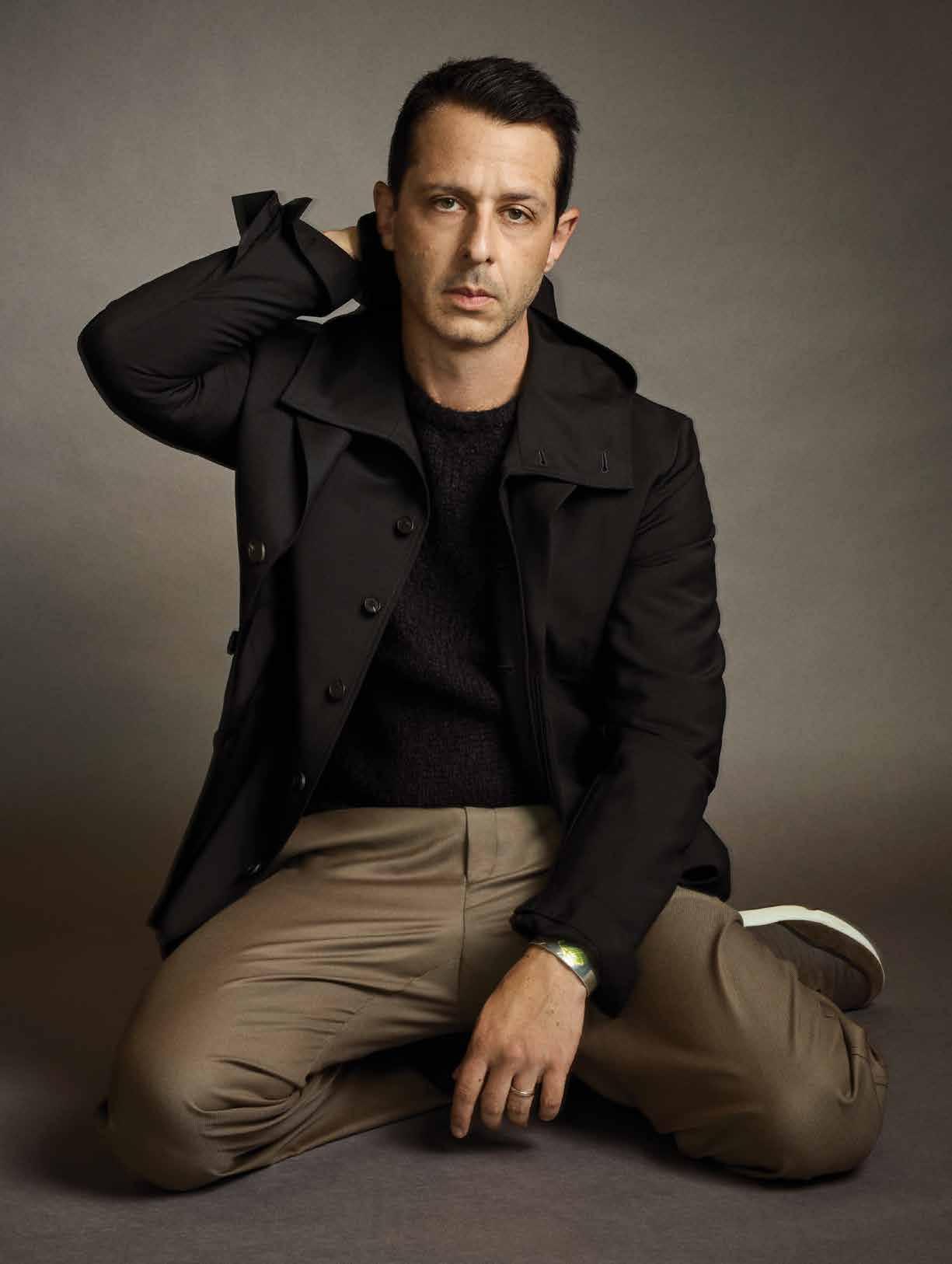
JANUARY 2023 JEREMY STRONG

Introducing the Global 8000 Fastest | Farthest | Smoothest
businessaircraft.bombardier.com

The information in this document is proprietary to Bombardier Inc. or its subsidiaries. The Global 8000 aircraft is currently under development and the design tolerances remain to be
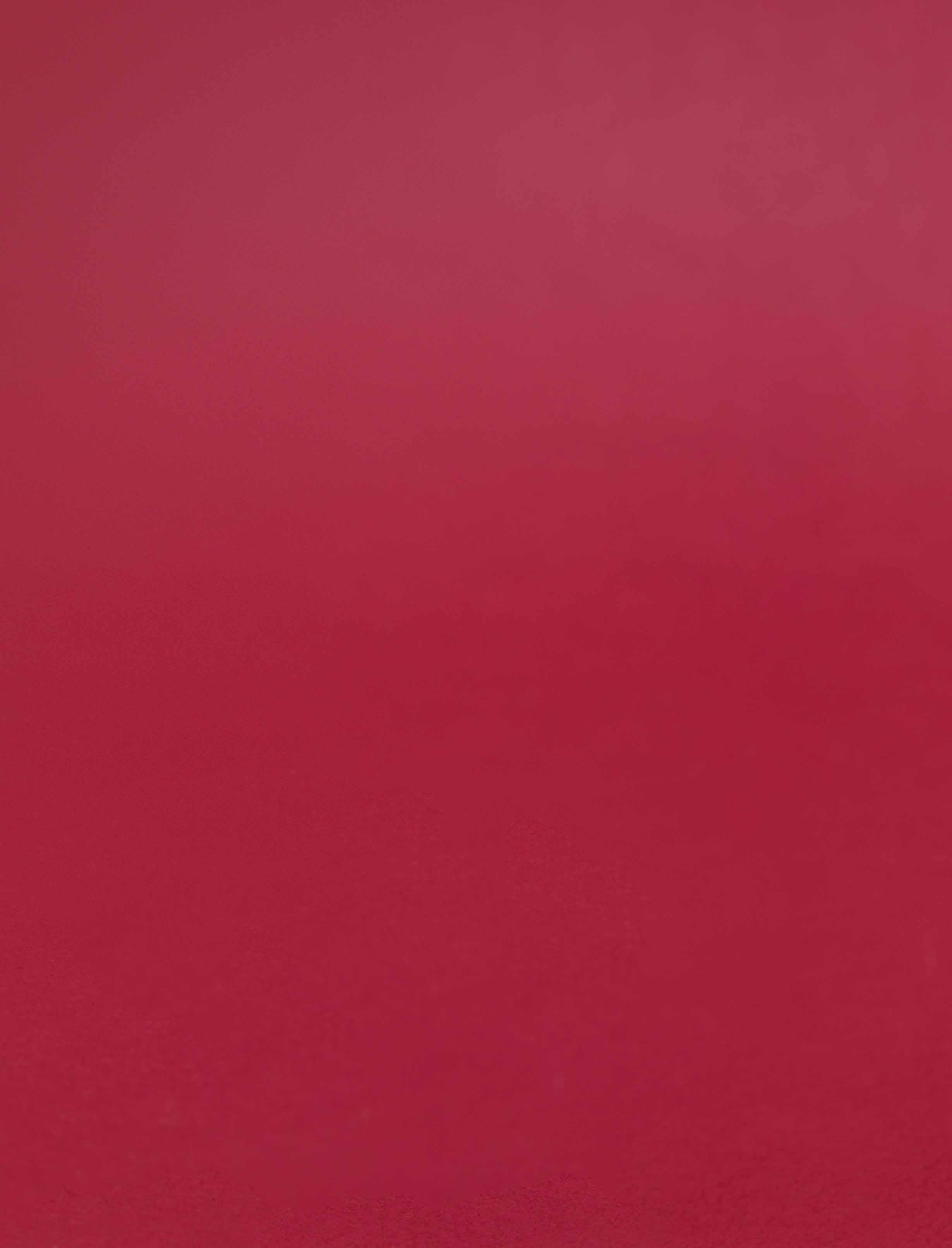
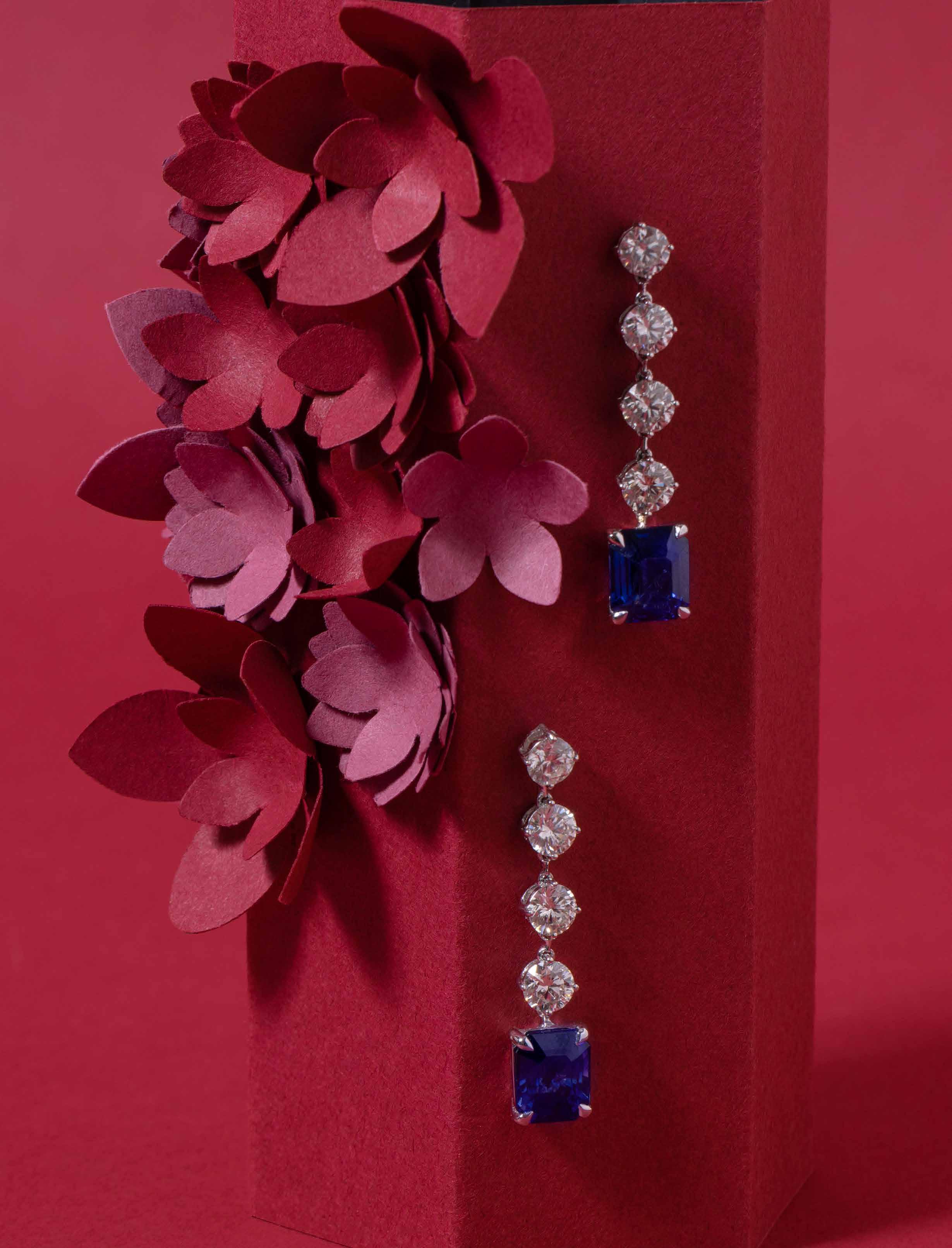
AIR
FEATURES
Thirty Two Staying Strong
Jeremy Strong found fame playing Kendall Roy in Succession — but he very nearly gave up on Hollywood.
Thirty Eight Master of the Universe
From haute couture designs to photographs and films, how the late Thierry Mugler left a legacy of immense creativity.
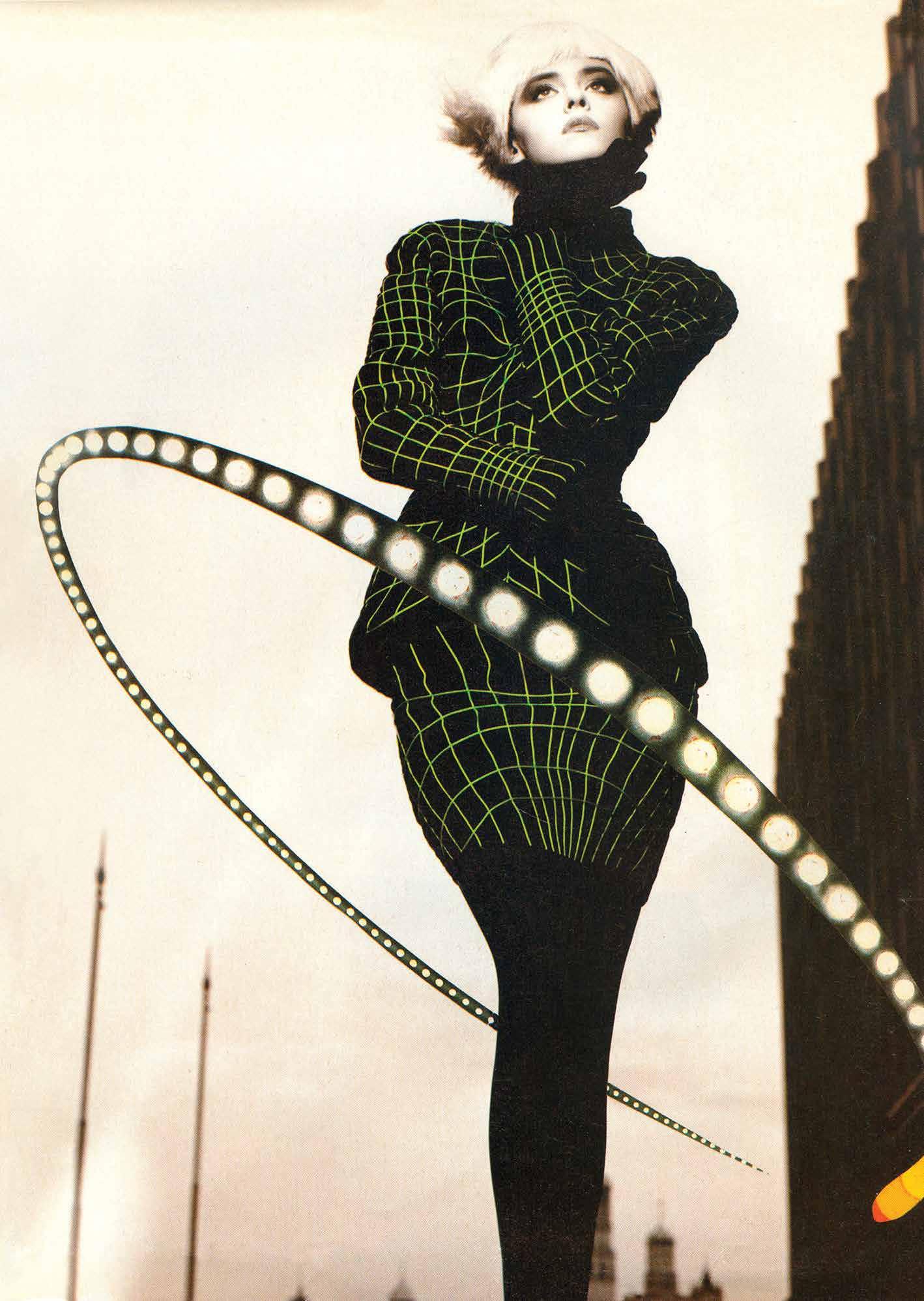
Forty Six Rebel Yell
With her serene nonconformity, who better than Nadège Vanhée-Cybulski to energise Hermès?
Contents JANUARY 2023: ISSUE 136 4
Credit: Comet Lady Blitz, September 1990. Prêt à porter Fall/Winter 1990 91 collection (“Music hall”). Velvet suit with embroidered fluorescent web design SS23
Begin the journey

For the opening of the new flagship store in Dubai Mall, discover the Akh-Ba-Ka high jewelry set and enter the odyssey of an exceptional 1 10-carat diamond
NE W MESSIKA FLAGSHIP – THE DUBAI MALL , GRAND ATRIUM
“Nestled
Biosphere Reserve,





marine










Fabio, Diving Instructor since 2009. We are Sonevians. Inspiring a lifetime of rare experiences MALDIVES | THAILAND soneva.com




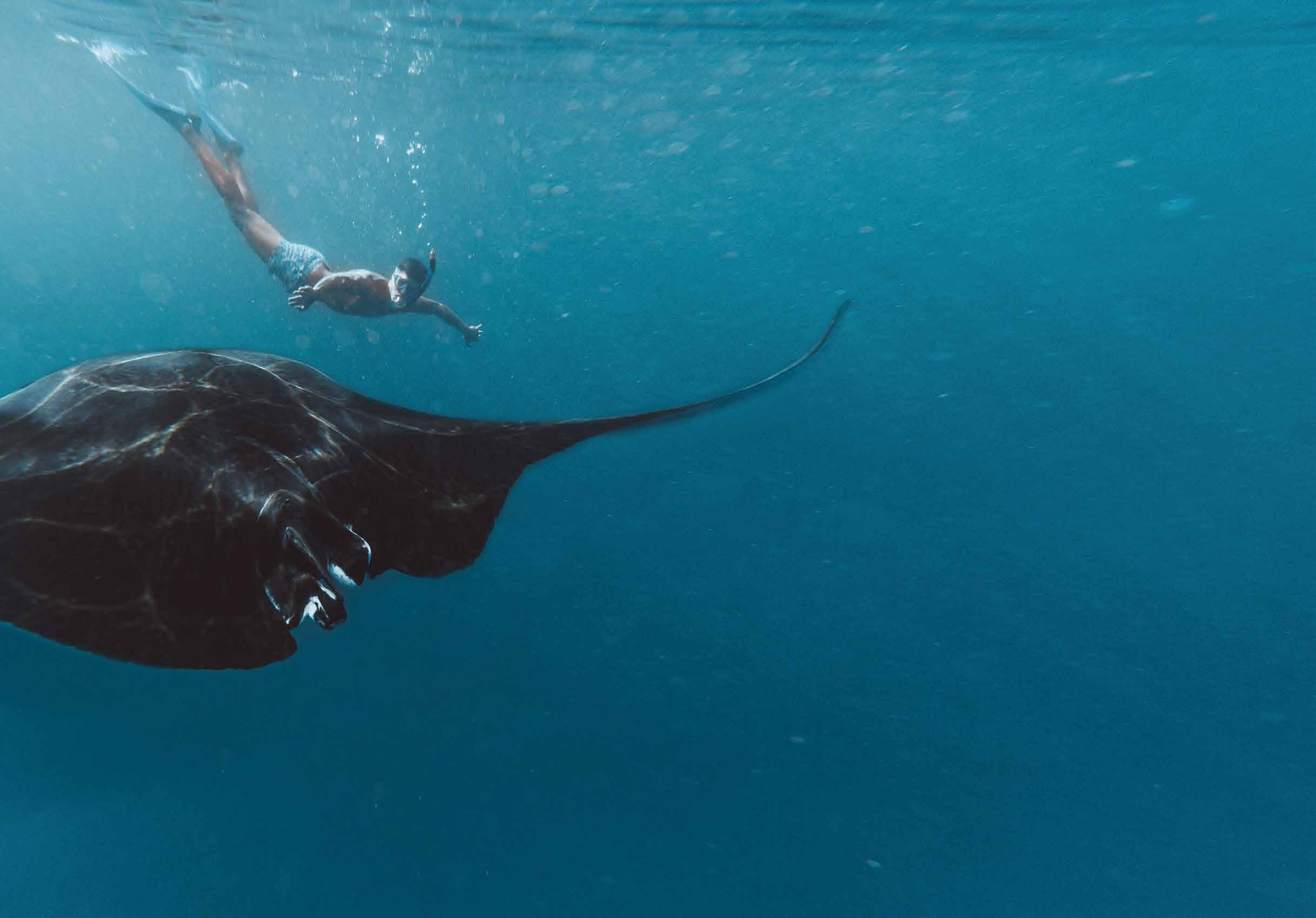
“This is the only mask I wore for two weeks.”
Maceo, Soneva Enthusiast since 2010
in the Baa Atoll UNESCO
the pristine
ecosystems around Soneva Fushi are just waiting to be explored.”
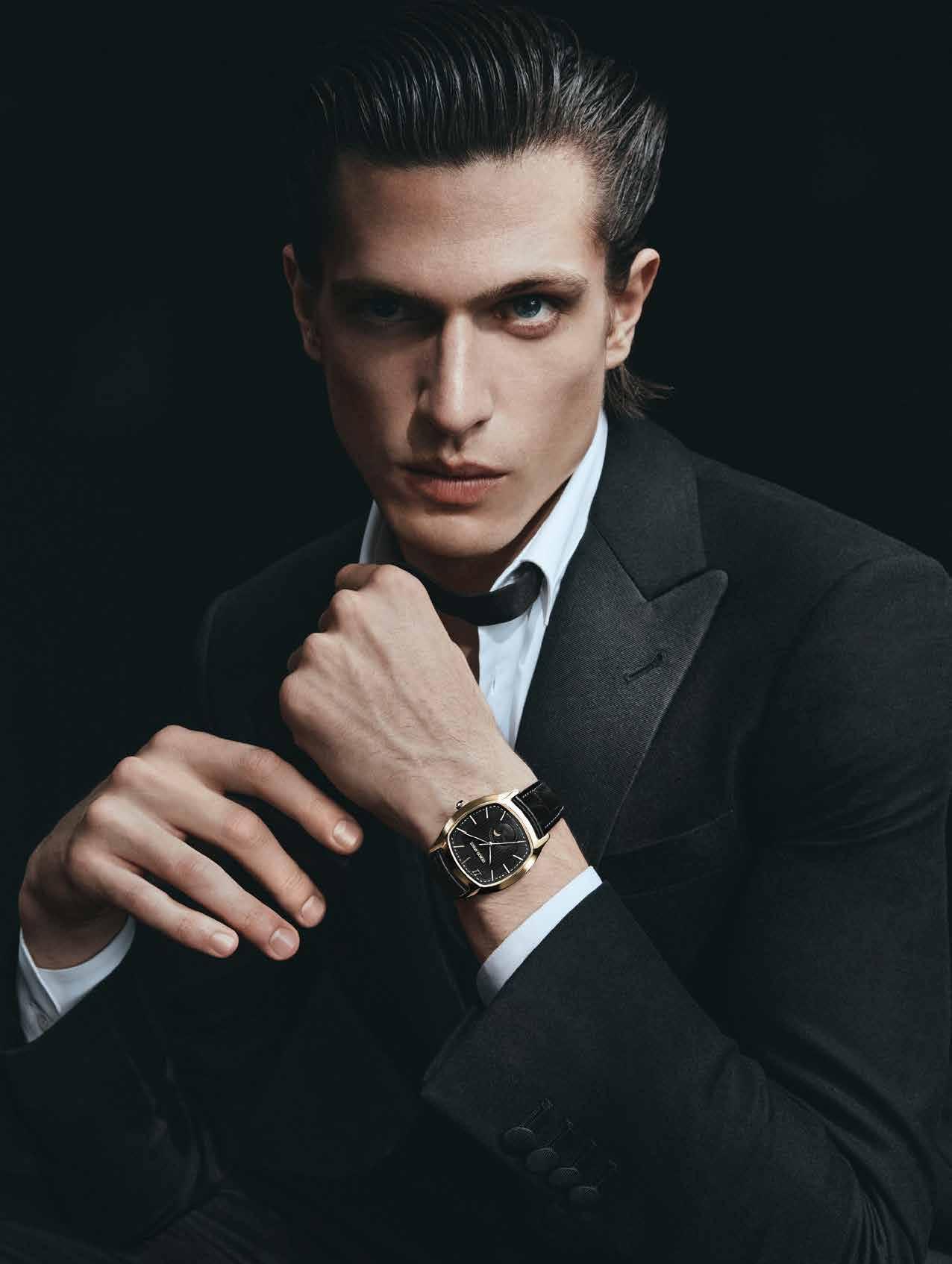
7 Contents REGULARS Fourteen Radar Sixteen Objects of Desire Eighteen Critique Twenty Art & Design Twenty Eight Jewellery Fifty Two Motoring Fifty Six Gastronomy Sixty Ultimate Stays Sixty Four What I Know Now Media City, Dubai, UAE Reproduction in whole or in part without written permission from HOT Media is strictly prohibited. HOT Media does not accept liability for any omissions or errors in AIR Twenty Four Timepieces Giorgio Armani’s elegantly minimalist dress codes move into fine horological form in a collaboration with his favourite Swiss watchmaker, Parmigiani Fleurier. EDITORIAL Editor-in-Chief & Co-owner John Thatcher john@hotmedia.me ART Art Director Kerri Bennett Illustration Leona Beth COMMERCIAL Managing Director & Co-owner Victoria Thatcher General Manager David Wade david@hotmedia.me PRODUCTION Digital Media Manager Muthu Kumar JANUARY 2023: ISSUE 136
DESERT ROMANCE
Treat your loved one to something unique and memorable at Al Maha, A Luxury Collection Desert Resort & Spa. Providing privacy and tranquility in equal measure, the Desert Romance Package includes a two-night stay in a luxurious, secluded suite with your own private, temperature-controlled swimming pool. Enjoy exclusive VIP amenities, premium sparkling beverage upon arrival, gastronomic dining experience at Al Diwaan, romantic deck dinner and a 60-minute spa treatment for both guests.

& conditions
4 832 9900 OR EMAIL RESERVATION.ALMAHA@LUXURYCOLLECTION.COM VISIT AL-MAHA.COM
*Terms
apply FOR MORE INFORMATION OR TO BOOK YOUR STAY PLEASE CALL 971
Welcome Onboard
JANUARY 2023
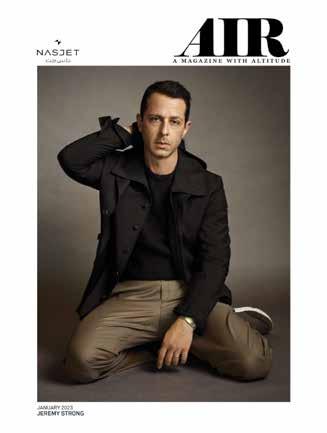
NASJET is the leading private aviation operator and services provider in Saudi Arabia that delivers world-class services in aircraft management, charter, flight support, sales, and completions. Launched in 1999 in affiliation with US partner NASJET Inc, NasJet — originally NASJET Middle East (NJME) — demonstrated the highest levels of regional expertise by being the first private company in Saudi Arabia to be awarded an Aircraft Operating Certificate (AOC) by the General Authority of Civil Aviation (GACA). The company has since grown to managing/supporting in excess of 15 fixed-wing aircraft and employing 92 in-house aviation industry experts. We operate 24/7 from a state-ofthe-art flight centre in Riyadh, Saudi Arabia, delivering superior levels of safety, service, and value.
VISION
To be the leading business aviation solutions provider in the Middle East.
MISSION
• Safety: Our clients’ and employees’ safety and security are the highest priority in all our operations and services.
• Standards: Our clients receive the utmost levels of service with world-class standards.
• Empowerment: Our employees are vital to our success and rewarded for outstanding performance and innovations.
• Profitability: We strive to ensure the full success and profitability of our organization.
• Responsibility: We pride ourselves on our work ethics and strive for the highest levels of professional standards.
VALUES
• Transparency: We are transparent with our clients and with each other.
• Efficiency: We achieve the highest levels of efficiency within our organization.
• Communication: We work as a team and communicate with each other to improve the success of our business.
Recently we have relaunched our company website to provide a more user-friendly, design-driven portal, which provides a full overview of our services and outlines the advantages of utilising them. You can visit it at nasjet.com.sa
We welcome the opportunity to serve you onboard one of our private jets.
Captain Mohammed Al Gabbas Chief Commercial Officer
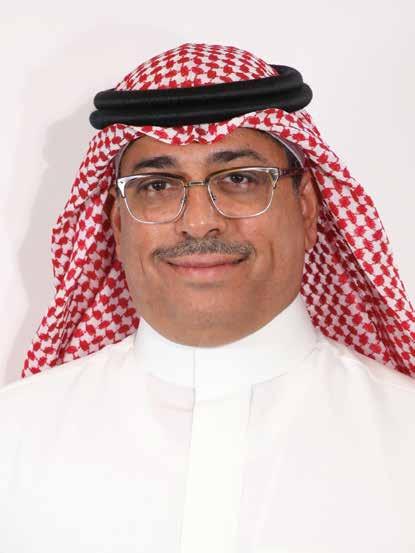
Contact Details: nasjet.com.sa / +966 11 261 1199 / sales@nasjet.com.sa

9 NasJet
JANUARY 2023
ISSUE
:
136
Cover : Jeremy Strong by David Needleman/AUGUST
Ways We Can Serve You
Full range of services cater to your every need
Aircraft Management
Owning a private jet is certainly a pleasure, but it is also a significant capital investment. We can handle that hassle and give you peace of mind knowing that an established and experienced international operator is efficiently managing your aircraft. The company has grown to managing/supporting in excess of 15 Middle East-based aircraft.

Charter
NASJET has a dedicated fleet of ultra-modern aircraft available for immediate charter, including Airbus, Gulfstream, Legacy, and Citation Excel. We are also able to source any type of aircraft in the world if our fleet does not match your preference. Your requests and personal requirements are managed by a team of highly experienced charter experts focused on making your trip exceptionally comfortable and seamless. Remember, we are looking to exceed your expectations, with our Client Service team operating 24/7, 365 days a year, to ensure we are doing just that.
For frequent charter clients, we have a number of flexible and dynamic Block-Charter programs with all the usual benefits of the on-demand charter but with additional cost savings based on volume discounts and flexible payment terms. The charter programs allow you to take control of your flying requirements on a trip-by-trip basis. At the same time, it grants you access to the largest regionally managed fleet with seamless operations and a superior level of safety, reliability, and value. For Charter Broker inquiries, please contact our 24/7 charter department at +966 11 261 1199 or email charter@flynas.com.
Flight Support-Aircraft Owners
Aircraft owners managing an aircraft internally can still benefit from NASJET's unrivaled level of international support and significant
'economy of scale' cost-saving benefits. The NASJET Flight Center, Client Service, Charter Team, and Engineering Teams operate 24/7, supporting owners with flight planning, overnight & landing permits, ground handling, fuel management, accommodation, catering, aircraft insurance, maintenance, and evaluations. NASJET will provide aircraft owners with 'back-up' aircraft at attractive prices when their aircraft is unavailable. The core management fleet includes Airbus, Boeing, Bombardier, Cessna, Dassault, Embraer, and Gulfstream aircraft.
Aircraft Sales
As a world-class owner, operator, and manager of corporate aircraft, we are in a unique position to understand the many advantages and disadvantages of aircraft ownership. We offer real-time pricing analysis, aircraft financing at preferential rates, aircraft inspections, sales/ marketing collateral, and assertive price negotiations. Close ties with the leading business aircraft manufacturers, operators, and international sales brokers further ensure the information presented is accurate and timely. Dedicated teams are able to handle legal and administrative documentation, including registration and licensing, as well as scouring the market to present you with the widest
possible choice of aircraft. We have the required experience to enter into negotiations on any aircraft model, and together with marketing and advertising experts, we can help you buy or sell your aircraft with cost efficiency and the utmost discretion. With NASJET, you can be assured that your aircraft sale or purchase is being managed by aviation experts.
Completions Advisory
If you are planning to purchase a new 'green' aircraft or refurbish your current aircraft, we have the capability and wealth of experience to ensure the completion and delivery of the aircraft is to the highest standard, protecting the future residual value of your aircraft. NASJET and appointed partners provide advice on the design, selection, and installation of the cabin configuration, layout, type of seats, carpets, sidewall treatments, and other furnishings, entertainment and communication systems, galley, and lavatory fixtures, avionics packages, exterior paint, and extended warranty programs. Operating business aircraft in extremely hot and humid climates can mean the finishing and preparation of materials must be of a specific requirement. Capitalising on our regional knowledge as an operator of over 15 fixed-wing aircraft with hundreds of thousands of miles flown across every continent in the world, we guarantee your aircraft will be finished to the optimum standard.
10 NasJet
JANUARY 2023: ISSUE 136

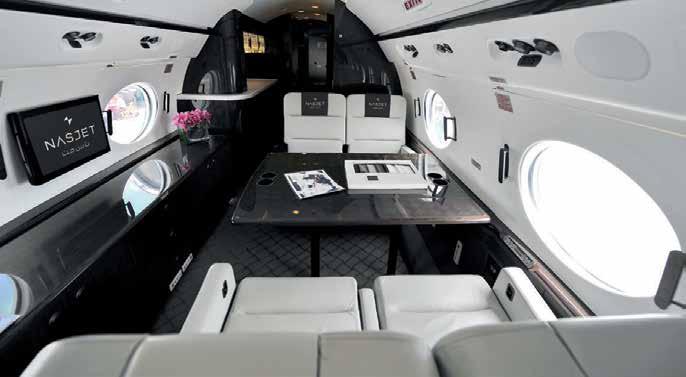
Introducing Our Fleet
Over 19 fixed-wing aircraft are under our management
Airbus Corporate Jet (ACJ) A318
In NASJET, we have two types of Airbus A318, an aircraft that combines Airbus reliability and intercontinental performance.
Airbus A320neo
Airbus A320neo is distinguished by its innovative technologies and the spaciousness of its cabin — the widest in the single-aisle aircraft category. The aircraft is equipped with a new generation of engines that contribute to a 15% cutback in fuel consumption and harmful emissions and a 50% reduction in noise level.
Boeing (B767) and Boeing (BBJ3)
Boeing Business Jets bring the best of private air travel, offering customers a wide range of Boeing products. The robust characteristics of this aircraft also provide an excellent value proposition
when outfitted for more personalised space, unmatched reliability, and worldwide support.
Gulfstream (G450) and Gulfstream (GIV-SP)
NASJET is the longest-standing Gulfstream operator in the Middle East. You can fly in a spacious and comfortable cabin, which includes a full-service galley to serve your favourite meals.

Embraer Legacy 600 and Legacy 650
The NASJET Legacy 600 has installed an Ionization System that eliminates 99.9% of all microbes, bacteria, germs, bad smells, etc., in the cabin air during flight. This Legacy 600 is the first and only business jet to have this system installed during the Covid-19 pandemic and will significantly reduce the virus's spread within the cabin air.
Cessna Citation Excel
The Citation Excel aircraft combines transcontinental range and remarkable efficiency in a beautiful mid-size jet. The cabin offers a comfortable room and a spacious interior. The high-quality leather seats are extra wide with full reclining capabilities for optimal comfort.
Bombardier Challenger 850
The Challenger 850 aircraft is considered a mid-range aircraft which offers a spacious cabin and a large baggage area.
Dassault Falcon 900B
The Falcon 900B aircraft is one of the quietest three engine aircraft with an excellent transcontinental range and the ability to carry a greater number of passengers.
NasJet 12
JANUARY 2023: ISSUE 136
We are also able to source any type of aircraft in the world if our fleet does not match your preference

The National Museum of Saudi Arabia in Riyadh will from this month play host to a remarkable exhibition showcasing the extraordinary creations of Van Cleef & Arpels, dating to its founding in 1906. Curated by Alba Cappellieri, Professor of Jewellery Design at Milan Polytechnic University and President of the Milano Fashion Institute, on show will be 280 items of jewellery, treasured timepieces and precious objects that truly reflect the innovation and artistry that underpin the maison’s high jewellery. Van Cleef & Arpels: Time, Nature, Love will show at The National Museum of Saudi Arabia, Riyadh from January 18-April 15
14
Radar JANUARY 2023: ISSUE 136
AIR


15
OBJECTS OF DESIRE
Master craftsmanship, effortless style and timeless appeal; this month’s must-haves and collectibles
OBJECTS OF DESIRE
OBJECTS OF DESIRE
DOLCE&GABBANA CRUISE 2023
The colour red can be interpreted to mean many things – power and passion, sensuality and seduction, ferocity and fire – and in the Dolce&Gabbana universe it can be construed as all of these things at the very same time. Red runs through
the brand’s 2023 Cruise collection, punctuated only by touches of black, and it takes a turn for the daring on items like reworked bustiers, sheath dresses, and leopard print jumpsuits, shapes selected to emphasise the beauty of the body.

1
DAVID MORRIS LE JARDIN
David Morris may well have celebrated 60 years as the self-styled London Jeweller last year, but its creative spark continues to ignite the world of high jewellery. The Le Jardin collection takes its design cues from long summer days – diamond
butterflies, colourful floral blooms and childhood memories are all reference points, with the latter informing this spectacular Wildflower necklace; the pear shape and marquise diamonds designed to evoke thoughts of plucking petals from a daisy.

2
OBJECTS OF DESIRE
OBJECTS OF DESIRE
VHERNIER OLIMPIA
Vhernier is one of those brands whose visually rich pieces remain distinctive and easily recognisable yet always fresh and inventive. That’s particularly true of the Olimpia collection, a set comprising a necklace, bracelet (both with a
hidden clasp), earrings and a new ring, for which three links embrace each other in a delicate undulating movement. The collection is available in rose gold, white gold with diamonds, or in full pavé of white or black diamonds set on white gold.
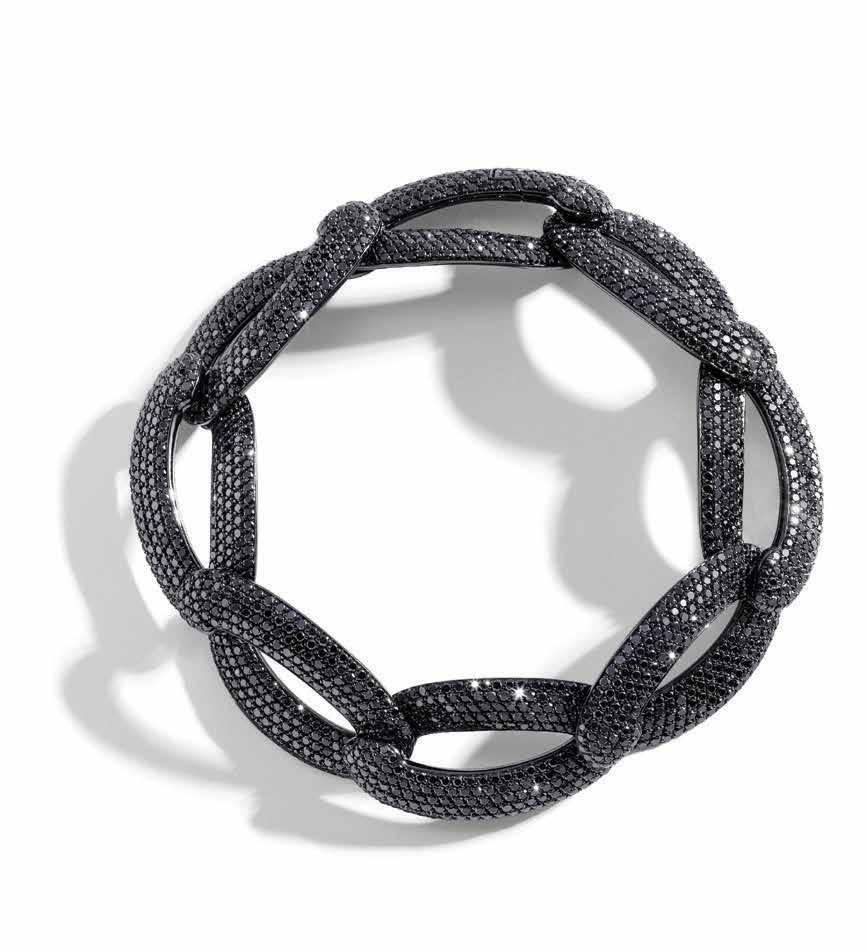
3
OBJECTS OF DESIRE
GIVENCHY X (B).STROY SPRING 2023 CAPSULE
Givenchy’s Creative Director Matthew M. Williams has never been one to shy away from making a style statement and for this capsule collection he has found like minds in Brick Owens and Dieter Grams, the duo behind the New York-based underground label
(b).STROY. Innovative materials and distressed effects are key features of a collection of clothing and accessories that includes limited-edition variations on the Antigona soft and, for men, a G-Zip backpack with a new interpretation of the Givenchy emblem.
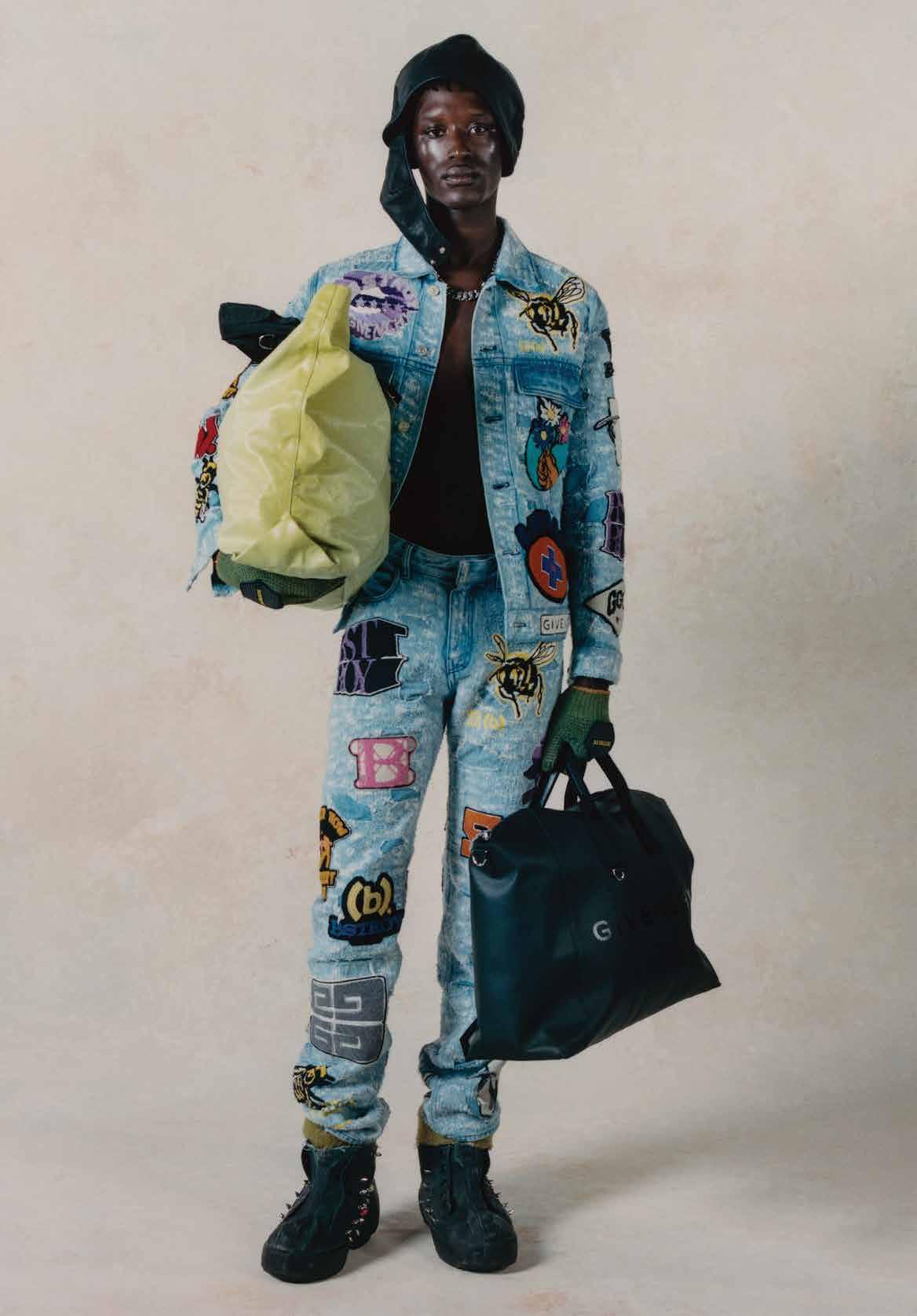
4
OBJECTS OF DESIRE
BERLUTI DRAPÉ
To create the unique pattern that adorns Berluti’s new Drapé drop – the first since last summer – the brand’s classic Venezia leather is carefully folded and enveloped diagonally onto itself. When the chocolate-hued patina is applied and seeps into the folds, it
subsequently creates a sense of depth, giving each item in the collection a unique look. Alongside briefcases, totes, and pouches is a range of footwear for which Berluti is famed, with these low-cut boots the pick of them.
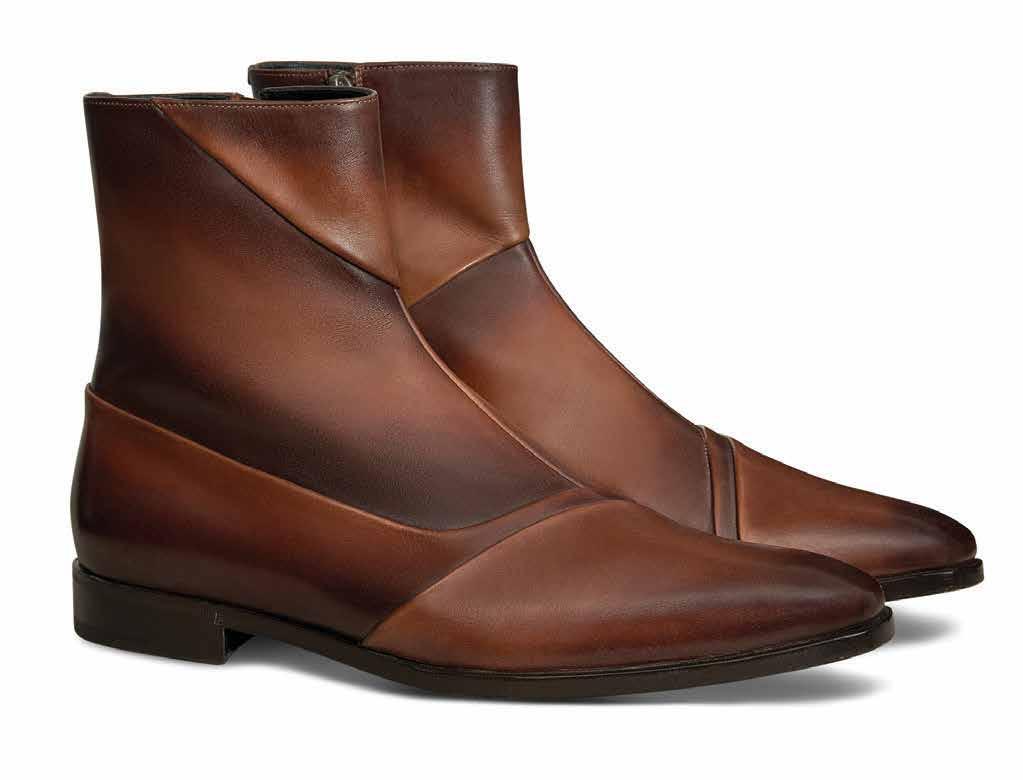
5
OBJECTS OF DESIRE OBJECTS OF DESIRE
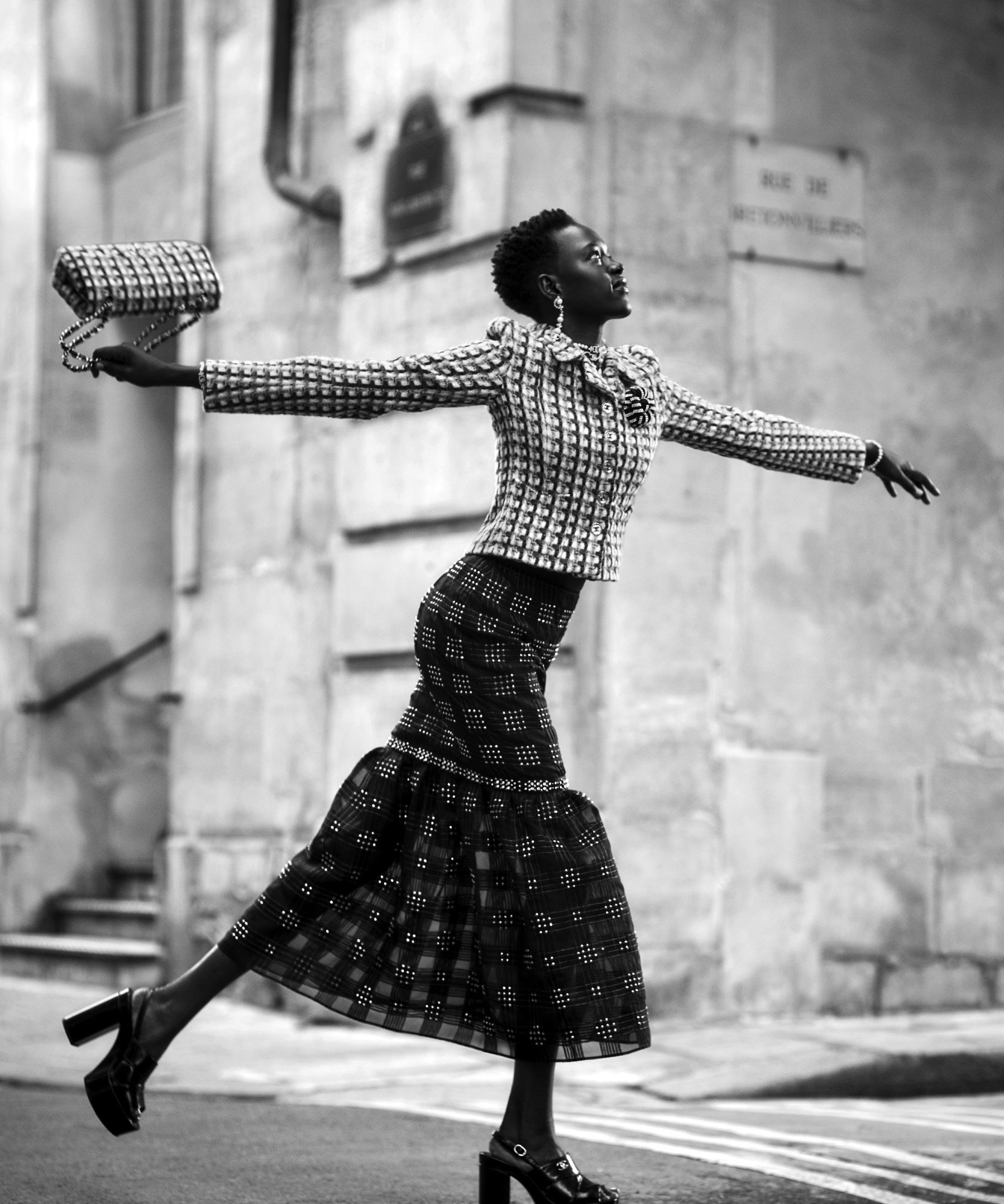
6 6
OBJECTS OF DESIRE
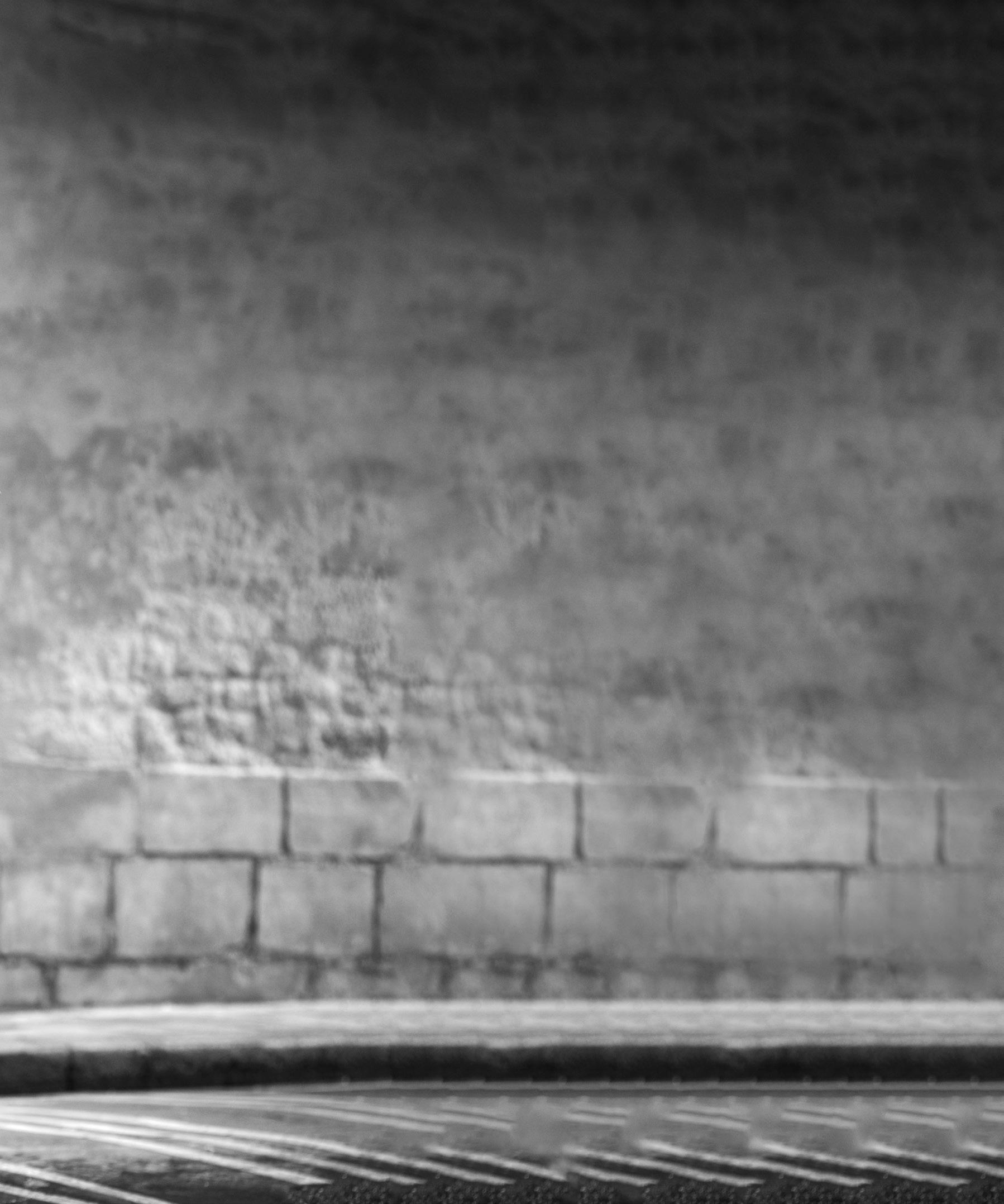
CHANEL 2022/23 METIERS D’ART
For the first time in its history, Chanel hosted a runway show in West Africa, a moment to mark for the brand but also one of particular note for style in Senegal, whose energetic capital city of Dakar is at the heart of the country’s thriving fashion industry. As ever,

7
the Métiers d’Art collection – shot by Senegalese photographer Malick Bodian – is a masterful celebration of the unique talents under Chanel’s umbrella: embroidery by Montex, Lesage tweed, pleating by Lognon, and florals by flowermaker Lemarié.
CHRISTIAN LOUBOUTIN DADDY POOL SLIDE

If you must go toes-on-show (unsightly as they are) then you need footwear that will at least draw attention to the rest of the foot. And when it comes to footwear that draws attention, only Christian Louboutin cuts the mustard. All but
guaranteed to take the eye, these extrapadded chunky Daddy Pool slides come with decorative metal spikes inserted into their straps and a thick rubber outsole for comfort – just don’t be tempted to wear them anywhere but poolside.
8
OBJECTS OF DESIRE
OBJECTS OF DESIRE
Critique
Film
The Offering
Dir. Oliver Park
A horror flick in which an ancient evil with sinister aspirations lurks beneath a family-run funeral parlour.
AT BEST: “Interweaves character information and subtly obscured plot points to create a heady atmosphere.” — Jennie Kermode , Eye for Film
AT WORST: “Disappointing when looking at the genre possibilities, at least it entertains on a surface level.” — Peter Gray, This is Film
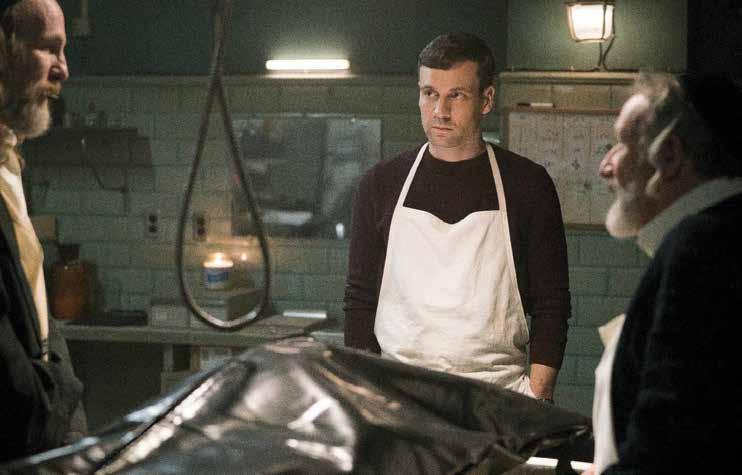
When You Finish Saving The World
Dir. Jesse Eisenberg
A mother and son whose characters seem at odds prove more alike than either would care to admit in this comedy drama.
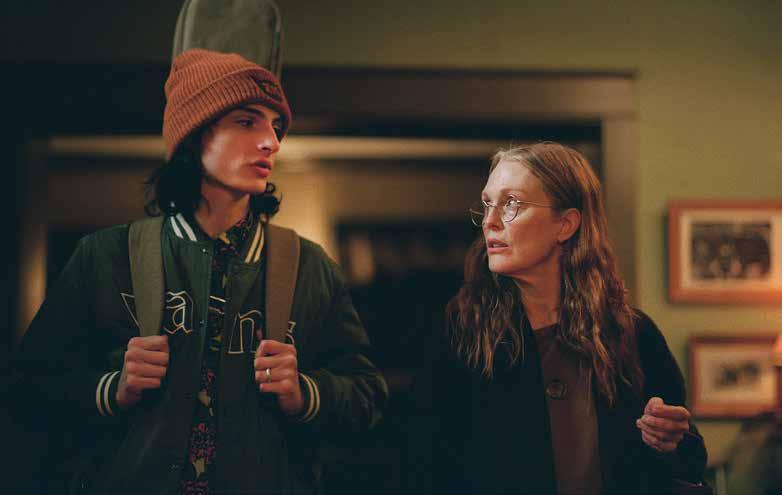
AT BEST: “Family drama takes a turn left in this biting satire.” — Dwight Brown, National Newspaper Publishers Association
AT WORST: “One of Sundance’s buzziest titles is also one of its worst.” — Drew Gregory, Autostraddle
Blaze Dir. Kathryn Barton
Rendered catatonic with shock after witnessing a violent crime, a young girl enters a world of her own imagination.

AT BEST: “A heartbreaking and visually stunning exploration of trauma.” — Sharai Bohannon, Dread Central
AT WORST: “Lacks the narrative skills that make a movie more than a series of disjointed episodes.” — John McDonald, Australian Financial Review
Joyride Dir. Emer Reynolds
A complicated middle-aged mother and a troubled adolescent meet and embark on a trip across Ireland when the latter steals a taxi.
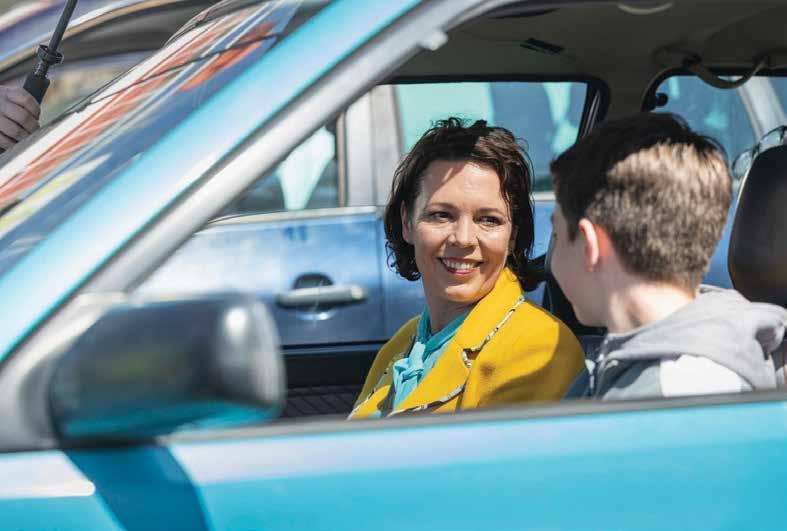
AT BEST: “It’s a wacky, lark-filled road movie that’s ‘feelgood’ to its core. Until it’s not.” — Kevin Maher, The Times
AT WORST: “A quirky little flick that never seems to reach its destination.” — Alan Corr. RTÉ
18
AIR
JANUARY 2023 : ISSUE 136
Critique Books
They may not be the most obvious of bedfellows — separated by class, race and centuries — but Charles Dickens and Prince have a lot that link them, argues best-selling author Nick Hornby in Dickens and Prince. Not least that, in his opinion, both artists “lit up the world.” Says Vogue in its review: “An ardent fan letter from Hornby that makes you want to re-read Great Expectations while listening to Sign o’ the Times. This slim, companionable volume combines biography — Dickens’s impoverished childhood, Prince’s bruising battle with his record label — as it champions the creative impulse to always make more: more novels, more songs. A love letter to maximalism.” Publisher’s Weekly was equally enthused. “Hornby’s admiration for his subjects is infectious… a zesty tribute to two cultural legends not often spoken about in the same breath.”
As was The Times: “Smart, witty and weirdly convincing… Pop culture is
political to Hornby. Beneath this latest book’s stocking-filler-light surface, you can sense a subtle sort of crusade. By pairing these two artists, he’s making a couple of implicit assertions — that Prince is as important as Dickens and that Dickens is as fun as Prince.”
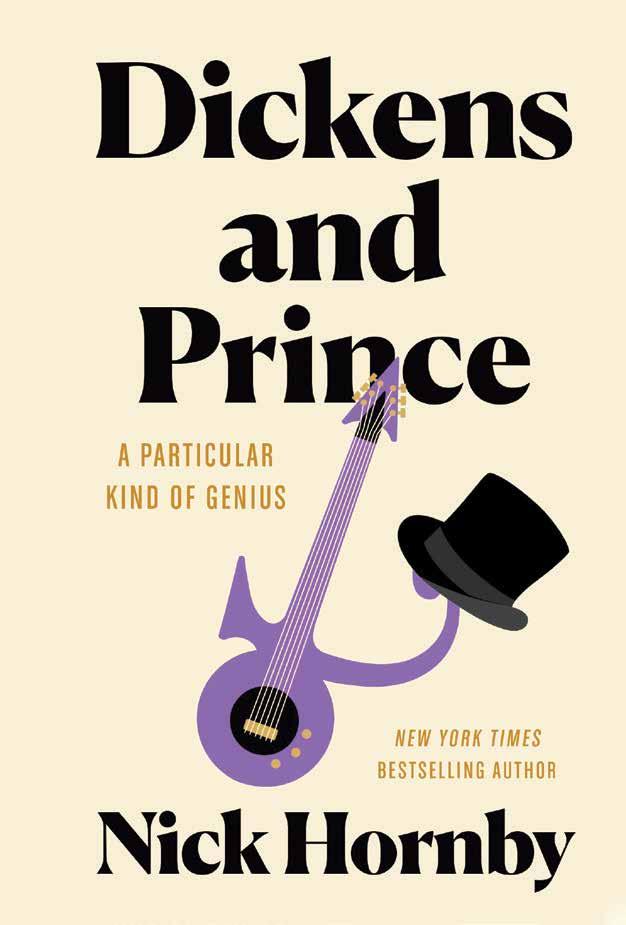
James Bond eat your heart out. Dusko Popov was a real life double agent for the Abwehr, MI5, MI6, and the FBI during World War II, all while maintaining his cover as a Yugoslavian diplomat.
Larry Loftis tells his fascinating story in Into The Lion’s Mouth. “One of the most fascinating things I’ve ever read, period. Gripping, thrilling, and too crazy to be true — except that it is. Reads less like a biography and more like a thriller,” says The Real Book Spy.

“Who needs fiction?” asks, bestselling author Steve Berry. “Truth is a thousand times better, and this true-life adventure has it all. Action, history, secrets, conspiracies — a sizzling piece of entertainment that’s real.”
The book also found favour with retired acting CIA Director Michael Morell. “A sensational book, telling a remarkable true story that few know, even those in the intelligence business. Written in the style of the best spy thrillers, the book is impossible to put down. A must read.”
Out There by Kate Folk is a collection of stories that hold a mirror to our subconscious fears and desires. “Out There originally ran in the New Yorker and was something of a viral sensation,” writes the Los Angeles Times. “Fans of the story won’t be disappointed by the collection, which also explores a gendered territory somewhere in the borderlands of magical realism, weird horror, sci-fi and literary fiction about jaded relationships.” Says the Chicago Review of Books: “Folk’s ample imagination ably offers a perfect encapsulation of our modern madnesses, like an Alice’s looking glass for our social media-obsessed age.”
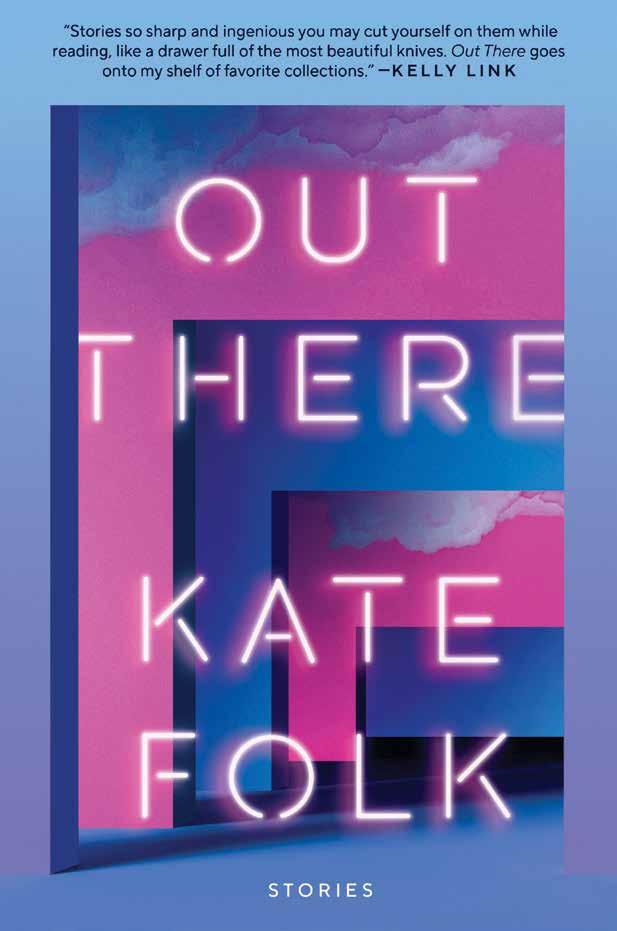
19
JANUARY 2023 : ISSUE 136
AIR
Robot Rock
In the latest artistic adventure, Philip Colbert presents the art-making data-driven robot
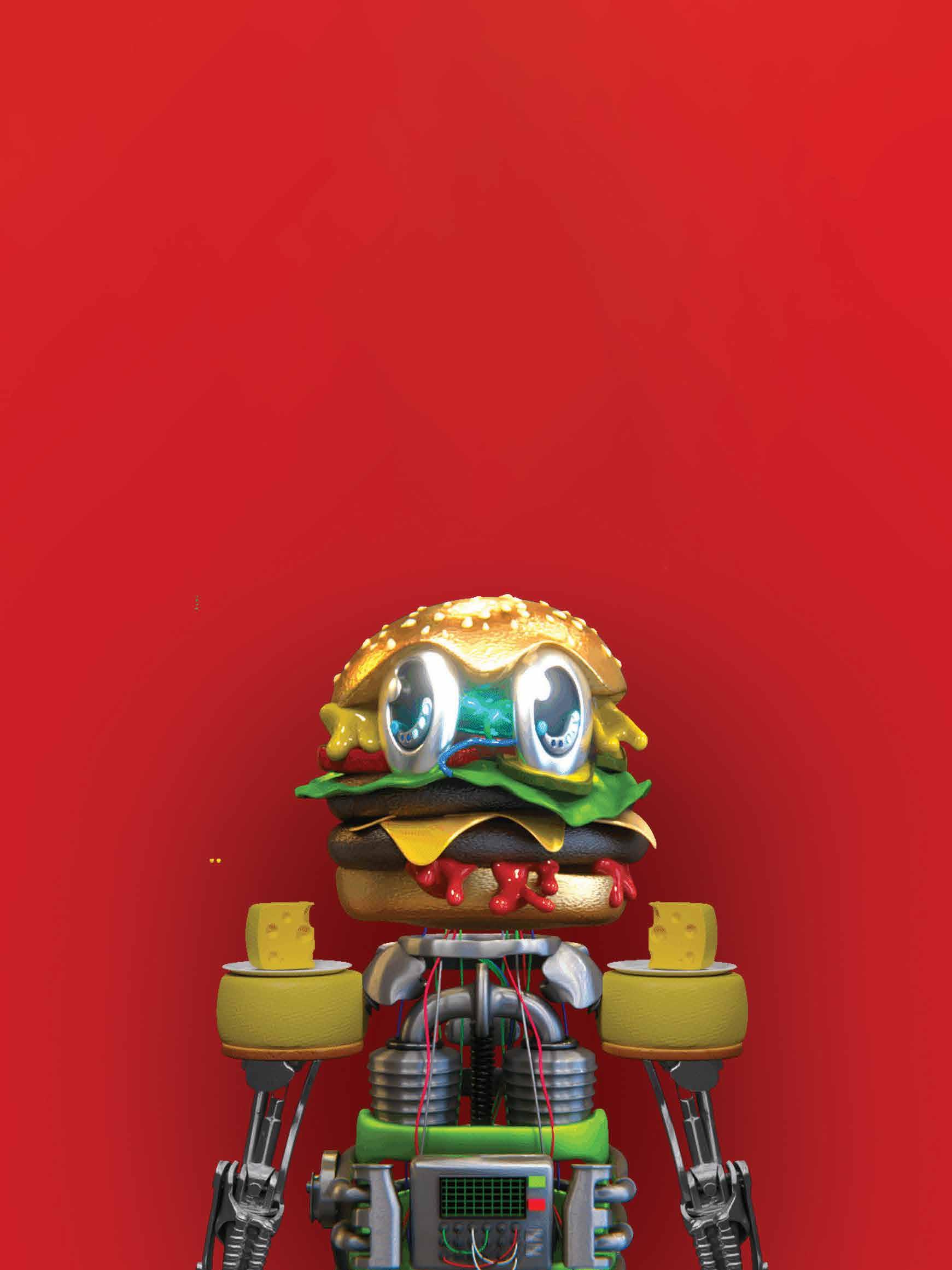
WORDS: CARU SANDERS
JANUARY 2023: ISSUE 136 Art & Design
20

21
In the last couple of years, Philip Colbert has extended the frontiers of his hyper pop world. His practice has been described as a conversation with his pop idols, incorporates performance and installation, and now even robotic devices as part of his visual language.

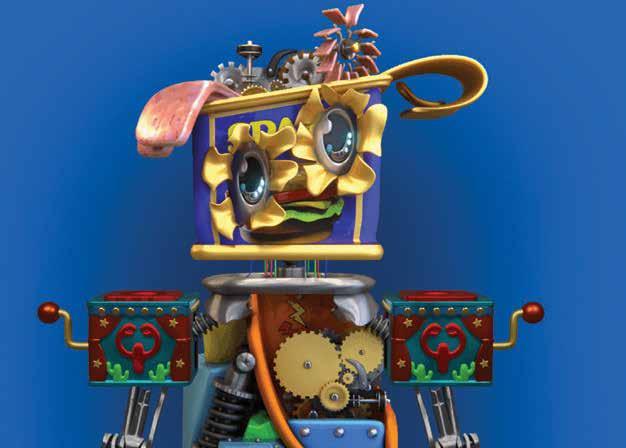
His work and his world, from furniture to paintings, has seen him referred to as the ‘Godson of Andy Warhol’ (by the late and legendary Andre Leon Talley) and won him the endorsement of artworld heavyweights Charles Saatchi and David Hockney. As to what marks him out from so many other contemporary artists, Colbert is ever on the front foot, always with a quicksilver response to the geopolitical climate tucked up his colourful sleeve.
In 2020, The Saatchi Gallery invited Colbert to take over the museum during
the autumn of 2020. Arranged prior to lockdown restrictions, the savvy Scotsman (Colbert grew-up in Perth) came up with an idea to Covid-proof his show, Lobsteropolis. While installing the exhibition of paintings and sculpture, he hatched a contingency plan of using telepresent robots, which users could connect to from their device at home to move around the gallery.
This troupe of robotic lobsters went wheeling around the Saatchi Gallery, comprising the world’s first private view of a gallery conducted hy a robot. It was a much upgraded, practical twist on what many of the other art institutions were offering in lieu of a physical gallery visit. When the public realised they could visit the Saatchi Gallery in this virtual but exciting way, interest grew rapidly among art enthusiasts, with the show going on
22
AIR
‘ Colbert’s data-driven robot produces digital artworks via artificial intelligencey’
to prove so successful that Colbert was invited to stay for a six-month run.
In the two years since Lobsteropolis opened, Colbert was offered museum shows all over the world. Last April, the artist stole the show at the Venice Biennale when floating one of his signature lobsters eighteen miles down the canal to highlight what the artist calls, “the precarious state of the natural world and the need to recognise its fragility.”
Colbert then whirled through several more cities and museum shows with the world-renowned art dealer Pearl Lam. In Rome, until January 8, you’ll see his lobsters placed all over the city, next to classical ruins and early Christian places of worship.
When he returned from his travels, still buoyed by the success of Lobsteropolis, thirsty for more, and sure this field of generative art would swiftly gather pace, Colbert knew that his next strategic move wouldn’t be in art or design but in tech.
To help him realise his vision of merging the virtual and physical worlds, and convinced of the exciting new role robotics could play in the art world, he reached out to the robotics lab of University College London.
Together they built a team with expertise in different fields, comprising AI experts, robotics practitioners and designers. Their task was to create a telepresent robot with a developed AI brain, and soon the so-called LobstarBot was all fired-up and ready to go.

Last month, Colbert unveiled his newest creation in a window display at worldrenowned auction house Phillips. As the audience gathered, the data-driven LobstarBot produced digital artworks via artificial intelligence, Colbert’s work having been fed to the robot through a machine-learning algorithm that generates visual associations as it learns, looking at information like a human being.
The LobstarBot is both the performer and the performance, with the live production of these unique artworks available to purchase as an NFT. Those who purchase the NFT then participate with the LobstarBot to produce their own artwork, using a smartphone, tablet or computer.

All of the art produced by LobstarBot will be on public display at an exhibition to be held later this year, after which
holders can claim their physical artwork.
From stunning immersive murals and urban landscapes, to abstract pieces and epic collaborative artworks, robot-created imagery is taking the worlds of art and technology by storm.
Colbert has come-up with a neo-pop surrealism and tech combo that allows the user to interact with the digital and the physical and, in doing so, he continues to cheekily glide across the zeitgeist, always that one-step ahead of the curve.
23
AIR
Tailored To Perfection
Giorgio Armani’s elegantly minimalist dress codes move into fine horological form in a collaboration with his favourite Swiss watchmaker
 WORDS: STEPHEN DOIG
WORDS: STEPHEN DOIG
24
The quaint ideal of a Swiss watch factory — ancient artisans whittling as cuckoo clocks chime — often clashes with the rather industrial reality. These days factories tend to be state-of-the-art, and set inside a modernist block beside a six-lane motorway. Which is why the set-up at Parmigiani Fleurier is so pleasing. The town of Fleurier is set in a Christmas-card valley of fairytale forests and craggy rock faces. Wooden chalets dot the landscape, and in the heart of the village a boulangerie offers plump baguettes. There’s even an absinthe shop for those with retro decadent tastes. The Parmigiani HQ is in a handsome 19th-century manor house tucked behind wrought iron gates. It looks like the home of a grand old business, yet Parmigiani is only 26 years old, a newbie in the centuries-old watchmaking world. The brand, however, which makes
just 2,500 watches a year, has swiftly become the connoisseurs’ go-to. And one of its notable fans is Giorgio Armani. The billionaire Italian designer started collecting Parmigiani watches 20 years ago. He recently decided to make the relationship official with a collection of timepieces designed jointly by the boffins of Parmigiani and the tastemaker of Milan. Astonishingly, given that the 88-year-old has turned his aesthete’s eye to everything from couture to yachts, this is his first foray into fine watchmaking.

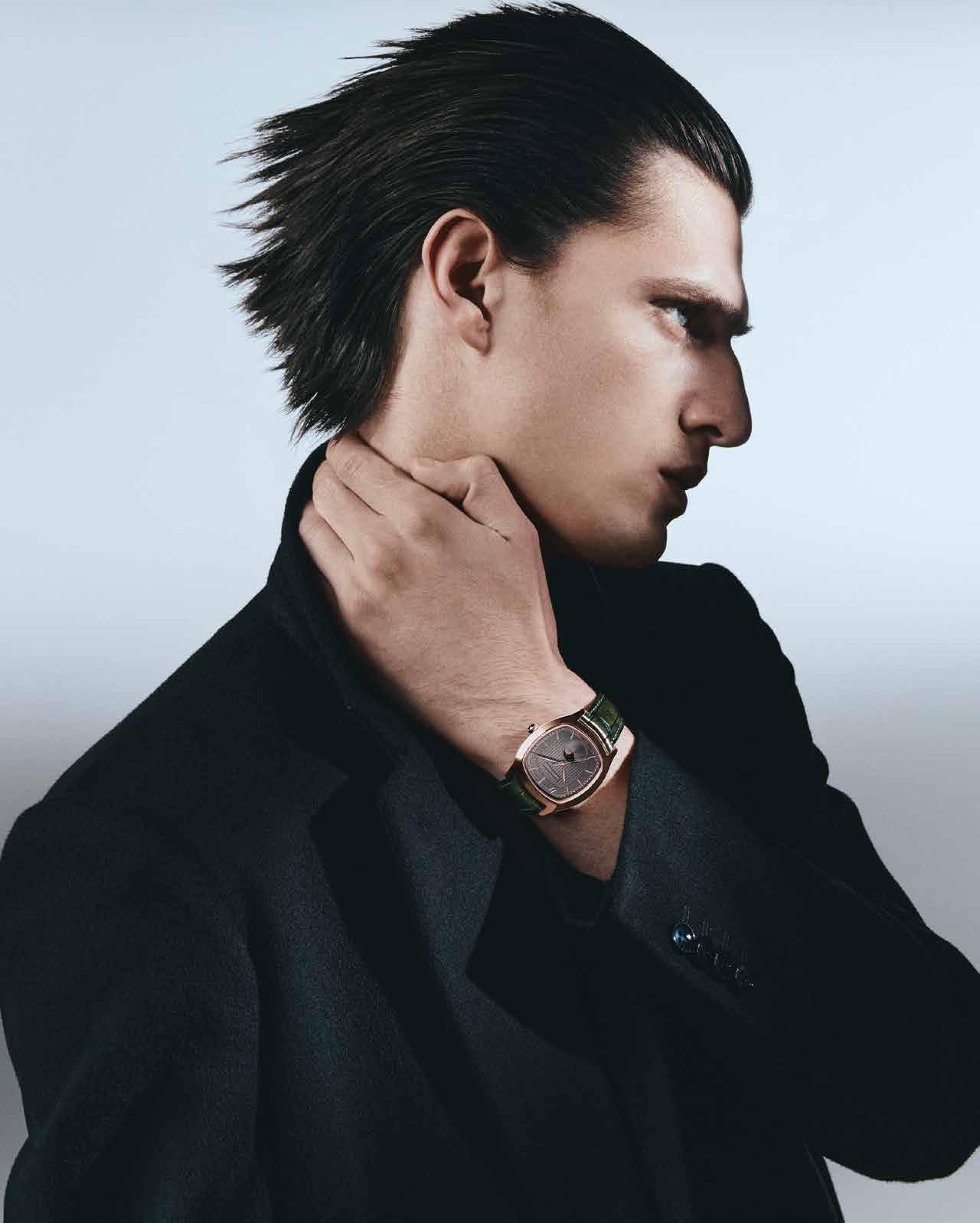
“The collaboration with Parmigiani Fleurier happened naturally,” explains Mr Armani, who broached the idea with its CEO Guido Terreni two years ago. “We share a passion for perfection and the pursuit of beauty. This series of watches is made up of precise lines and exquisite materials. An object that expresses aesthetic excellence, quality and craftsmanship

Timepieces JANUARY 2023: ISSUE 136 25
is meant to last for ever.” Armani’s is a pared-back, minimalist aesthetic, while Parmigiani’s signature is bold gold, character and a wealth of complications. But the series of watches that evolved from those initial conversations are a meeting point of the two: cushion dials in rose and yellow golds now sit alongside dials in anthracite grey.
The finer details, too, point to a marriage of horology and high fashion; one of the dials features a guilloché technique evoking the pleats and ruching that are Armani’s signature, while the precious metal ‘darts’ that line the dial suggest stitches, and the hour hand is finely tapered like a needle. “It’s these little touches that make it so different,” says Parmigiani master trainer Christie Girel. “You might not notice at first, but take some time over the little details and it’s clear it’s something special.”
The name of the watch, Giorgio Armani 11, is from Armani’s home at 11 Via Borgonuovo, Milan, where he founded his house in 1975. Pleasingly, the Parmigiani HQ has been at 11 Rue du Temple in Fleurier since 1996. “It was really about getting the alchemy between the two houses right,” says Michel Parmigiani, founder of the watchmaker. (That he still helms the house, at 72, is an indication of how special it is; most watch brands were founded centuries ago and are owned by conglomerates. Parmigiani founded his in 1996, four years later selling a majority share to close friends the Sandoz family, who had made their name in pharmaceuticals, to secure its future.)
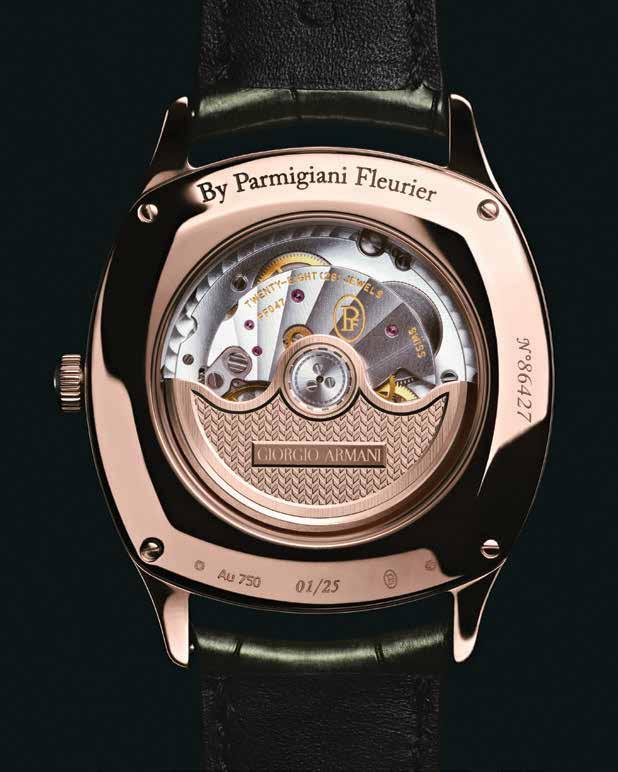
“They’re different in their art but identical in their requirements,
and it came about through a lot of exchanges, meticulousness and detail. We put our mechanical expertise in haute horlogerie at the services of Mr Armani, to create a watch made entirely by hand.”
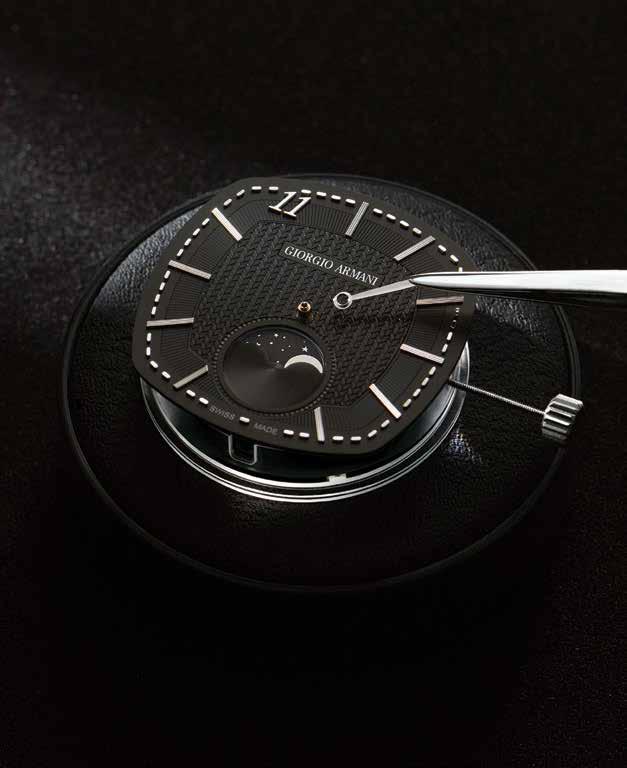
While the various skills that go into the components of a Parmigiani watch — the cases, straps and detailing on the dial — are housed across the Jura Valley (the historic centre of Swiss watchmaking), the heart of the operation is in Fleurier, in the capable hands of Girel, a watchmaker for 24 years. It took her four years of training to learn the techniques to bring the watches into being, and it’s her responsibility to house the movement and dial within the case to a level of precision that clients expect when they pay up to six figures for a watch. Assembling the movement can take several hours, as some of the 200plus components are no bigger than a speck; she works with a microscope pressed to her goggles. Even a sigh could send tiny cogs rolling across the room, so a calm temperament is key. Dust is the enemy — any trapped inside the case can eventually cause problems with the movement — so Girel blasts filtered air jets at the pieces as she assembles them.
The intensity of the work means that taking time out to drink in the fresh air and mountain views is essential; Girel used to work in Geneva but says, “There’s a reason watchmaking needs the countryside.”
Only 200 Giorgio Armani 11 watches have been made. They are a long way from the high-wattage designs on the Armani catwalk. But they are just as impactful, in their own discreet way.
26
AIR
‘ It was about getting the alchemy between the two houses right. They’re different in their art but identical in their requirement ’
Credit: © Stephen Doig, Telegraph Media Group 2023
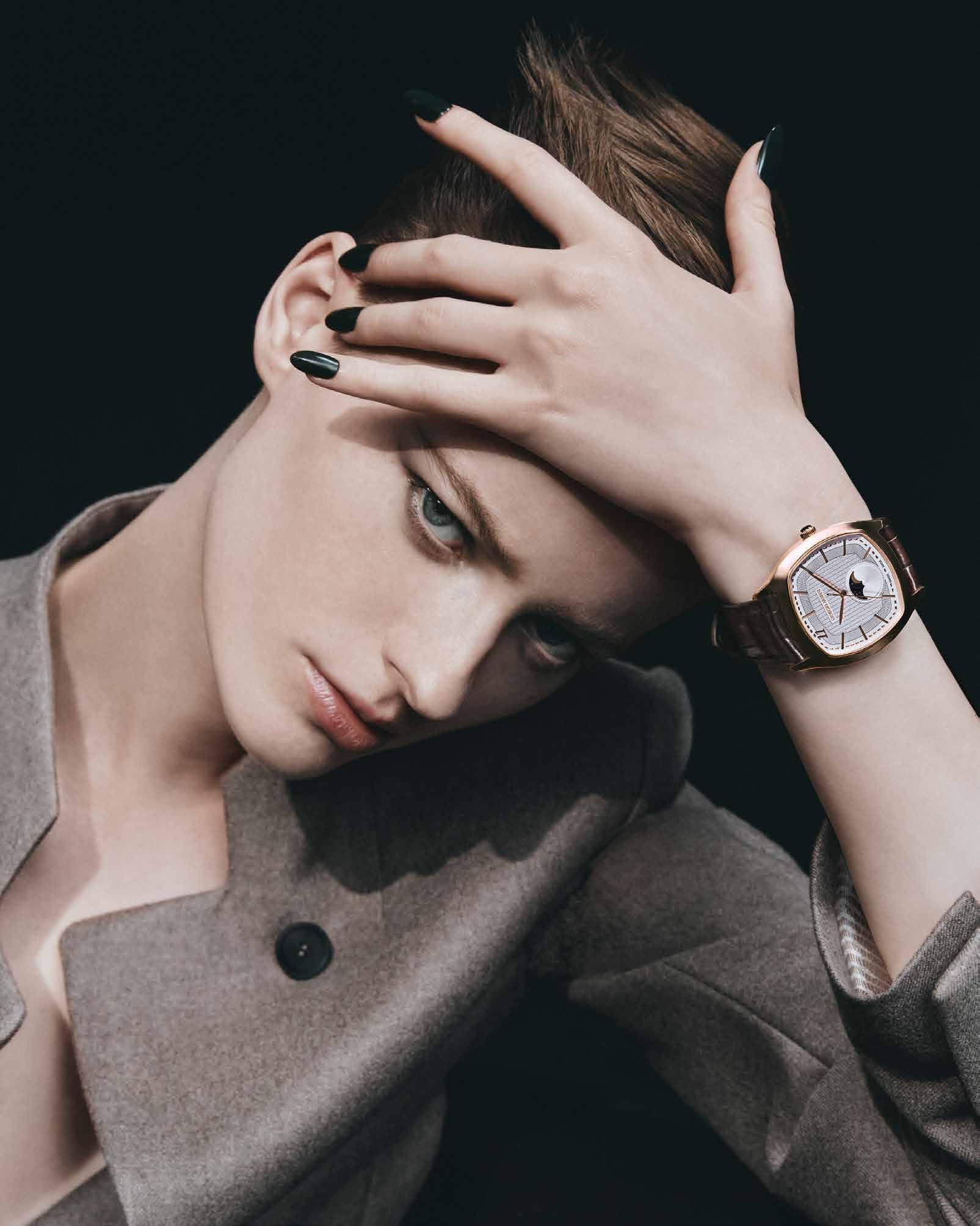
27
Moving House
With its ambitious plans for global expansion coming to fruition and a fifth generation of the family joining the ranks, Mouawad is on the move again. AIR meets the brand’s Co-Guardian, Pascal Mouawad


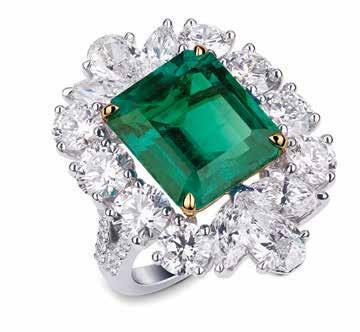




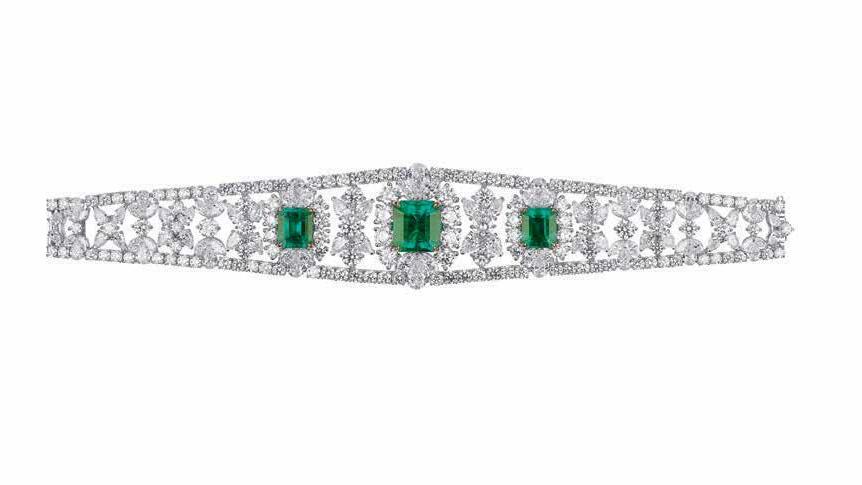

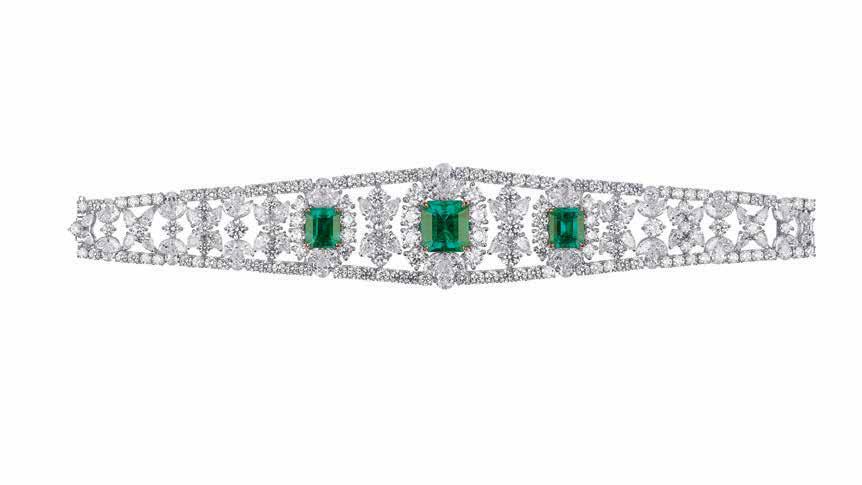
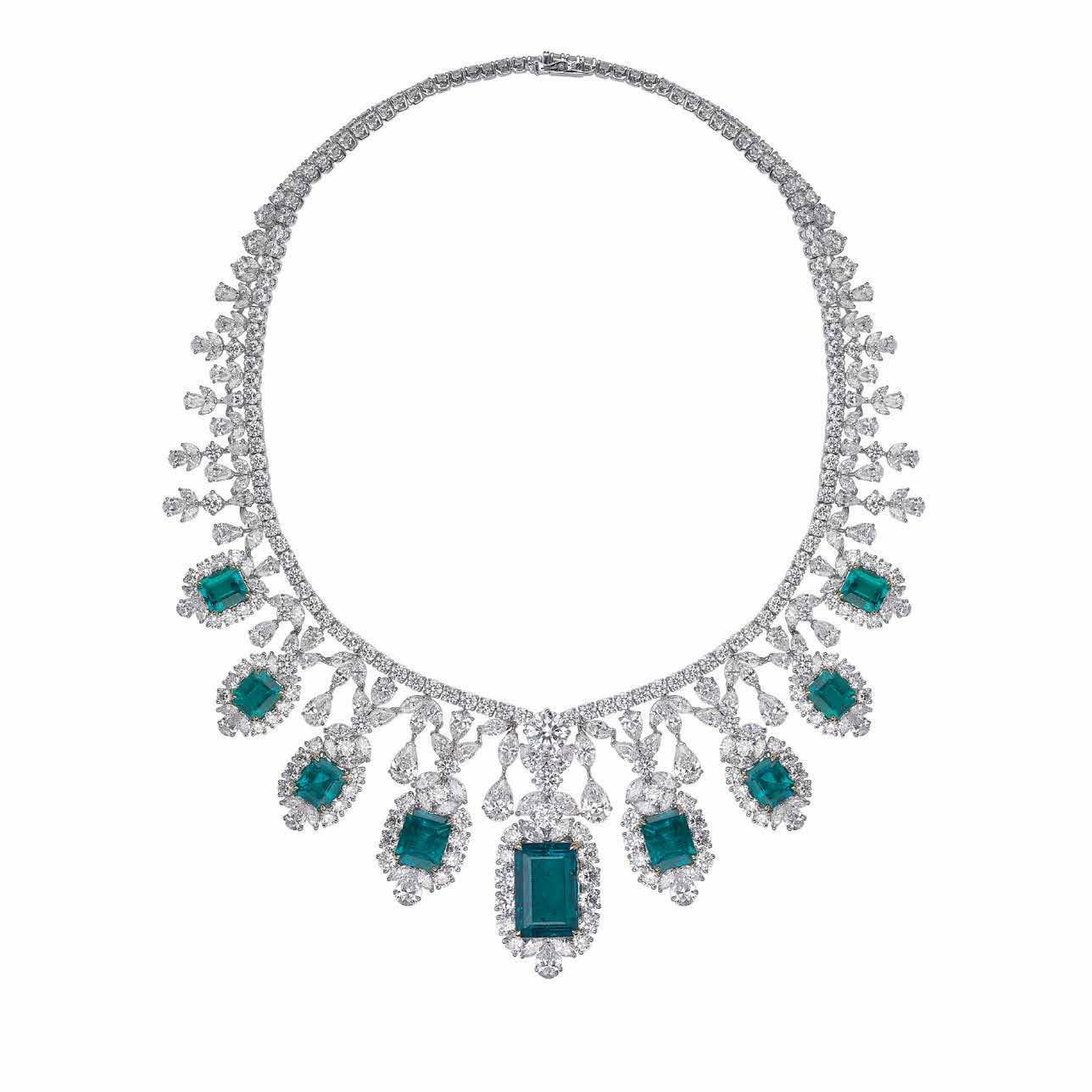

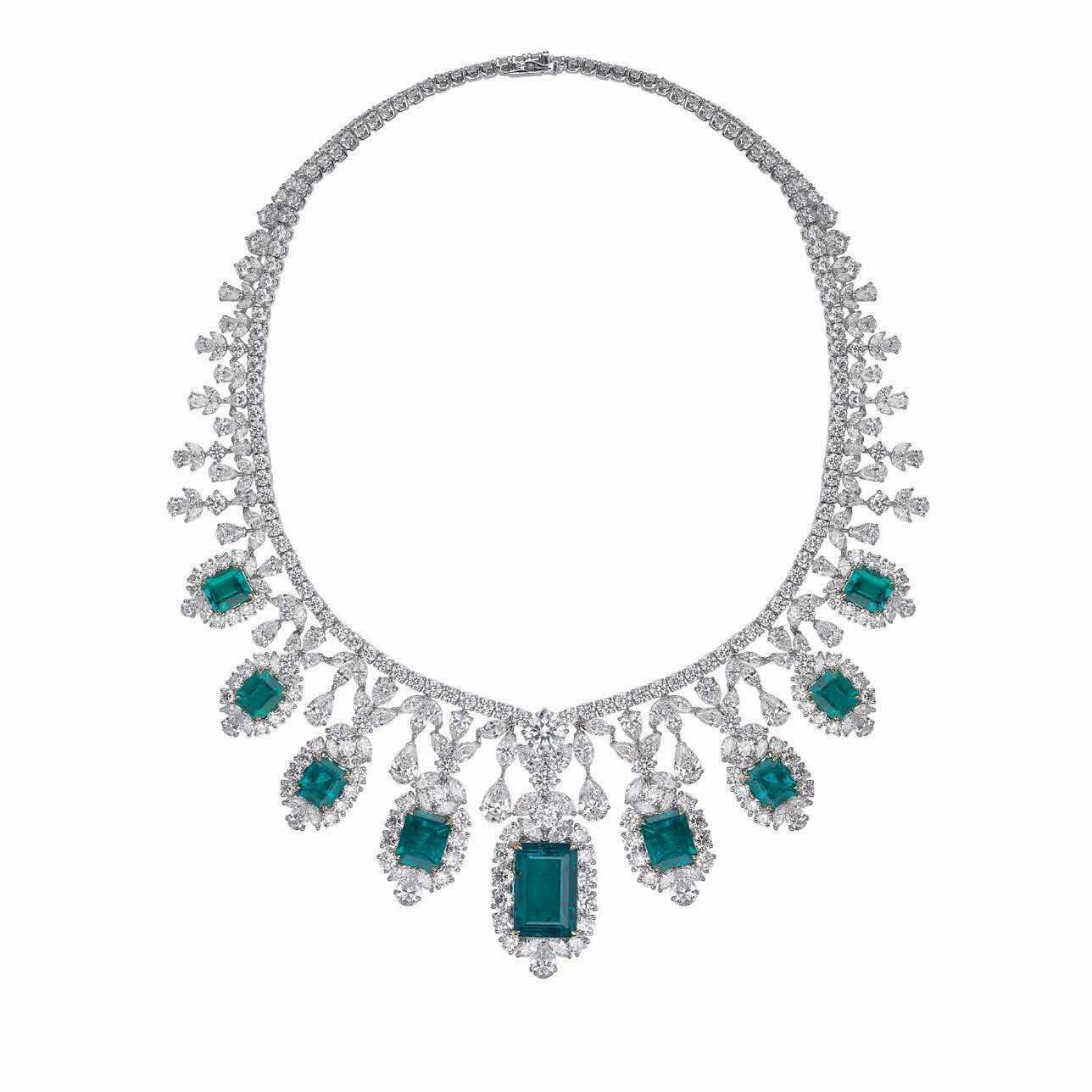
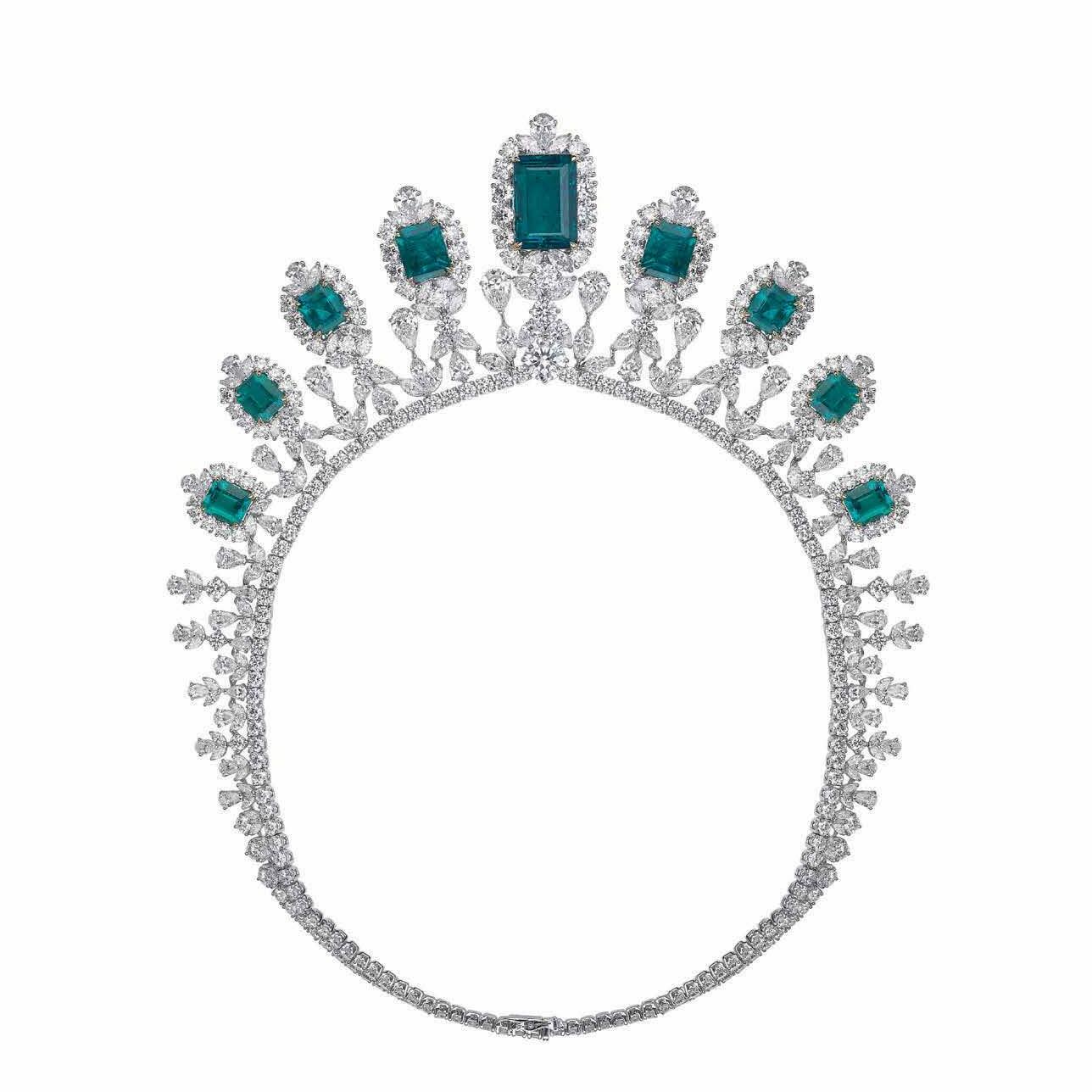

 WORDS: JOHN THATCHER
WORDS: JOHN THATCHER
Jewellery JANUARY 2023 : ISSUE 136
28
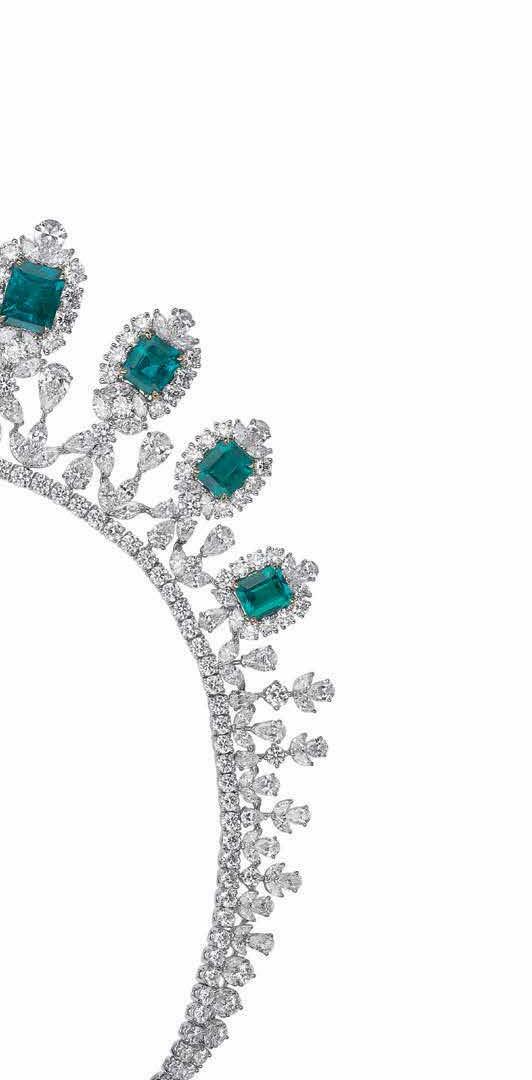
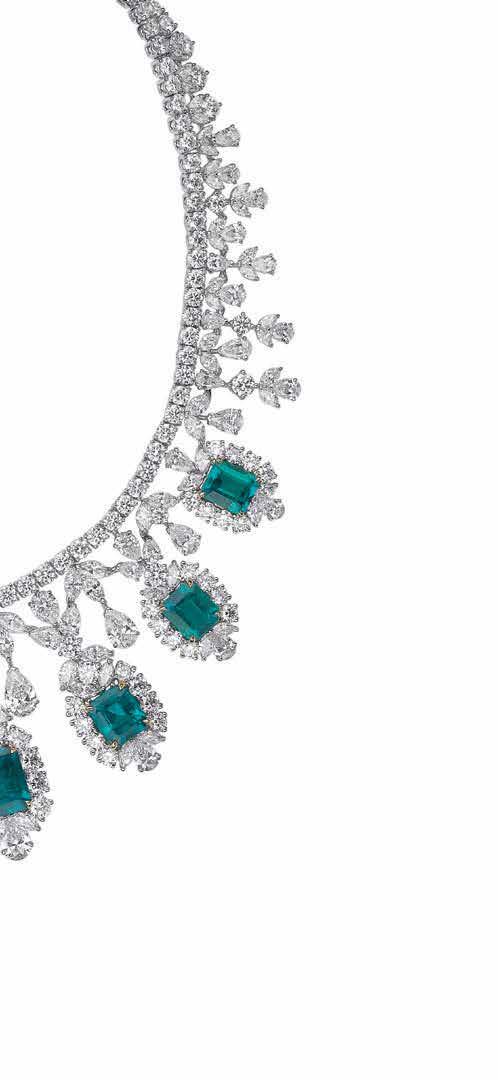
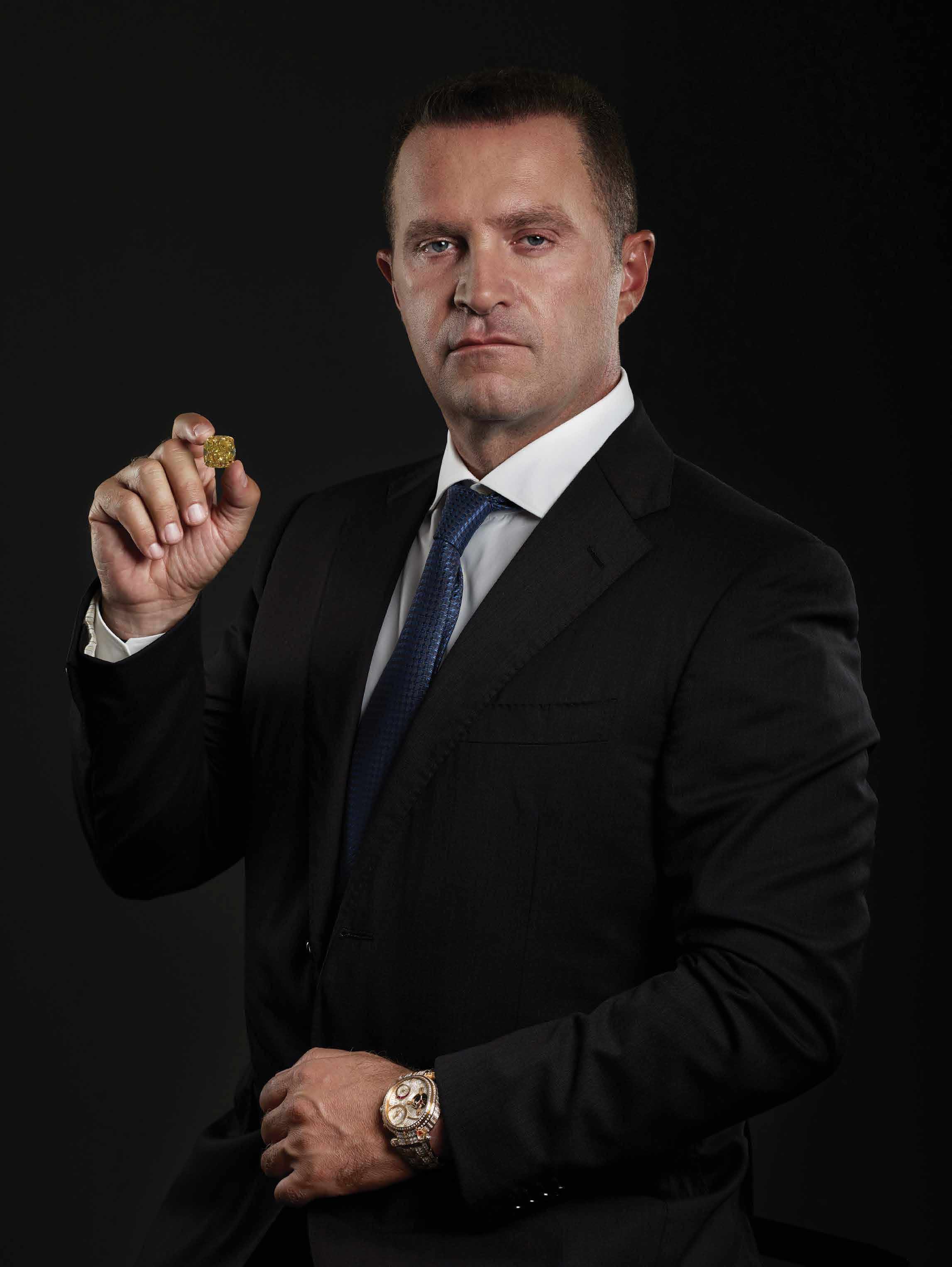
29
These pages, from left to right: Regina suite, Mouawad Masterpieces; Pascal Mouawad
The Mouawad family has always looked beyond its immediate borders. It was more than a century ago when the storied jeweller’s founding father David Mouawad journeyed from his homeland of Lebanon to the US and Mexico, spending the best part of two decades in the region to learn the specialist crafts that enabled him to return to Beirut in 1908 and open Mouawad’s first workshop. Later it was the turn of Fayez Mouawad to expand his horizons. Credited with being one of the earliest jewellers to embellish watches with precious stones, he took his unique skills to Saudi Arabia, where they found a willing audience, setting the foundations for the brand’s ongoing success in the Kingdom.
Europe was next; Robert Mouawad headquartering the brand in Geneva in the 1970s, from where he earned it a global reputation for securing some of the world’s largest diamonds.
Now it’s the turn of his son, Pascal, to plant the Mouawad flag in new territories.

Along with his fellow Co-Guardians of the brand – brothers Fred and Alain – Pascal will lead Mouawad into its largest ever phase of geographical growth, with state-of-the art boutiques pending in London, Los Angeles and Kuala Lumpur, hot on the heels of a new store located within the iconic Peninsula Hotel in Hong Kong, which opened in October.
The famed Rodeo Drive in Beverly Hills will be the home of Mouawad in the US (Los Angeles is also home to Pascal) and the boutique’s opening will coincide with the brand’s e-commerce launch in the country, setting the foundations for a wider roll out of countrywide stores in the years to come.
Ambitious, certainly. So, why now? “My two brothers and I took over the family business in 2010 and we put in place what we called a ‘first decade’ strategy, during which we focused on our core markets of the Middle East and parts of Asia. Since the pandemic, the world has transformed, the markets have shifted, and with it came opportunities to open in prime locations that you wouldn’t even have dreamt of before Covid. Our second decade strategy is now focused on expanding into new markets.”
The wider world should prepare to be dazzled. Mouawad is a family-run company that keeps everything in house, from sourcing stones through to cutting, designing and crafting, and one of the areas in which it truly excels is the creation of unique masterpieces.
“The masterpieces, which are typically one million dollars plus, are what sets us apart,” says Pascal, dressed in all black at his cloud-skimming penthouse in Dubai Marina.
Such pieces are characterised by exceptionally large stones, such as the rare 57.13-carat cushion-shaped


30 AIR
Left page, from left to right: Diamond Classics, solitaire pendant, round brilliant cut diamond, 18k white gold; Diamond Classics, solitaire pendant, 18k white gold, princess cut diamond This page, clockwise from below: bracelet and earrings from a sapphire and diamond high jewellery set; necklace and earrings from Dragon suite, Mouawad Masterpieces

constant innovation and reward. “These pieces could be as simple as an engagement ring, or as intricate as a baby carriage for a member of a royal family, or a chess board encrusted with gems,” says Pascal. Recently a client presented Mouawad with a jewellery suite she hadn’t worn for the past thirty years and tasked them with removing the precious stones from it to create something more modern for her to wear. “Now she’s extremely happy and has a set worth several million dollars.”
Little wonder, then, that celebrities are fond of wearing Mouawad pieces on the red carpet – Jennifer Lopez, Kim Kardashian and Kendell Jenner are fans, as is the Princess of Wales.
You’ll also see the Mouawad name inked into the book of Guinness World Records, due to pieces like the world’s most valuable necklace (2013) and the world’s most valuable jewellery box (2016). More unusual was 2003’s diamond-encrusted bra, which, at $11 million, is the world’s most expensive underwear garment. It was worn by Heidi Klum for that year’s Victoria’s Secret Fashion Show.
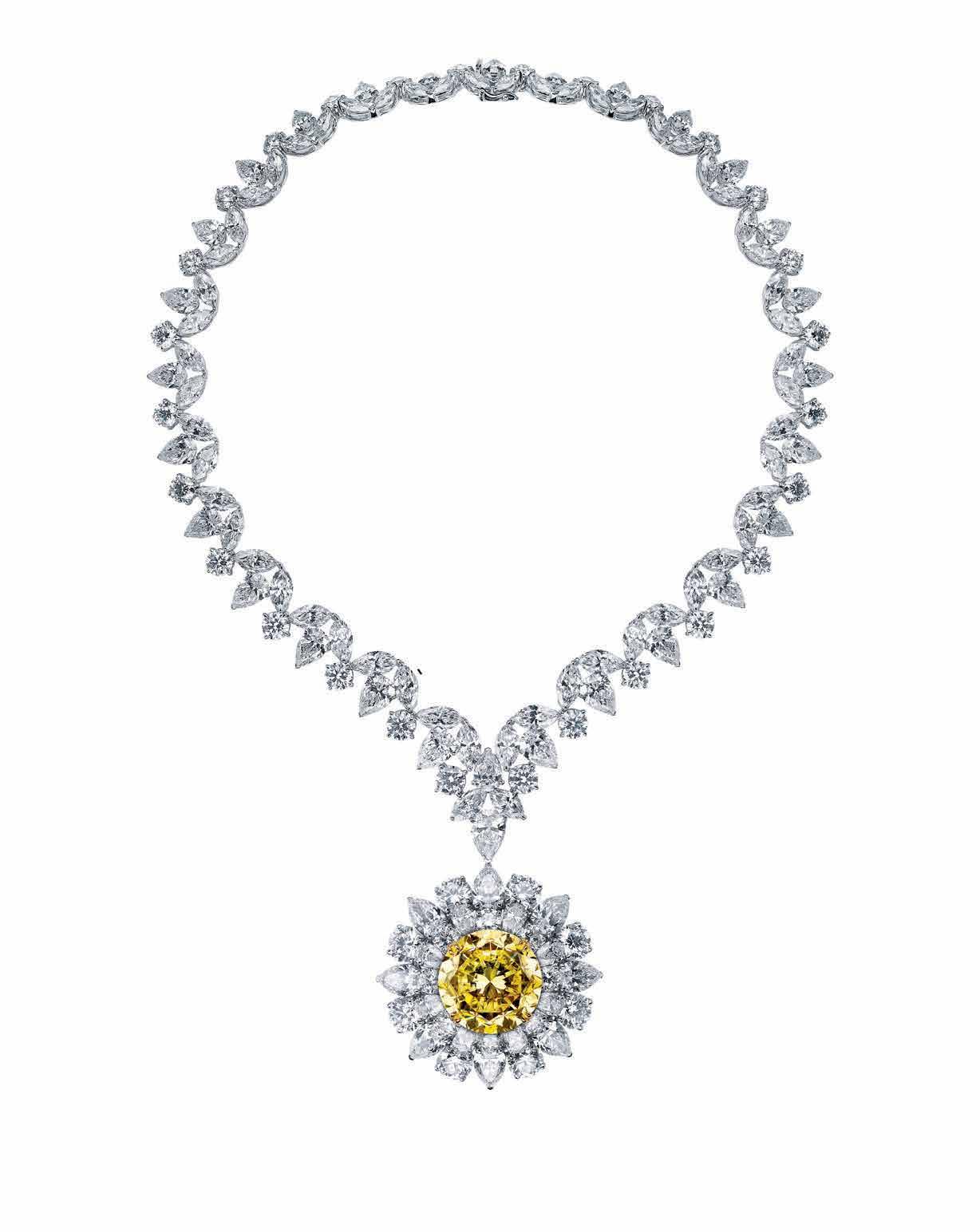
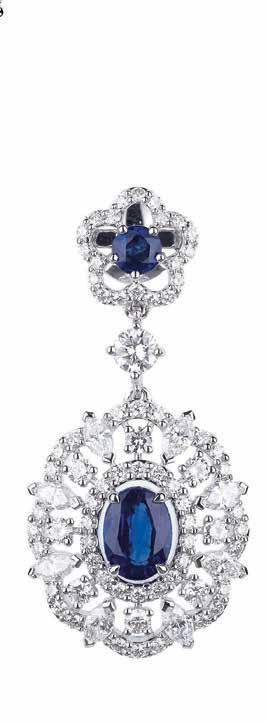
“Right now, we have five records under our belt, with the potential for a sixth one,” reveals Pascal. “We are looking to create more world records.”
Less headline grabbing, but of significantly more importance, is Mouawad’s commitment to projects like its Diamond Impact Fund. “It was initiated as part of our vision to give back to our industry, to help people in South Africa, predominately, to get trained in the art of stone cutting,” says Pascal, who offers what’s now a well-trodden pathway into the company for the most skilled trainees.
“In our business it takes 100 years to build a reputation and one day to lose it. My father has taught my brothers and I about integrity, honesty, and the need for hard work. These three factors drive us and feed our goal of having a succession plan for future generations of our family.”
That plan is already in place, with Pascal’s nephew having recently joined while his niece will do likewise this month, both having studied gemology.
“They bring a new, younger, fresher perspective to the business. We are at a turning point, and in the next three years you will see Mouawad really transform in terms of look and feel.”
Mouawad’s journey may already be long and far-reaching, but you get the sense it is only just beginning.


31
In our business it takes 100 years to build a reputation and one day to lose it ’
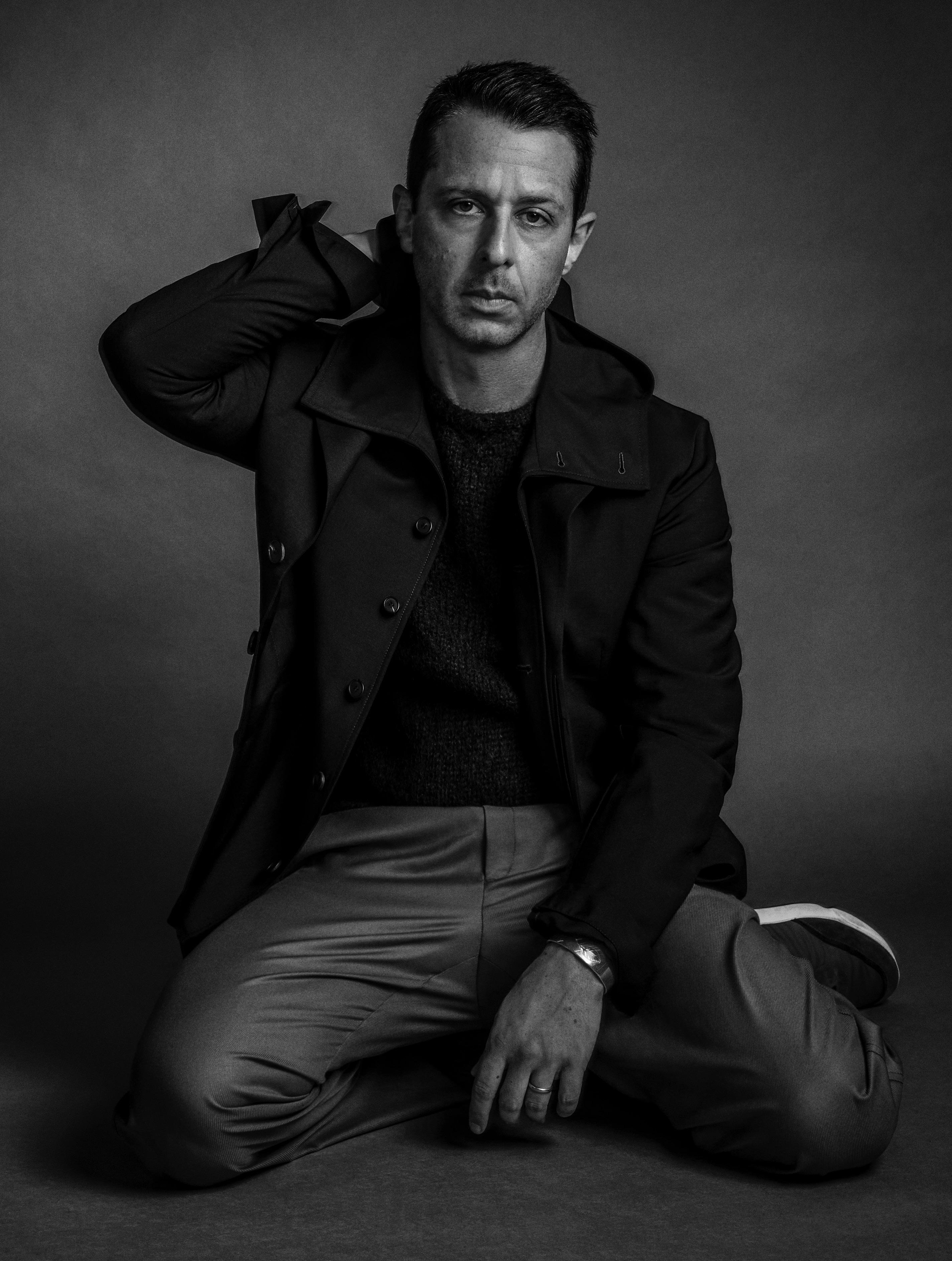
32
AIR
33
Jeremy Strong found fame playing Kendall Roy — but he very nearly gave up on Hollywood. He talks about envy, Method acting and Succession
WORDS: JONATHAN DEAN
Jeremy Strong has a story to tell, but is not sure he should tell it. I am having lunch with the Succession actor in the Hollywood Hills. The city sprawls below as he picks at his kale. He is in the midst of filming series four of the family backstabbing saga, which returns in the spring, as the standout Kendall Roy, and the lines feel blurred. Strong’s grey hair is dyed Kendall black and he is wearing a chunky gold medallion that is suspiciously like the one he has in the show.
Strong looks at home in LA now, but it was not always like this. He is 44 and an Emmy winner for his performance as the Roy family’s most troubled son — a bruised antihero and mess, the best TV character of the past decade. Now he seeks an Oscar, for Armageddon Time , by the Ad Astra director James Gray. In the autobiographical film Strong plays a version of Gray’s father; it was loved at Cannes and has done well at the box office since opening. But success is new to Strong — he struggled until he was cast in Succession at the age of 37, which brings us back to that story.
It starts in 2010. Strong was in Hollywood, trying to find work. “It was a long time ago,” he sighs, in his doleful voice. “But not that long for me.” He was mostly doing fringe theatre in New York at the time and does not, shall we say, have typical chiselled movie star looks or height. Did he feel the film industry was for a different type of man? “For sure,” he says. He smiles, like he has told himself a joke. “OK, f*** it. I will tell you this story . . .”
“I was living across the street,” he begins, gesticulating out of the window. “I’d gone to Yale and Rada, but there was a movie I got an audition for — Cowboys & Aliens (starring Daniel Craig). The role was this impish cowboy and I got a hat, bolo tie, chaps, boots and worked on the dialect. But I pulled up to the audition and it was guys in T-shirts who looked like models. I had a crisis of faith.”
Strong went to the bathroom. He was thinking, “Shall I just take this off?”
He felt ridiculous. But, he explains, you have to commit and so he gave his audition in full garb. He thought that it went well. “It would’ve been lifechanging.” He did not get the part.
“But,” he continues, “they told me there was a top-secret film about
Captain America.” The Marvel blockbuster was released in 2011 and Strong was told he, clearly, would not play the lead. “But,” he smiles, “they needed someone to play Captain America’s young body, before he turns into a superhero. They said they needed a transformational actor and would use CGI to put the actual actor’s face and voice over my own.”
Strong pauses. “I was broke,” he says, “I needed money. I considered it. But that’s my story of LA. It was just never going to happen for me here. It didn’t feel like what I had to offer was valued.” He said no. “And the next day I went back to New York and did a play about a veteran from Afghanistan in a wheelchair during the blackout of 2003.”
I call Chris Evans, the actor who actually did play Captain America. He knew Strong at school. They grew up in Sudbury, Massachusetts, and Evans recalls seeing Strong play the Hobbit in children’s theatre: “Phenomenal.” He had no idea Strong was picked to play his weak body in Captain America — “Oh no!” he gasps — but was always baffled why it took Strong so long to make it.
“It just goes to show the industry is so unpredictable,” he says. “But I’m so happy things worked out, because I don’t think there was ever a plan B for Jeremy.”
Armageddon Time is set in the early 1980s. Strong plays Irving, a plumber with a short fuse. Anne Hathaway is his stoic wife, Esther, and Anthony Hopkins his sweet father-in-law. It is a classy set-up, to explore the politics of both society and huge Jewish family dinners.
Strong went all in for the role. He does this — an interview in the New Yorker last year went viral because the actor said how meticulously he prepares and, online, he was torn

34 AIR
‘ My parents were ostracised. We were not welcomed into the country club. That was something I felt aware of ’
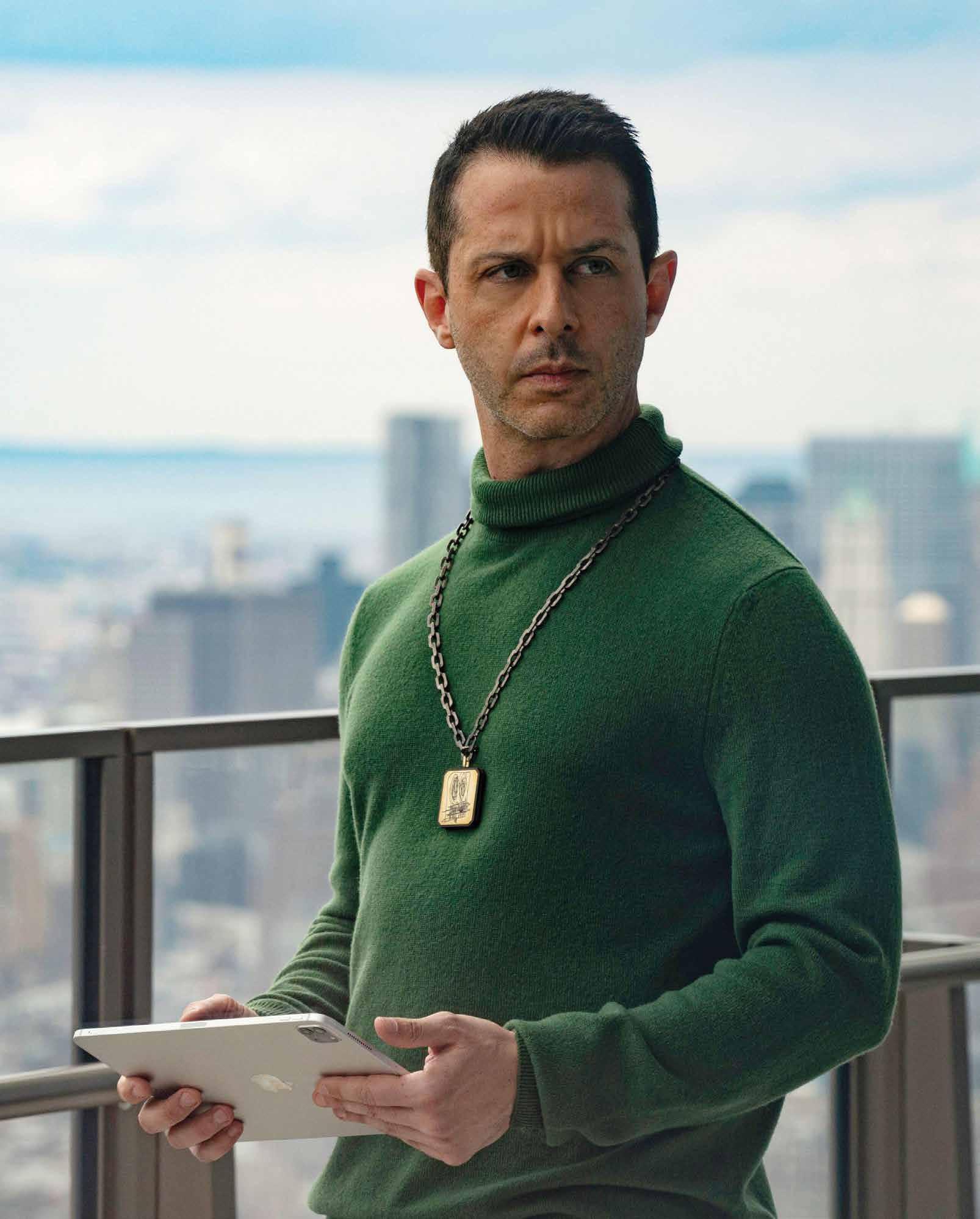
35
to bits for having the cheek to like Method acting. He said the article made him feel “foolish”, but, thankfully, he seems unchanged — an honest man who happily drops quotes like the “anvil and furnace that forged artists” and is, simply, in love with his job and very, very good at it.
“You have to take the raw materials of our lives and transpose them into art,” Strong explains. “A great actor once told me you’re not just there to put on clothes and say words and, if there’s not some Gordian knot you are also actively puzzling through, what’s the point?” Which actor told him that? “Matthew McConaughey.”
To prepare for Irving, Strong stood outside Gray’s childhood home in Queens. (He was not allowed in.) To further explain the work he put in, he quotes Hamlet, talks of “osmosis” and, while explaining a scene in which Irving hits his son, speaks of compassion, violence and the changing nature of fatherhood. Strong has three daughters with Emma, his wife, a Danish psychiatrist.
The film felt personal too. Strong’s family on his father’s side is Jewish and his grandfather was a plumber in Queens. He wore the latter’s watch on set and could also relate to Irving’s alienation, of living somewhere where his family is less well-off than the neighbours. “We moved to a fairly affluent town for better public schools,” Strong says. Born in Boston in 1978, Strong and his family moved to the suburb of Sudbury ten years later. “My parents were ostracised. We were not welcomed into the country club. That was something I felt aware of.”
So he has always felt like an outcast. Plus he thinks a lot, which is perhaps why it took him so long to get a foothold in a business where thought is hardly rewarded. For years he loved theatre. But it left him broke, so bit parts in films like Zero Dark Thirty and The Big Short were important. Still, his career did not achieve both cash and satisfaction until Aaron Sorkin’s The Trial of the Chicago 7 and, of course, Succession. Series three of Succession ended with his father, Logan (Brian Cox), cutting his children out of a seismic deal. Kendall has been in the standout scene of each series — first that
desperate sprint through a log-jammed New York; then his breakdown in a kitchen; most recently a tense dinner with his father in Italy. What happens next? Strong laughs.
“What can I say without being renditioned to an HBO prison?” he says with a smile. “Well, I guess what I can say is that we have made 30 hours of story so far and to my great elation and terror they’ve just upped the ante. It has been as hard a season as we’ve ever had.”
The show will be filming in Scandinavia. While Kendall was clearly isolated from his siblings last time around, the new run will be different. Still, when I ask who he is closest to in the show, since I had heard that he keeps himself to himself, he offers an answer that only Strong could.
“You’d be surprised if you saw me on set,” he begins. “I’m a fairly accessible person, but sets are sociable places and I find that distracting. So, really, it’s more about concentration, less about me avoiding people.” So who is he closest to? “It is more a question of who does Kendall feel closest to. And the answer, really, is nobody. He feels quite alone in this family and so, for me, I take that as a cue.”
He would have been wasted as Captain America’s weedy body double. But, years ago, all this success seemed remote. He recalls staying in his grandfather’s basement in Queens so he could travel to auditions in
the city. He had a CD player and listened to ‘Bridge over Troubled Water’ on repeat while his friends — including Michelle Williams and Jessica Chastain — were becoming stars. Going to Cannes, as he did with Armageddon Time , just felt impossible.
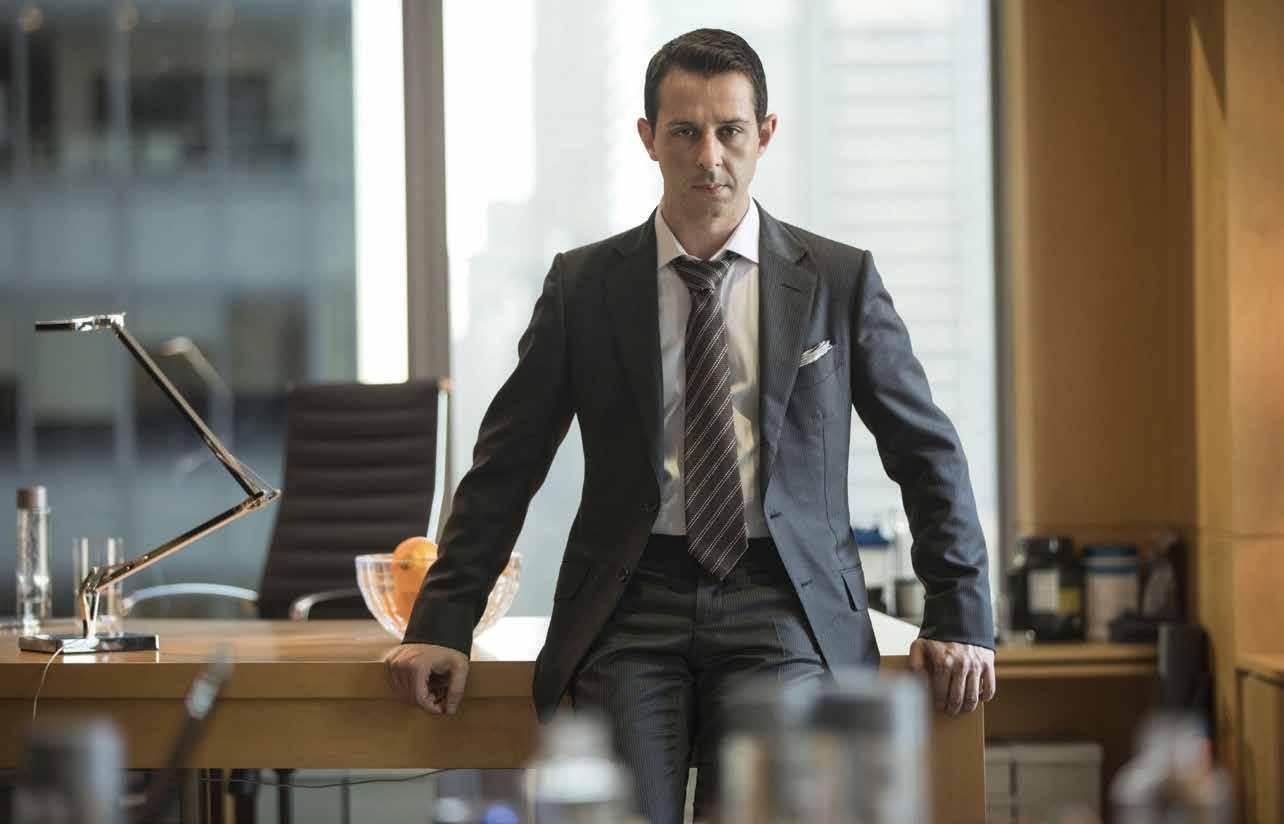
“I’d be lying if I said it wasn’t difficult to see people I was close to getting work,” he says. “I felt that I had a lot to offer but was entirely cut off from those chances. It has been a 25-year grind of working hard and meeting, with very little result. I had fulfilling experiences, doing plays in 60-seat theatres where I felt like I levitated. But I was struggling. I had some difficult times as a younger person.”
Did he ever feel that he should give up? “I did have experiences where I was belittled or told it was foolish.” Who by? “There were people in my life who told me that. In my extended family. And, when you’re young, you internalise those voices. But I guess there is just something in me that couldn’t give up.”
Now he feels ready. The play about the vet in a wheelchair? He says it began a run of work that led to more plays, better film roles and Succession. He kept his head down, took risks, got rejected, but is now in a film with Hopkins, a hero. “I’ve spent my life preparing for this moment,” he says, smiling. And, as with everything else, he says that with great sincerity — he has wanted to be an actor since he was four.
AIR 36 Credit: The Sunday Times / News Licensing
Previous page, above and right: stills from Succession

37
‘ Kendall feels quite alone in this family and so I take that as a cuee’
From haute couture designs to stage costumes, photographs and films, the late visionary Thierry Mugler left a universe of immense creativity for us to explore
WORDS: CHRIS ANDERSON
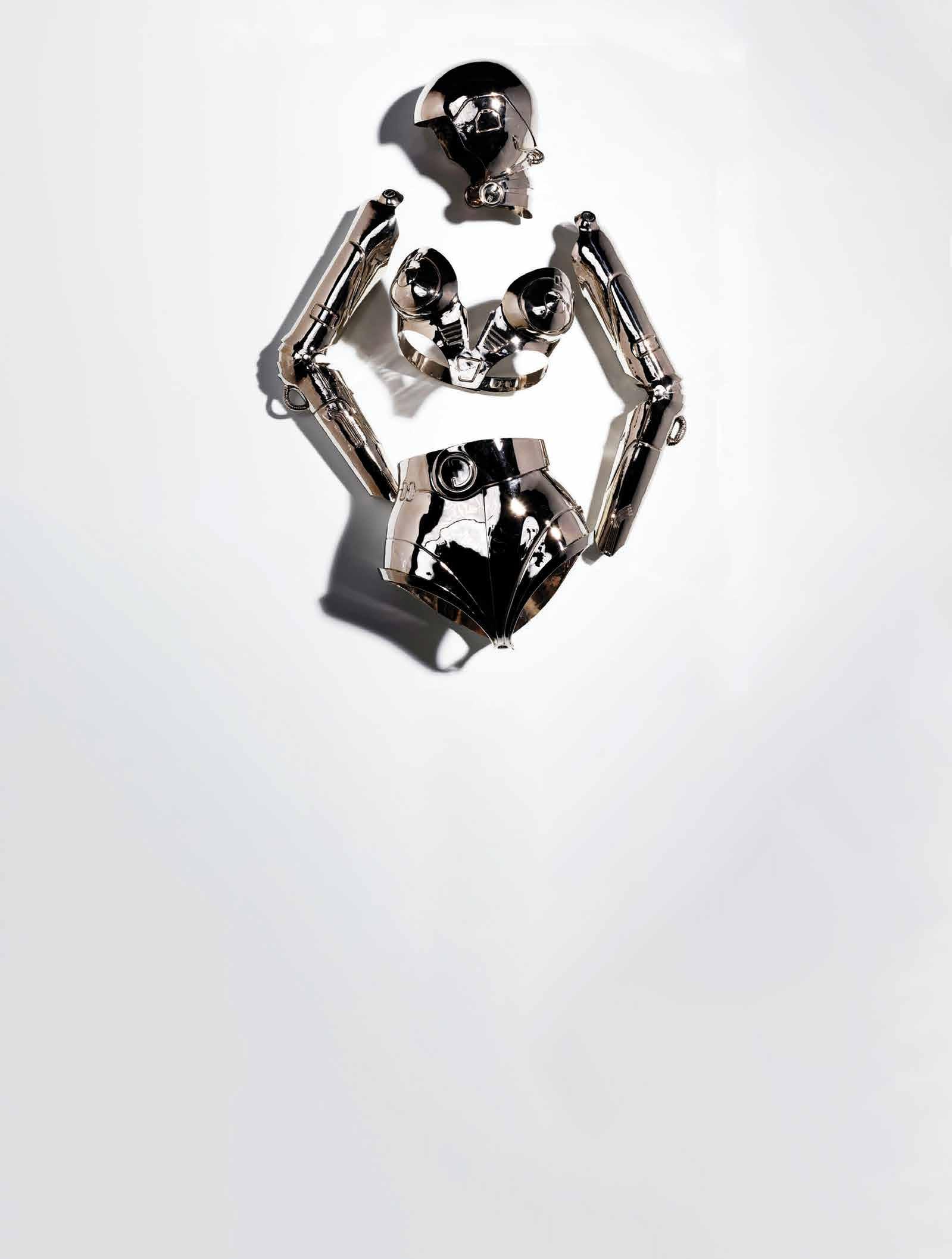
38
AIR

39
These pages, from left to right: Prêt à Porter Spring Summer 1991 collection (“Superstar Diana Ross”) Metal bra, shorts, articulated armpieces and helmet, made in collaboration with Jean Pierre Delcros © Emil Larsson; Thierry Mugler, Montreal 2018. Courtesy and © Max Abadian
Always one to defy convention, the retrospective of iconic French designer Thierry Mugler, Couturissime , currently running at the Brooklyn Museum in New York, opens with a life-size 3D hologram of a dress. It represents a gown, or more accurately a gold cage on top of a metal skeleton, that Mugler created for the character of Lady Macbeth in a 1985 theatrical production in France. Inspired by the architecture of Strasbourg Cathedral, from the city where Mugler grew up, the original item was deemed far too delicate to travel, hence the ghostly projection.
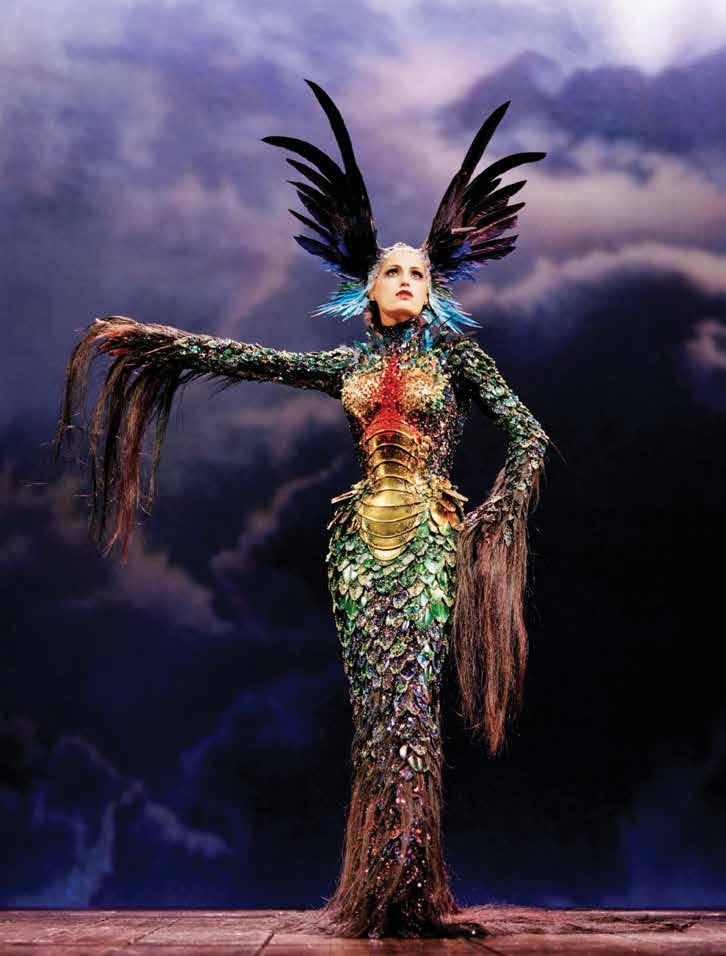
I t sets the scene for the rest of the exhibition perfectly. An example of one of Mugler’s many bold, armour-like creations, often thought too impractical and uncomfortable to be worn by the concerned models and performers at the time, but which Mugler would insist exaggerated their proportions and make them feel empowered. Launching his own label in 1973, he often used the term ‘glamazon’ (a conflation of the words ‘glamour’ and ‘Amazon’)
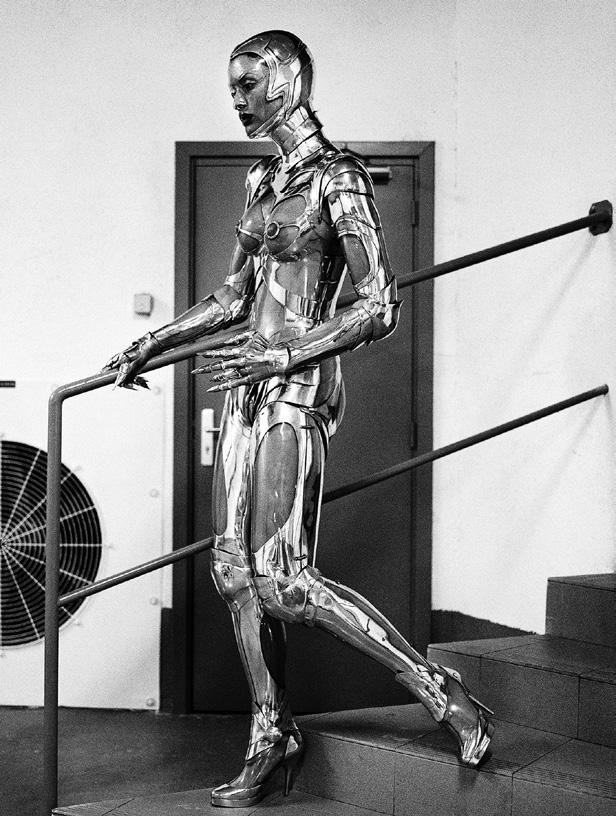
when dressing women, with his first menswear unveiled in 1978.
S o this is a show several decades in the making. Collecting examples of haute couture, stage costumes, photographs, films and sketches, the exhibition, arranged by theme, reveals how Mugler became one of the most daring designers of the late 20th century. No doubt the time spent in his youth as a ballet dancer, and also being the son of a doctor, gave him a solid understanding of the human form, with fashion used to both flatter and exaggerate the shape. His views extended to his own self-image, as he became obsessed with bodybuilding, wanting to appear larger than life.
T hrough his love of sci-fi and the natural world, and the way he combined traditional materials (velvet, organza and silk) with the unconventional (glass, Plexiglass, PVC, faux fur, vinyl, latex and chrome), Mugler rose to prominence in the 1980s and 1990s. He became known for theatrical fashion shows, his celebration of diversity and unisex clothing years ahead of his time,
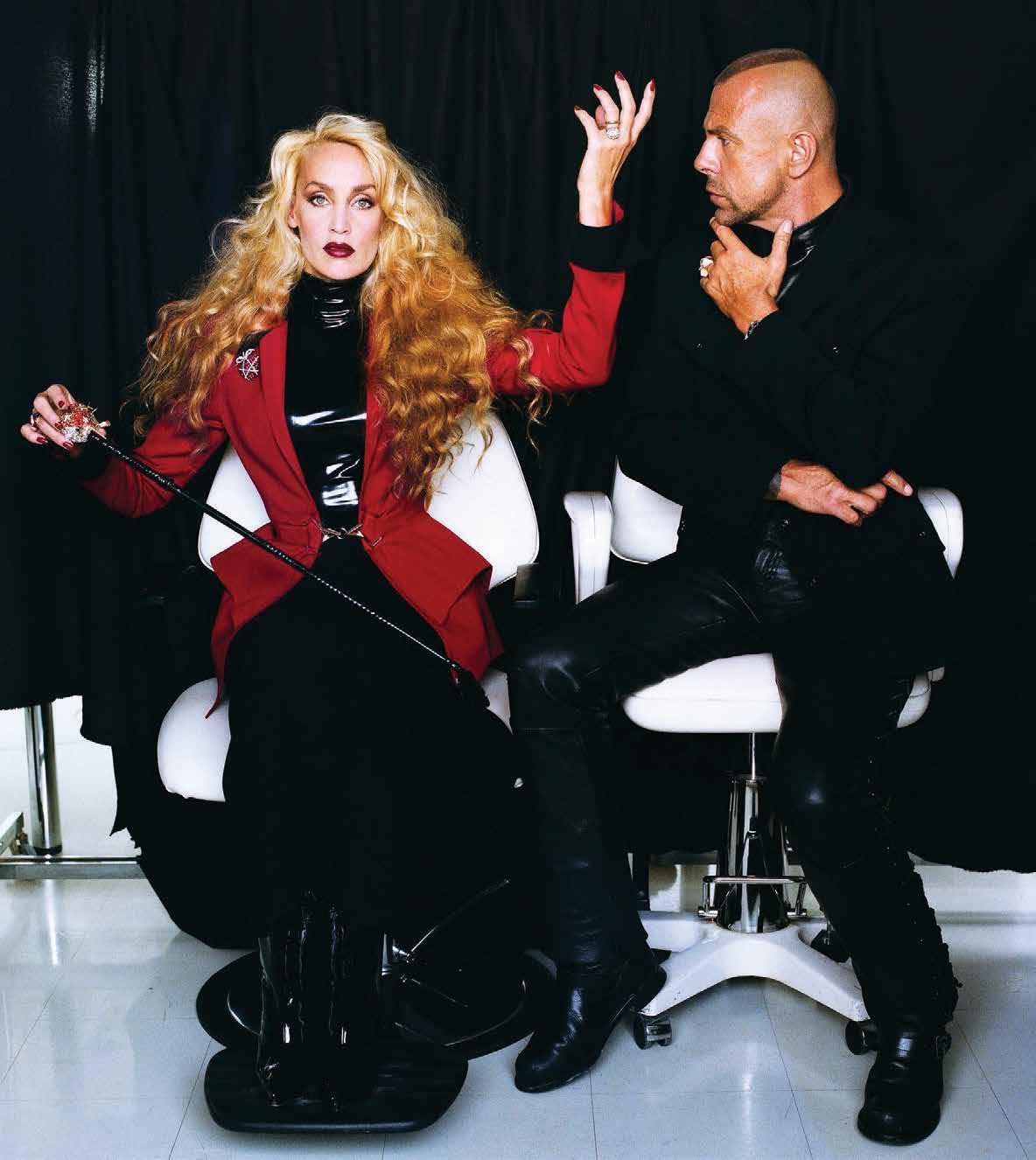
AIR 40
These pages, clockwise from left: Jerry Hall and Thierry Mugler, Paris 1996. © Helmut Newton Foundation; Claudia Lynx 1995. Prêt à Porter Fall/Winter 1995-96 collection.
Courtesy and © Helmut Newton Foundation; Haute couture Spring/Summer 1997 collection, painted latex dress, Fritz Kok; Yasmin Le Bon, London, 1997. Haute Couture Fall/Winter 199798 collection © Alan Strutt
‘ This is a man behind so many pop culture movements’

41

42
AIR
and by developing the looks of major celebrities, including Michael Jackson, Madonna, Diana Ross and David Bowie, among others.
T he New York exhibition, set across 16,000 sq ft, originally opened in 2019 at the Montreal Museum of Fine Arts in Canada, curated by writer and long-time Mugler collaborator ThierryMaxime Loriot. It then travelled to Germany, the Netherlands and France before arriving in New York – a city that Mugler had lived. Here, it takes on new meaning, as Mugler passed away just one year ago in January 2022, aged 73.
T he curator, Loriot, explains why he was so keen to develop the exhibition.
“You mean aside from teaching anglophones how to pronounce our mutual first name, Thierry?” he laughs.
“It’s ‘tea-a-ree’, not ‘cherry’. But that aside, this is a man behind so many pop culture movements. The constant innovations, inventions and avantgarde architectural silhouettes have
marked an era. His singular style found a place in the history of fashion that still has a powerful influence on today’s generation of couturiers.”
M any of Mugler’s greatest achievements are referenced – the black dress he designed for actress Demi Moore in the 1993 movie Indecent Proposal ; his co-direction of George Michael’s 1992 music video, ‘Too Funky’, which featured a cast of supermodels; his costume designs for Cirque du Soleil’s Zumanity in 2003; and his outfits for Beyoncé’s 2009 ‘I Am… Sacha Fierce’ world tour. And even today’s celebrities, such as Lady Gaga, Cardi B, Kim Kardashian and Kylie Jenner, continue to wear his vintage pieces in public.
M ugler actually stepped away from his fashion label in 2003 to concentrate on other projects, after its sale to Clarins in 1997. It was recently purchased in 2020 by L’Oréal – which serves as a sponsor of the New York
exhibition. The new owners enjoy the continuation of the Mugler name in fashion, but also fragrances, launched in 1992, with their own section in the Brooklyn Museum, just in time for the 30th anniversary. The first release, Angel, became an instant bestseller thanks to its inclusion of ethyl maltol, a compound used in the food industry to lend a sugary perfume to sweets. Its sculpted bottle is displayed alongside more recent Mugler scents, such as Alien, A*Men, Aura and Womanity.
F ashion photography, and Mugler’s involvement in its evolution, is also given the spotlight, featuring the designer’s collaborations with Guy Bourdin, Karl Lagerfeld, David LaChapelle and Helmut Newton, among others. Mugler himself was a prominent photographer, and even shot his own advertising campaigns, featuring the likes of Jerry Hall and Iman. He liked extreme locations, such as Greenland and the Sahara, and famously

43
‘ Mugler’s singular style found a place in the history of fashion that still has a powerful influence on today’s generation of couturiers’
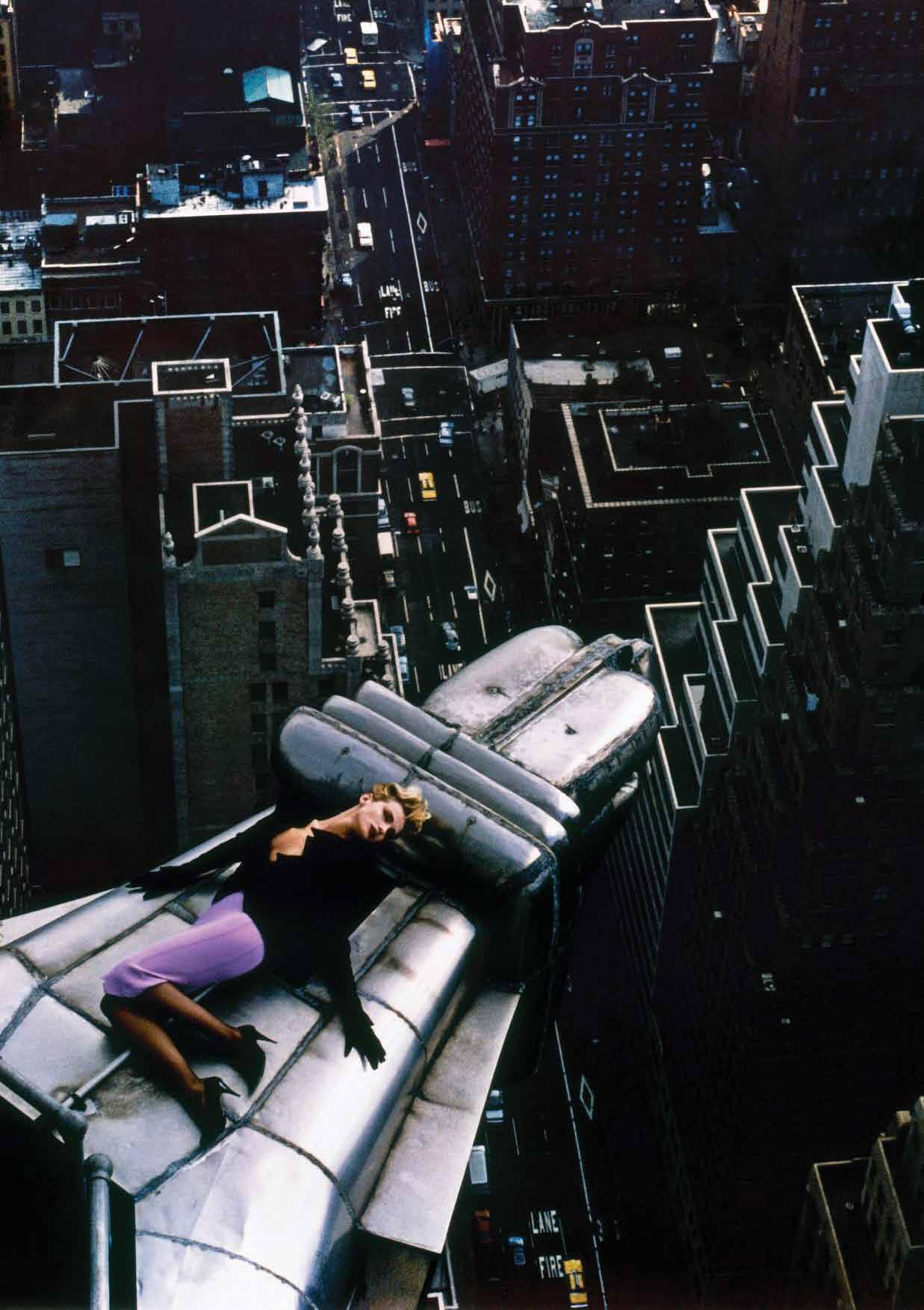
44
AIR
convinced a model to lay atop one of the eagle sculptures 61 floors up on the side of New York’s Chrysler Building, waiting an entire week for the perfect windless day.
T hen there is a room dedicated to so-called ‘fembot couture’, with robotic uniforms forged with the help of aircraft bodywork specialists, automotive designers, and other great minds of industry. This includes Maschinenmensch, a suit from 1995 that took six months to fabricate, inspired by the 1927 Fritz Lang movie Metropolis
F rom here, visitors can enter the Metamorphosis section, with its setting designed by Montreal studio Rodeo FX, the special effects team used for TV’s Game of Thrones and Stranger Things . It houses some of the more extravagant Mugler designs, inspired by nature, with hourglass waistlines, butterfly wings made of feathers, latex outfits resembling insects, and La Chimère,
worn by Yasmine Le Bon in 1997 — arguably the most elaborate dress the designer ever made.
“ Mugler was a pioneer when it came to women’s empowerment and diversity, starting in the 1970s,” says curator Loriot, reflecting on it all. Perhaps the biggest takeaway, however, is the lengths that Mugler would go to in order to perfect his ideas. He
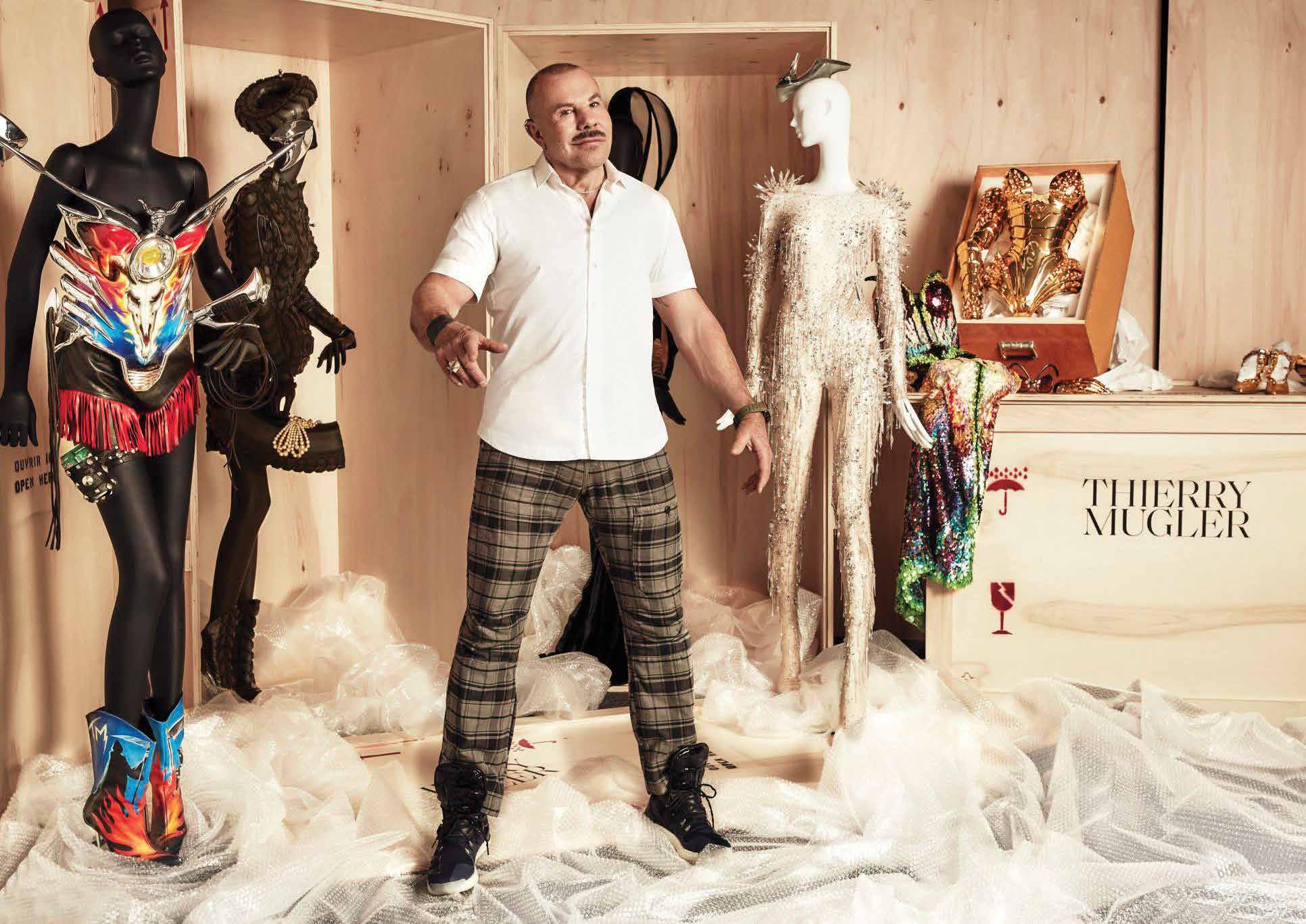
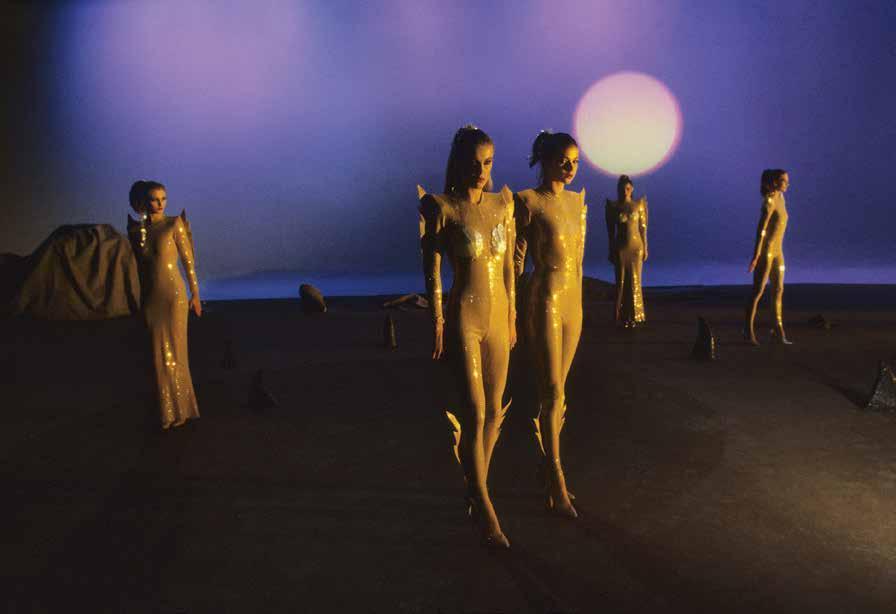
Previous pages: “You have to find what sparks a light in you so that you in your own way can illuminate the world” Oprah Winfrey 1998. © David LaChapelle; Thierry Mugler Vogue Paris, 1998. Courtesy and © Jean Paul Goude
These pages, clockwise from above:
Claude Heidemeyer in Vertico by Mugler. Courtesy of Mugler Archives. © Thierry Mugler; Thierry Mugler, Montreal 2018, Max Abadian; Stern, 1979, Prêt à Porter Fall/ Winter 1979-80 collection Spirale © Peter Knapp
once said, “My limit is no limit… I do love extremes, and I’m of an extreme discipline, certainly,” before adding, “In my work, I’ve always tried to make people look stronger than they really are.” Exploring Couturissime , the strength of Mugler’s legacy is clear.
Thierry Mugler: Couturissime is at the Brooklyn Museum, New York, until May 7
45
‘
In my work I’ve always tried to make people look stronger than they really are’
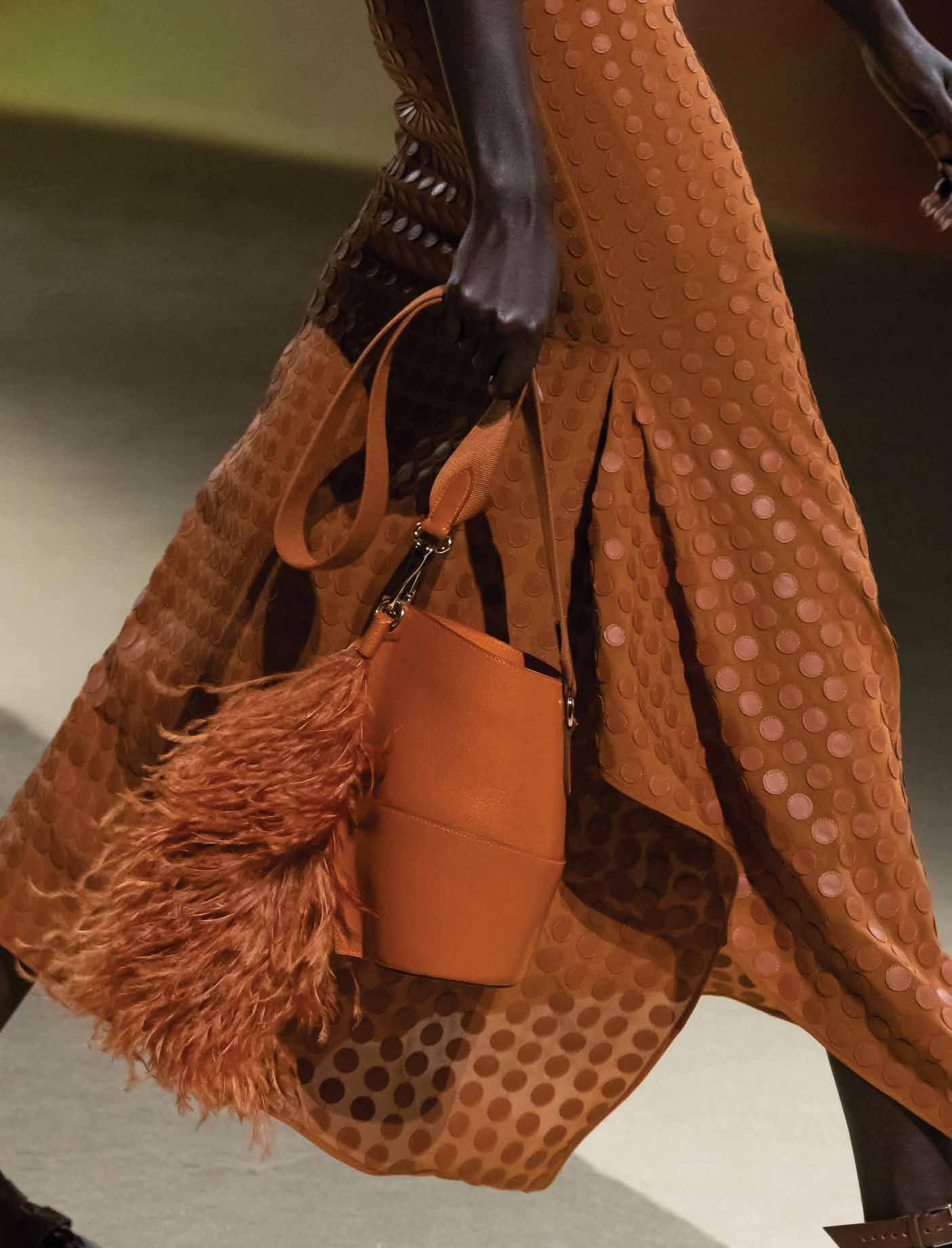
46
AIR
With her serene nonconformity and measured take on sensuality, who better than Nadège Vanhée-Cybulski to energise Hermès?
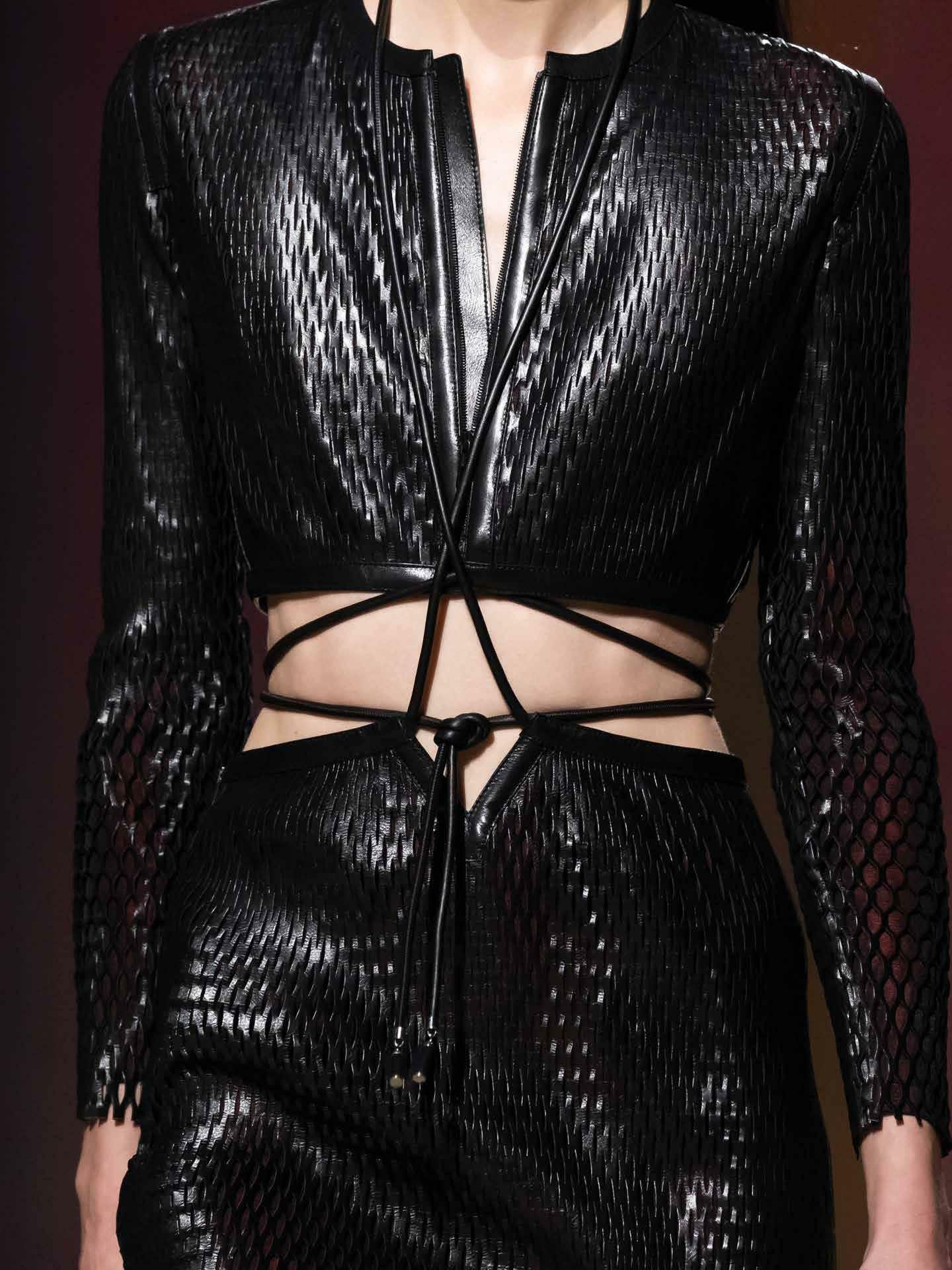
47
WORDS: LISA ARMSTRONG
Eight years into her gig as Artistic Director of Womenswear at Hermès, Nadège VanhéeCybulski still doesn’t feel entirely at home. “And that’s a good thing,” she says in her precise but heavily accented English. “Because being totally at ease implies complacency.”
With her alabaster skin, PreRaphaelite hair, dark eyes and utilitarian, if expensive, uniform (today she’s wearing an oversized shirt over chinos, with strappy flat sandals, and unvarnished toes), she looks serene enough. Perhaps that goes with the luxury of having zero presence on social media. She has an anonymous account so that she can explore, but she doesn’t post. And Hermès is not the kind of house to force the point.
Or perhaps it’s because whatever she’s doing – on or off social media –is working. Her imprint at the helm of the French design legend is now assured and reassuring, aligning an occasionally quirky, feminine pragmatism with a pleasingly functional take on luxury. Hermès’ revenues for 2021 stood at €8.98 billion, a 30 per cent increase on 2019, before the pandemic hit.
Or maybe, to get personal for a moment, which she does only occasionally, making it count all the more, it’s because after a challenging period in her late 30s when she underwent several rounds of IVF, her daughter was born four years ago. That was a tricky time.
We’re sitting in the bright, white and vast women’s ready-to-wear showroom in downtown Pantin. I jest, a little. Pantin in truth lies beyond the Périphérique, that multi-laned ring road separating picturesque Paris from its scruffy and distantseeming banlieues. It is finally on the up, with expensive-looking bijou residences being built, similar to those you might see in hipster corners of London. But buzzy it is not – yet.
Perhaps this is taking armchair
psychology too far, but the spring/ summer 2023 collection, which is hanging from rails and rails – it’s vast – around us contains plenty that would look womanly and even sexy on. Racer backs, cut-away sides, dresses that can’t really be worn with a bra (don’t worry, she’s thought of that and used a stretch fabric that holds everything in place), little knitted shorts in mustard baby cashmere… this is her rebellious side coming through. But there’s plenty of practicality, viz reversible clothes and drawstring waists that allow the wearer to adjust the silhouette. These, together with her obsession with buttonholes and fastenings, mean the duality of luxury and function runs through all her collections. This is the company’s 1837 origins – meticulously crafted leather saddles – rewritten as fashion.
For all her sophisticated taste – the apartment she shares with her British gallerist husband Peter Cybulski, with its impeccably curated swirl of contemporary art by Rhys Coren and Julie Beaufils, Japanese porcelain, 1960s Italian lighting and a squishy George Sherlock sofa – she is an authentic rebel. In her late teens, her look was short hair, enormously oversized jeans and white clogs – “so ugly,” she says. Yet 20-odd years later, she introduced a refined version into the 2020 spring collection, and to almost everyone’s surprise, the clogs became a cult sell-out.
To understand part of what makes Hermès so special, apart from the whole company’s almost religious insistence on quality, the endless
waiting lists for its Birkins and Kellys and the way the house seems to glide above the fray of fashion commerce, for instance abandoning the madness of multiple collections a year in favour of two, the old-fashioned way, we should pause with those clogs for a moment. Because as she’d be the first to point out, she didn’t design the clogs – Pierre Hardy did.
“The fact is, Hermès is a collective, with 16 different métiers, each with its own creative director,” she explains. These métiers are wildly diverse –leather, fragrance, china, watches, scarves and latterly make-up – but united by a reverence for craft.
“We’re like Jedi,” she says. “We all meet up very early in the process of a collection to exchange ideas.” If she wants a shoe to complement a silhouette with a nipped-in waist and wide shoulders that she’s planning for the next collection, she can ask Hardy (who’s in charge of jewellery as well as footwear) what he can design, “and he’ll come back with a finished product,” she says. “It’s the same with the maroquinerie [leather goods]. It’s a whole grid of creativity I can tap into. I’m so lucky.” I ask whether the lipstick streaks on her hands are from a meeting with the makeup team. “No,” she says, laughing. “They’re from playing with my daughter this morning. To be honest, I’m not a big make-up wearer.”
Vanhée-Cybulski isn’t the first woman to be in charge of fashion at Hermès. In the 1920s (an early example of a leather goods company diversifying into clothes) there was Lola Prusac; in the 1980s, Catherine de Károlyi. But she is the first fashion designer at the house who doesn’t have a second job. Before her, Martin Margiela, Jean-Paul Gaultier and Christophe Lemaire all retained their own labels while also working for Hermès. This is an important distinction, marking as it does the house’s renewed belief in its fashion
48
‘
For me, and the whole team, sustainability is very, very important and we’re digging very deep ’
AIR
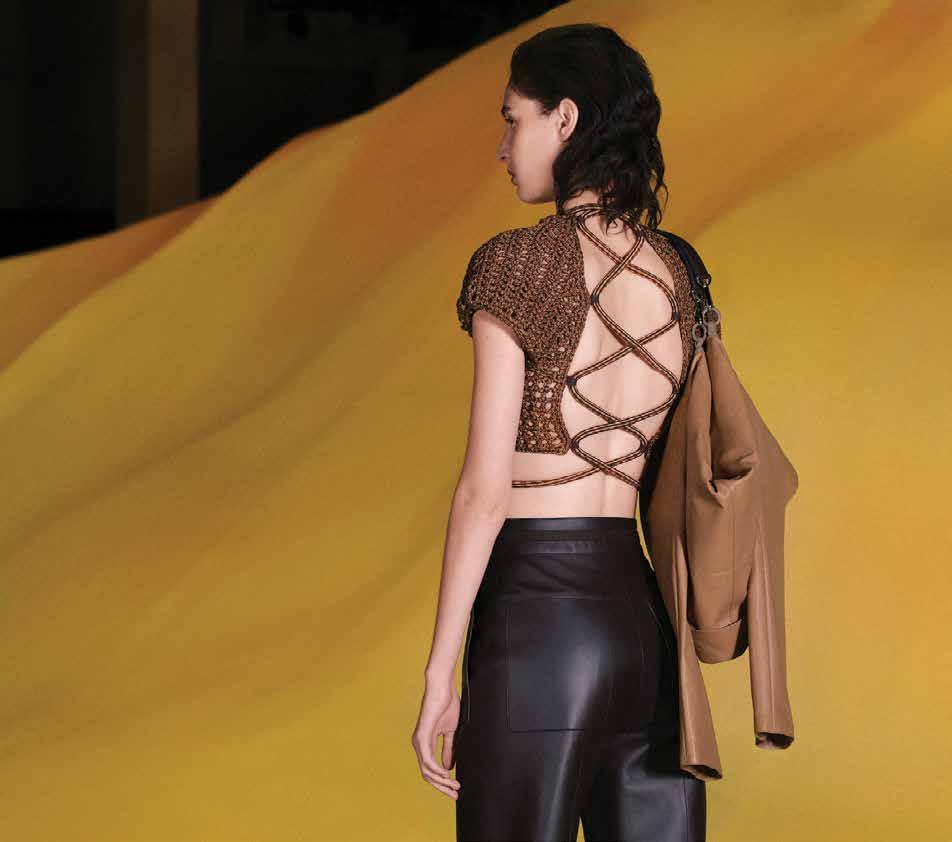

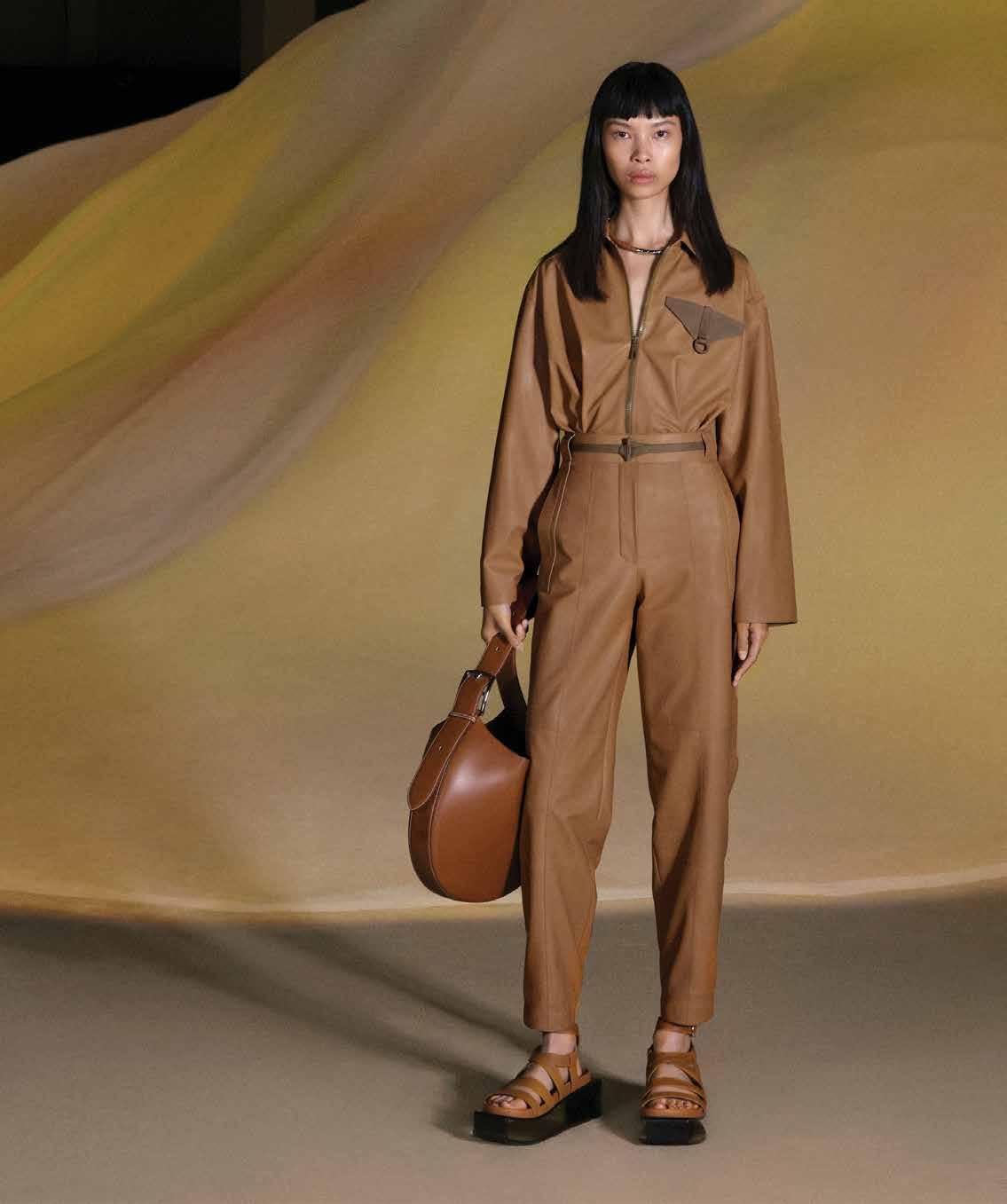

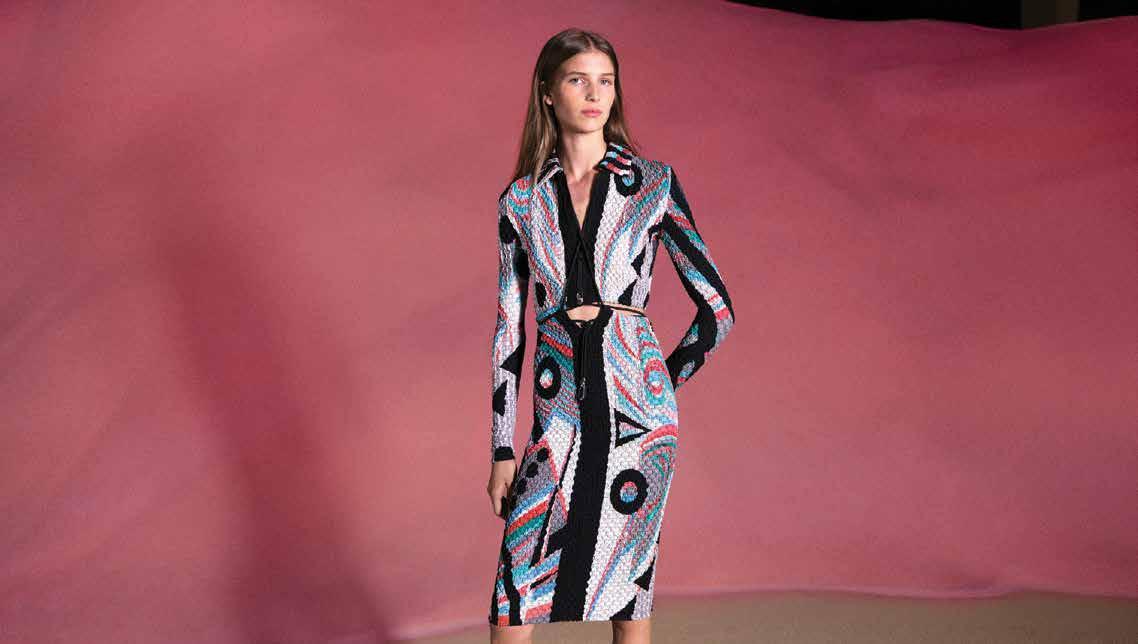
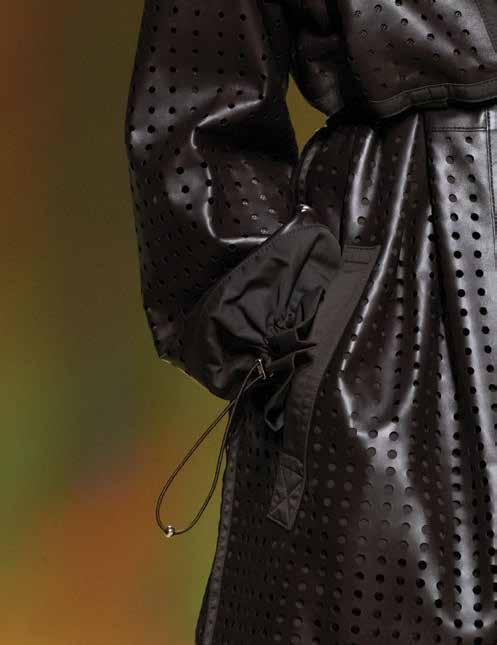
49
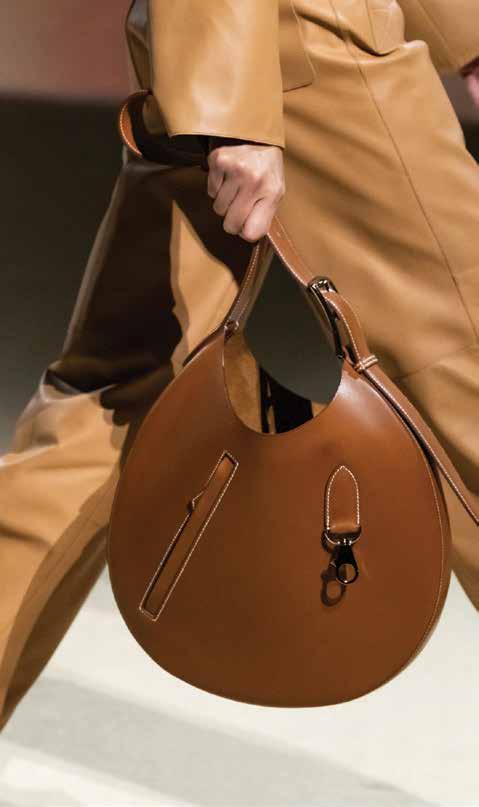
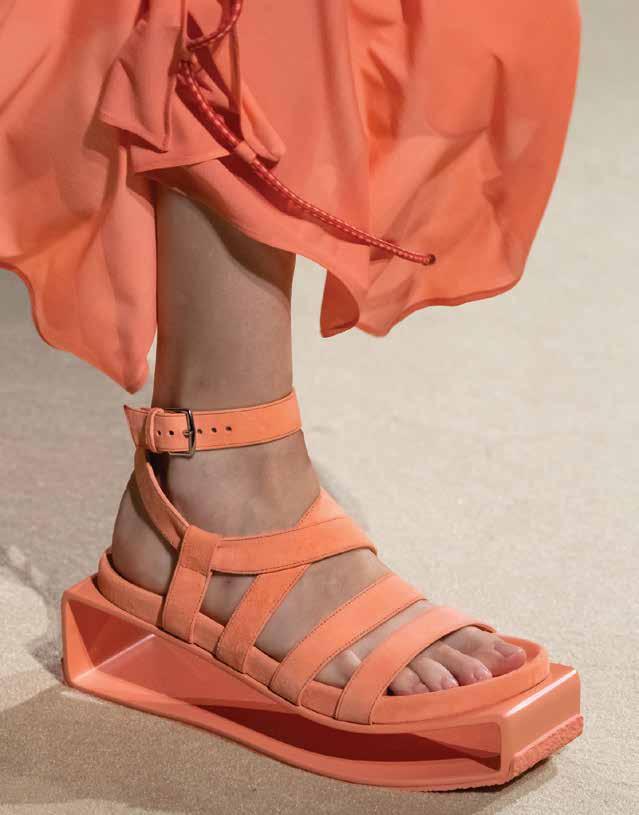

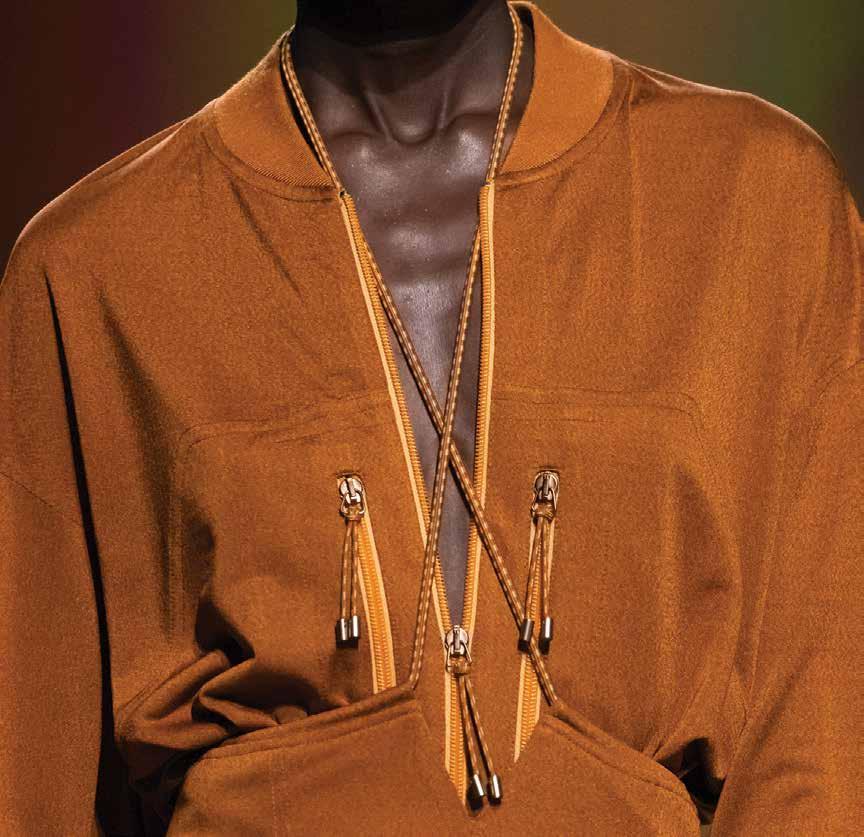

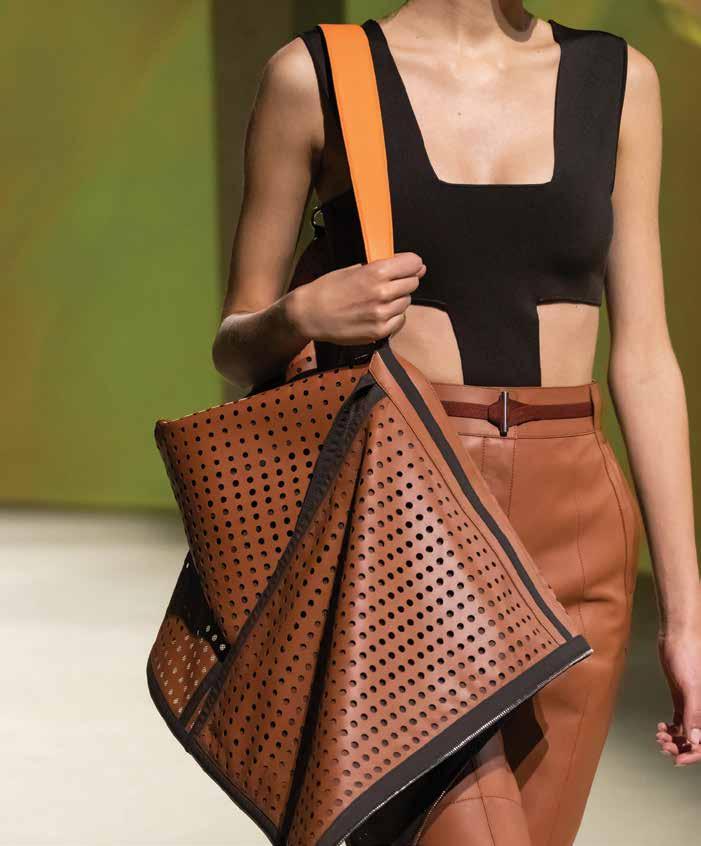
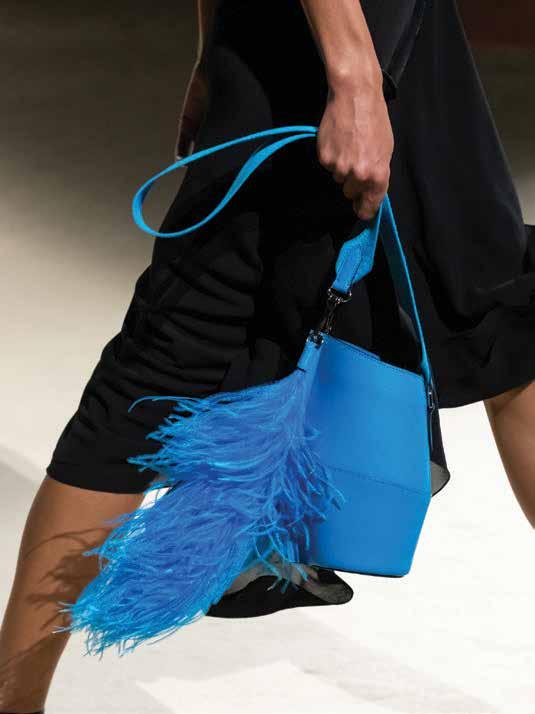

50
AIR
wing, and allowing Vanhée-Cybulski the time and space to get under the skin of the Hermès customer. This is no small undertaking, given how diverse they are, from nonagenarian scarf devotees to Cardi B and Kardashians who collect trophy Kellys and Birkins. They range from those living out their entire lives, whether on the beach or in the boardroom, cushioned by Hermès, to fashion cognoscenti who hunt down the rarer bags.
Vanhée-Cybulski’s own favourite is the Trim, an underrated shoulder bag from 1958, a forerunner of Gucci’s 1961 Hobo, which was eventually renamed the Jackie after Jackie Kennedy, who often wore it.
“I’m sure I could get into trouble for saying this, because Hermès is expensive, but it’s actually a democratic brand in terms of its philosophy,” she says. “We’re not just for a certain type of person. It’s not about being cool. It’s about this astonishing craftsmanship – it’s like being in a cult in that sense – and a sense of timelessness.” Her big conundrum when she joined was to understand how to marry permanence with the constant churn at the core of fashion’s identity. But she seems to have connected the apparent polarities. “You can respect classics, but that doesn’t mean you never do anything new,” she reasons. “I mean, the maroquinerie is very proud that its new designs account for a significant part of Hermès bag sales every year. At Hermès, however, newness has to have a purpose. “How do you want that dress to be – casual, or to go to work? How do you want it to feel? Do you want your clothes to make you look sexy?” she asks with an intensity that seems straight out of the existentialist’s playbook.
“I think lots of designers aren’t really thinking about the woman. She’s just a vehicle for their designs. I try to give a female gaze on sexy. For me, cleavage isn’t necessarily sexy. A racer back
might be sexier. I was in the street and this girl was wearing a red-and-black T-shirt and the optical effect was like she was topless. She was super covered but there was like a trompe l’oeil. That was clever. She was owning it.”
What if she wants to design, for instance, utilitarian cargo pants – how does she make that work within the luxury paradigm of Hermès without overloading it with clichéd luxe features? “Well, it’s not just about the fabric, it’s about the work and where it’s made.” For Hermès that means France, Italy, Scotland. “Also there are the details. Pockets? If so, where do they go, how do they look? It’s like a puzzle. And then there’s sustainability. For me, and the whole team, sustainability is very, very important and we’re digging very deep. It has to be a passion.” She sighs. “The truth is, the customers don’t always care. It’s up to us as a brand to make it easy for them.”
Vanhée-Cybulski didn’t set out to be a designer. The daughter of middleclass Berber-French parents (her father is a “super-altruistic doctor”), she grew up in unfashionable northeastern France, close to the Belgian border in a small town called Seclin.
At a careers fair she was seduced by journalism when the editor of a music magazine asked Vanhée, as she then was, and her two girlfriends, whether they wanted to work for him.
“That magazine featured all our favourite musicians – Blur, Pulp, Nick Cave, PJ Harvey, Tindersticks… So yes, we did.”
She seems to have had a lovely time interviewing the likes of Brian Molko of Placebo, hanging out in seedy clubs in northern France and the UK and forming a generally misty-eyed view of British culture. “We were very bluestocking,” she says. (She’s not kidding; years later, when she first met with Axel Dumas, CEO of Hermès, to discuss the job, they talked about Plato.) “But we were also pretty. A redhead, a brunette and a blonde. We were treated very nicely. I got to see people being very creative.”
Her parents hoped it was just a phase. It was. She went back to college, studied science and politics for three years, and then English because she loved the language, and then, “maybe it was because everyone was so unfashionable where I grew up, but I rebelled.” She’d been making baby clothes for years, so she enrolled at the fabled Royal Academy of Fine Art Antwerp, alma mater of Raf Simons, Ann Deumeulemeester and Dries Van Noten – an august legacy that sat heavily on her shoulders. A quiet anarchist, she decided she wasn’t going to do black – one of the college’s signatures – but colour. She says that was a difficult road, but it has paid off at Hermès, which, while not a house of strident colour statements, requires a wide palette from its designers.
Before Hermès, there were stints at Martin Margiela, Céline (where, from 2009 to 2011, her dream to live in London came true and led to her meeting her husband) and The Row, where, as head of womenswear, she had a direct line to Mary-Kate and Ashley Olsen. It’s one heck of a CV. Before our interview, I had intended to ask her how she gets into the head of a Hermès customer, but clearly she doesn’t. She gets into the head of the Hermès philosophy. “It was really like a riddle when I first came,” she says. A riddle she seems to have solved.
51
‘
We’re not just for a certain type of person. It’s not about being cool. It’s about this astonishing craftsmanship’
Credit: © Lisa Armstrong / Telegraph Media Group Limited 2023
All pages: Women’s Ready-to-Wear, SS23, by Gaspar Ruiz Lindberg and Larissa Hofmann
Six Appeal

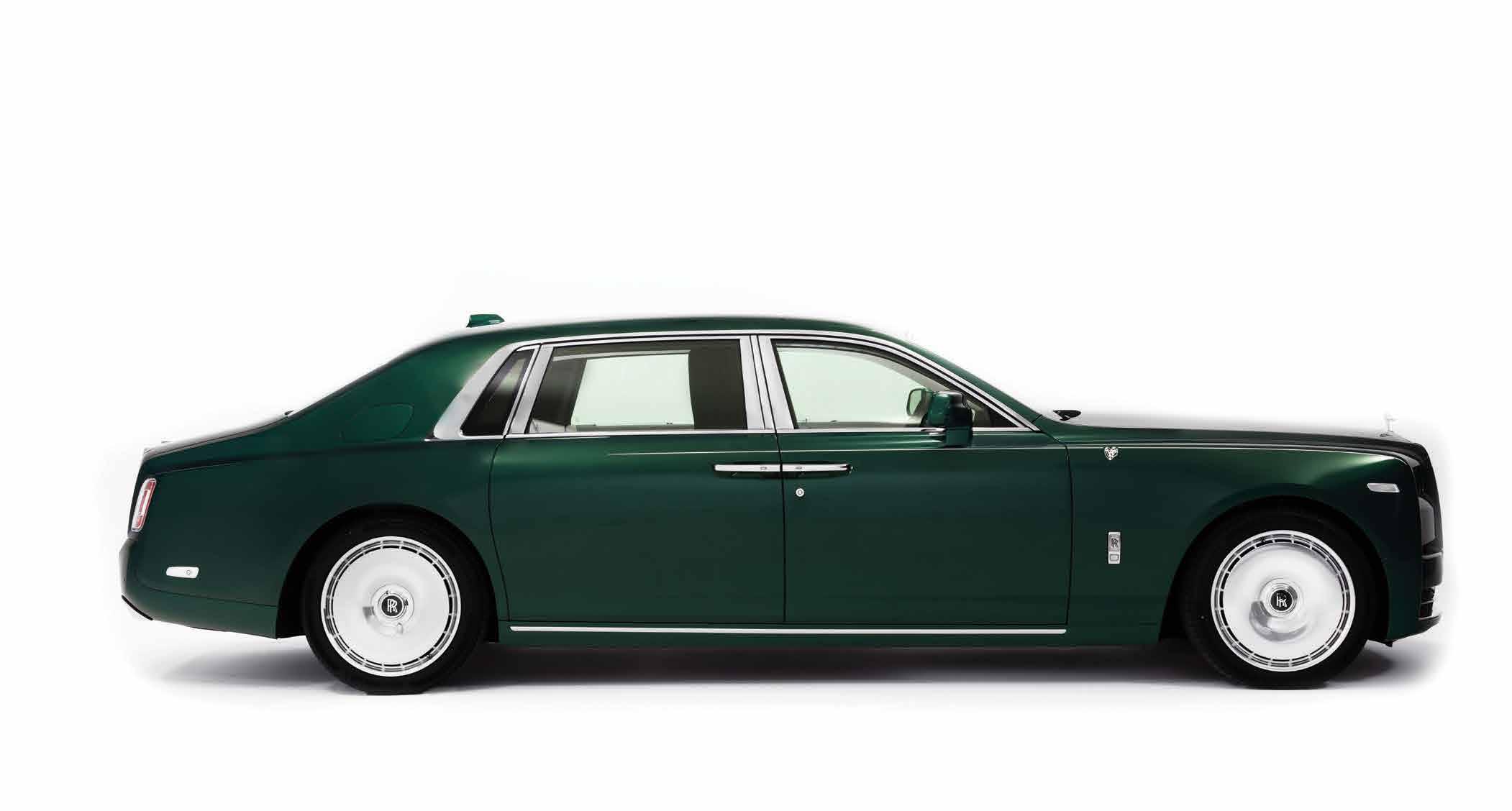
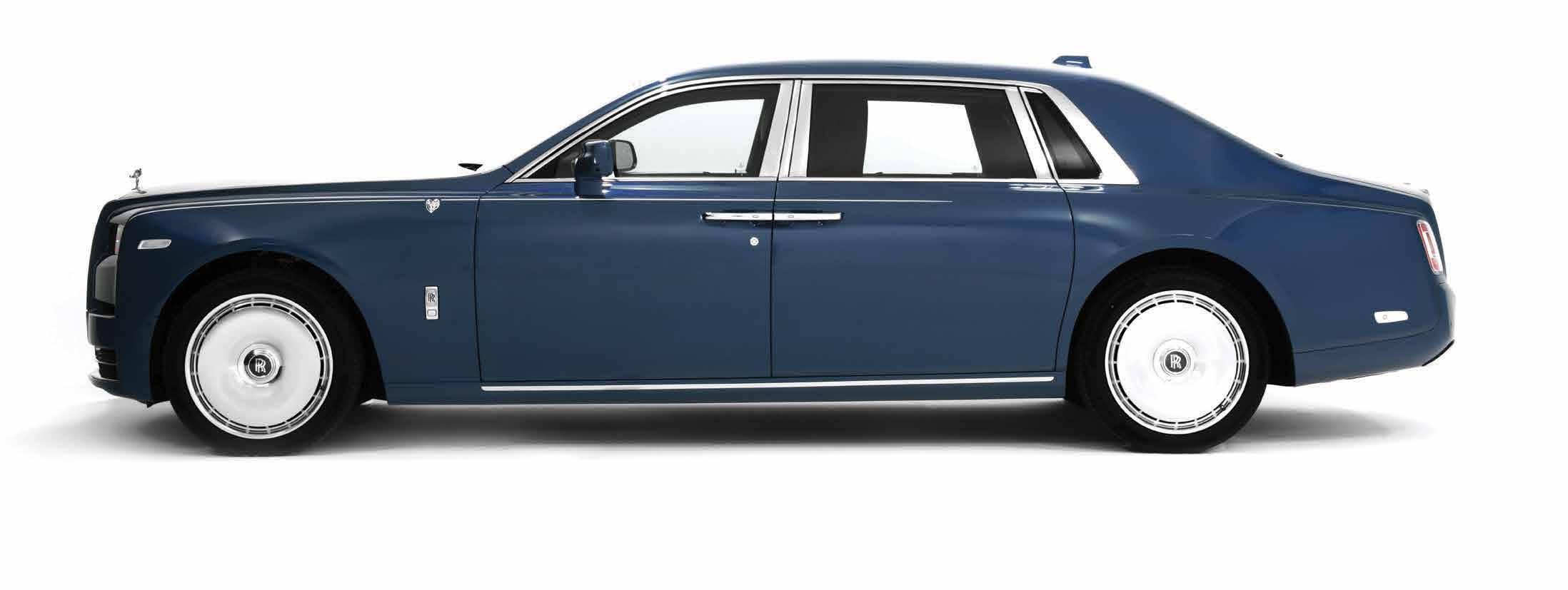 WORDS: JOHN THATCHER
WORDS: JOHN THATCHER
52
AIR
Unrivalled craftmanship meets emotional art, as Rolls-Royce and Sacha Jafri combine for a unique charity-driven project
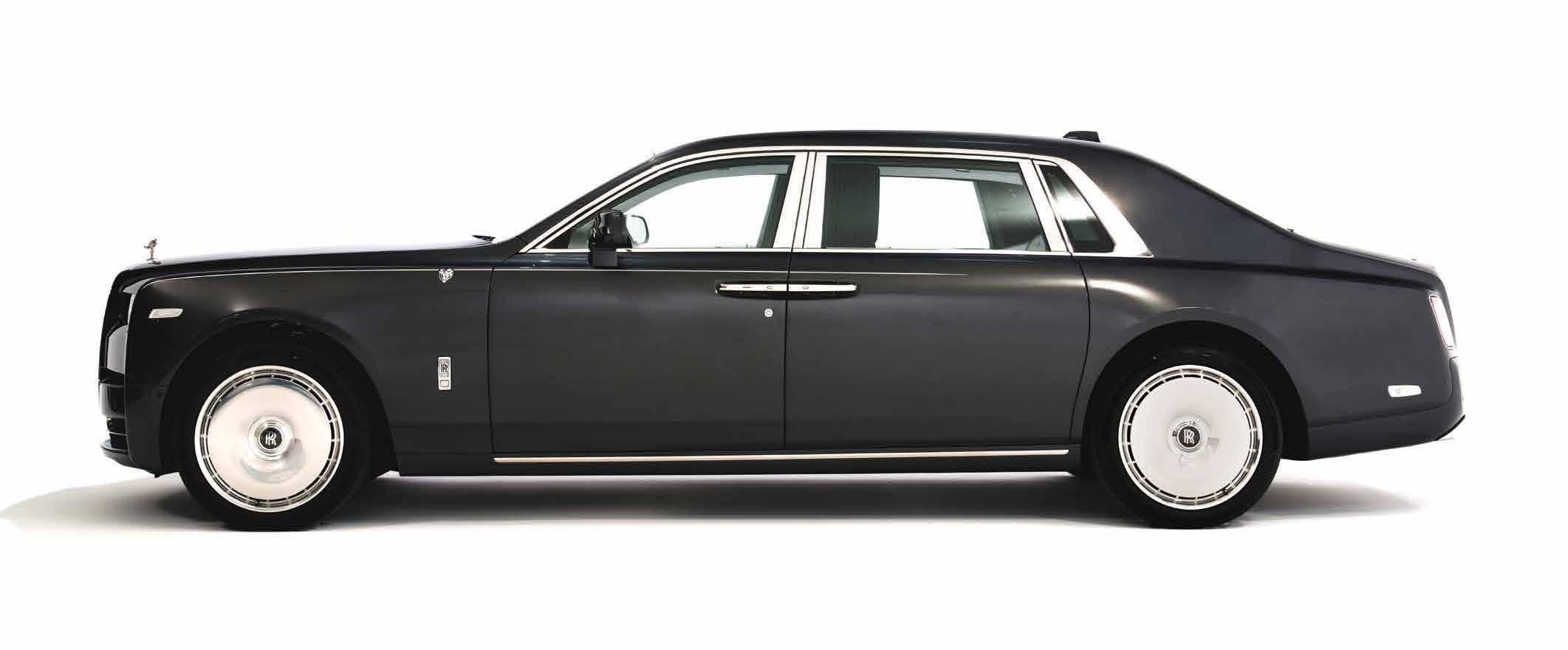

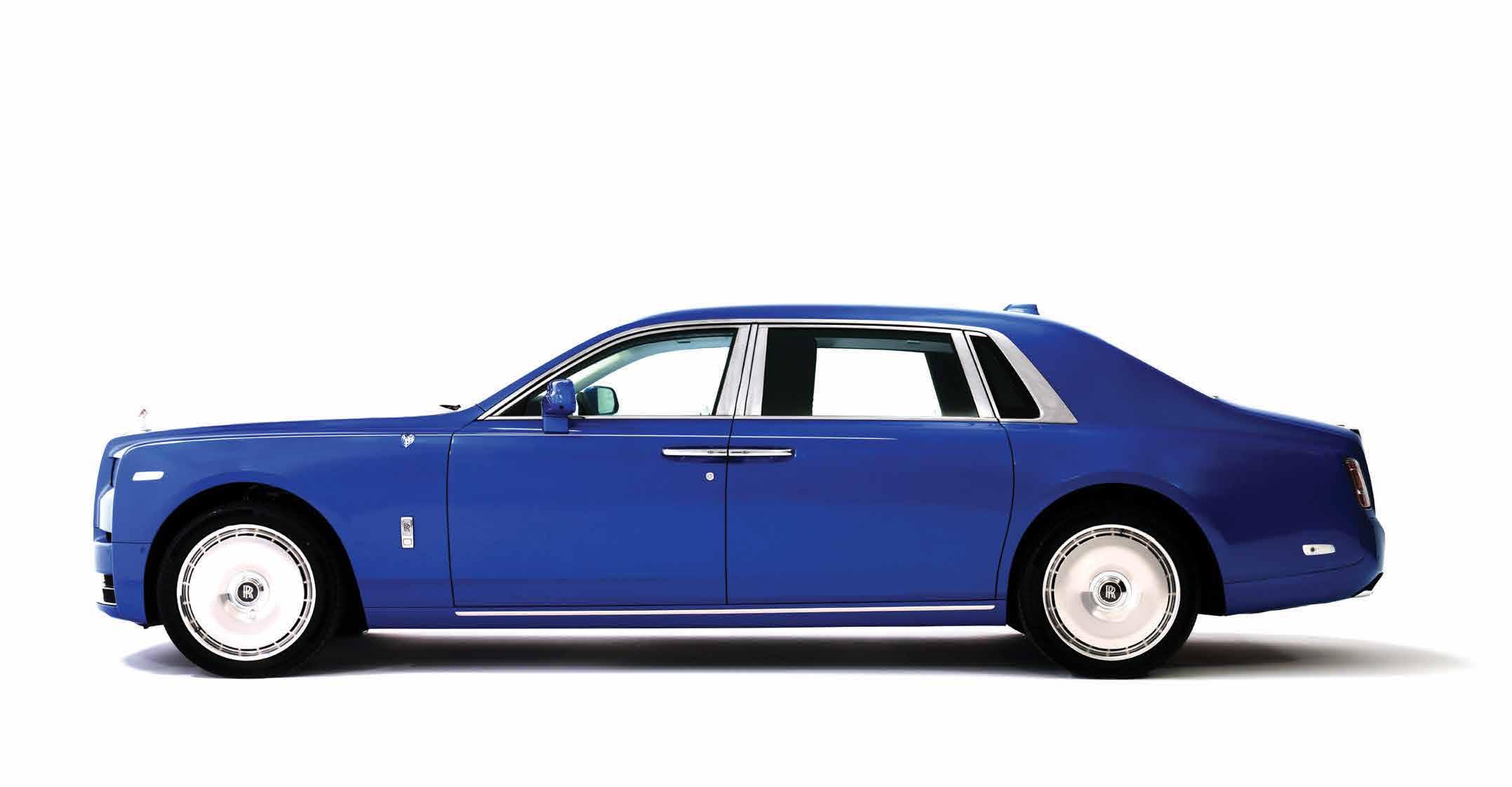
Motoring JANUARY 2023 : ISSUE 136 53
When a CEO as time poor as Rolls-Royce Motor Cars’ Torsten Müller-Ötvös schedules a flying visit to somewhere over 5,000km from the brand’s Goodwood HQ, you know it’s for something special. Something significant. The handover of six, one-of-one ‘Phantom — The Six Elements’ Series II Extended cars to their eager, hand-selected owners in Dubai last month was certainly both of those things. Special, because each of the cars was designed in collaboration with the celebrated contemporary artist Sacha Jafri, who hand-painted the Phantoms’ signature galleries to depict the five elements of water, fire, earth, wind and air, and was instrumental in the idea for a sixth, humanity. And significant because the bespoke project, which was several years in the making, raised in excess of $1 million for charities in the Middle East, India, Lebanon and South Africa.
Rolls-Royce has, of course, worked with artists on previous bespoke cars – the very reason the Phantom’s gallery was created was to showcase an artwork unique to the owner – but this is the first time an artist has collaborated on an overarching charity-driven project involving multiple cars. Naturally, it’s a project that Müller-Ötvös is immensely proud of, hence the hop to Dubai.
It’s a city and a region that continues to be of real importance to Rolls-Royce. The owners of the six Phantoms are long-standing clients of the marque and continue to purchase multiple cars. But they are not alone. Between 10-15% of Rolls-Royce’s total output ends up in the Middle East, little wonder Dubai was selected to home the brand’s first private office outside of the UK.
It’s there that Bespoke Lead Designer Michelle Lusby consults with clients on
their commissions, a process that could only have been undertaken at Goodwood previously. More ideas incubator than office, it’s where a client’s creative spark is ignited. “The best bespoke creations are coming from the Middle East,” states Müller-Ötvös, as we sit between two of the Phantom Six Elements, which are hidden from prying eyes inside an off-the-beaten track studio in Al Quoz. “People from this region have a long history of elaborately decorating their mode of transportation; think of camels fitted with patterned embroidery. It was a way of making their means of transportation beautiful. That’s the reason why there is so much creativity applied to our products in this part of the world, and why, even though they don’t have much time to spare, they devote a lot of it to sit with our designers and plan the detail. It’s remarkable.”
Naturally, the Dubai office, which only opened last summer, is proving a roaring success. “From strength to strength,” adds Müller-Ötvös.
The pandemic wrought many changes. What has been its impact on the world of bespoke? “I would say people are now even more creative, the most expressive cars coming from the Middle East. Very flamboyant, bold colour combinations, which are a perfect fit for somewhere like Dubai. There has also been a general mindset shift that has led to something of a spending spree. Our clients are now aware that life is short and should be lived to the full. I hear that from them. This idea that you shouldn’t postpone enjoyment, because nobody knows what comes tomorrow.”
The tomorrow of Rolls-Royce is clear, however. By 2030, all of its cars will be battery powered. When I ask Torsten if this move has coincided with clients asking for more sustainable options in
their cars — plant-based leathers, for example — he makes an interesting point about the car’s sustainability as a whole. “80% of the cars ever built by Rolls-Royce, dating back to its founding over a century ago, are still on the road. That’s a remarkable achievement, and it’s due to the build quality and the materials used. Buy a Rolls-Royce and you are investing in something that will not disappear in ten to fifteen years’ time. It’s a seriously sustainable product that is passed down to the next generation, particularly in the Middle East.”
The pinnacle of bespoke is coachbuild, an invite-only process that takes around four years to complete, with a coachbuild project brought to life typically every two years. “You need to be a really long-lasting client,” says Müller-Ötvös of the fortunate few. “Coachbuild really showcases what we are able to achieve in terms of engineering and craftmanship. You could even call it crazy what we are doing in this domain, because it is. It’s so detailed and magnificent. The client dictates and no compromises are made in the pursuit of perfection. Nothing.”
Müller-Ötvös has been at the helm of Rolls-Royce Motor Cars since 2010. Does he still get surprised by client requests?
“Just when you think this is something you’ve never seen before, wait two weeks and something else unique comes along. We are building the dream of the client and I’m quite touched, honestly, by the creativity that is put into our cars. The original idea comes first from the client — the colours, the materials — then our designers interview them, so that the story of their life transforms into a car. Everyone has their own story, so every car is different.”
In the world of Rolls-Royce Motor Cars, no truer words have been spoken.
54 AIR
‘ People from this region have a long history of elaborately decorating their mode of transportation’
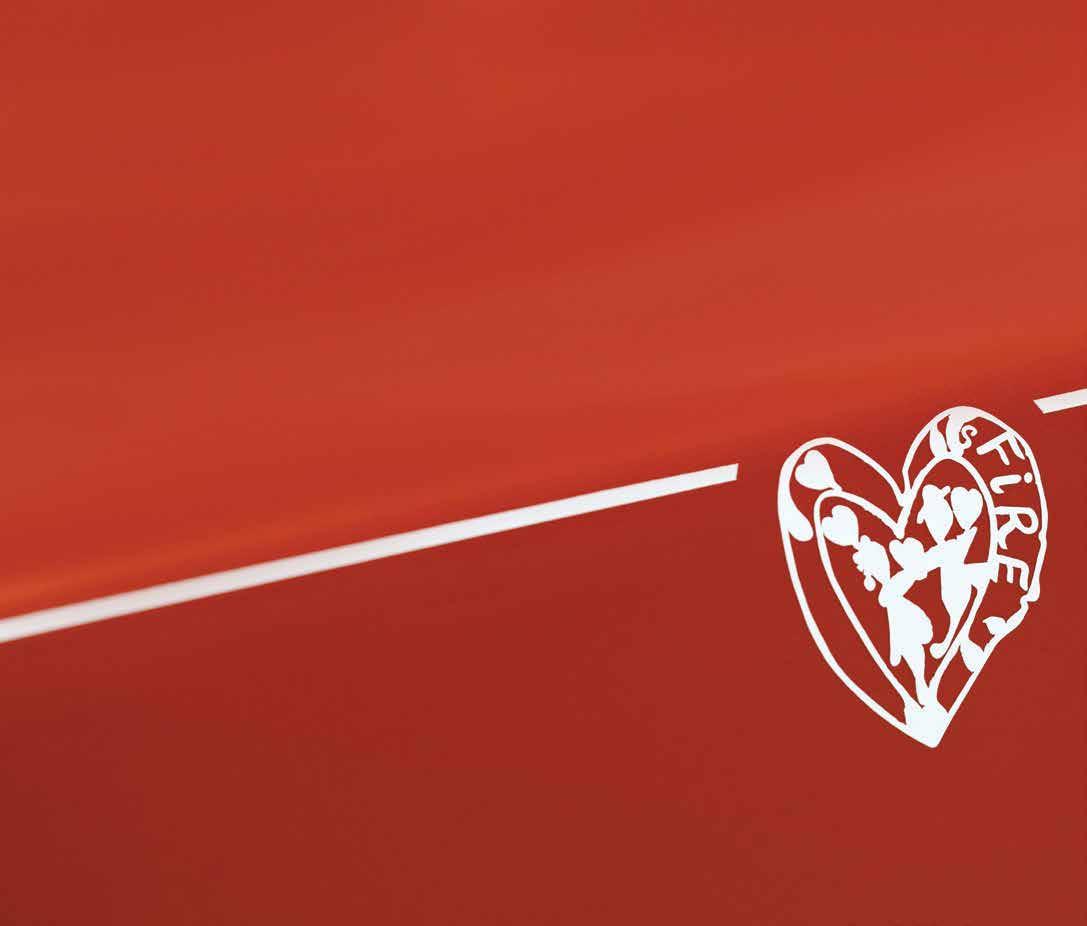
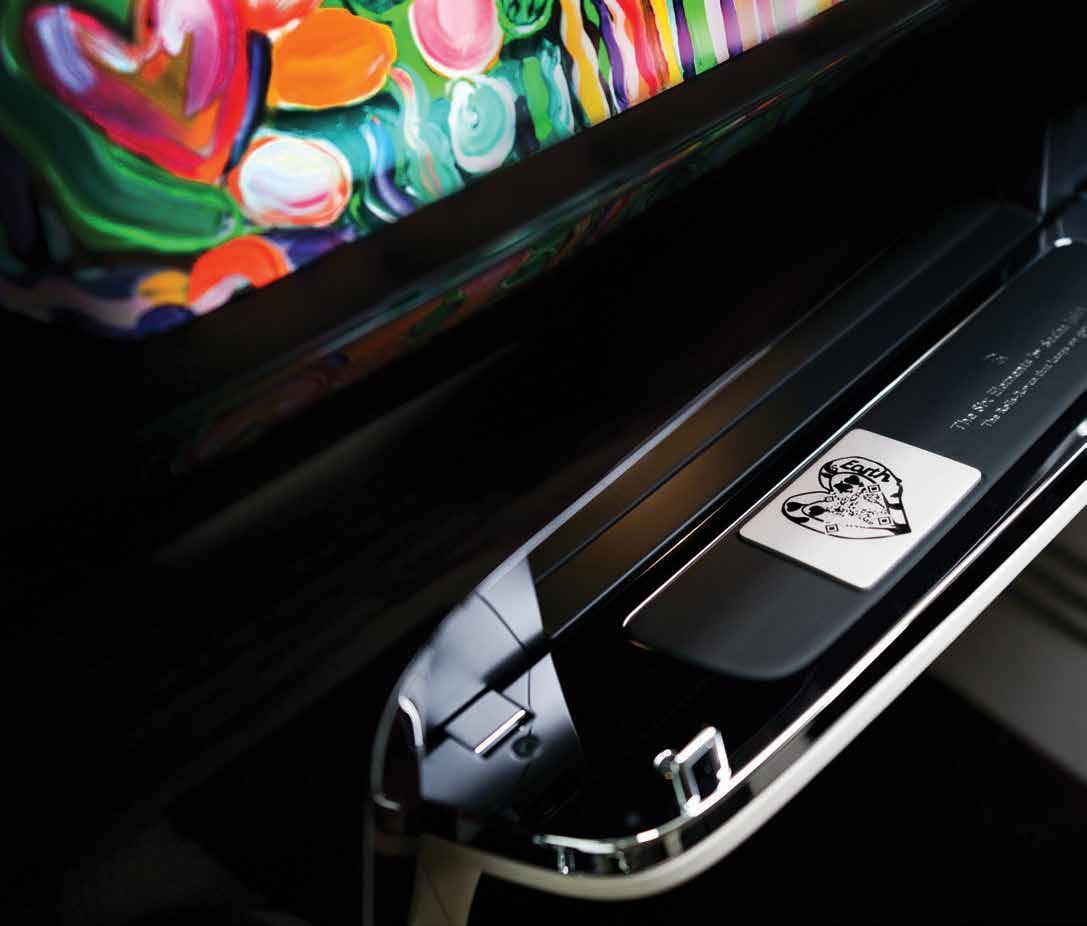



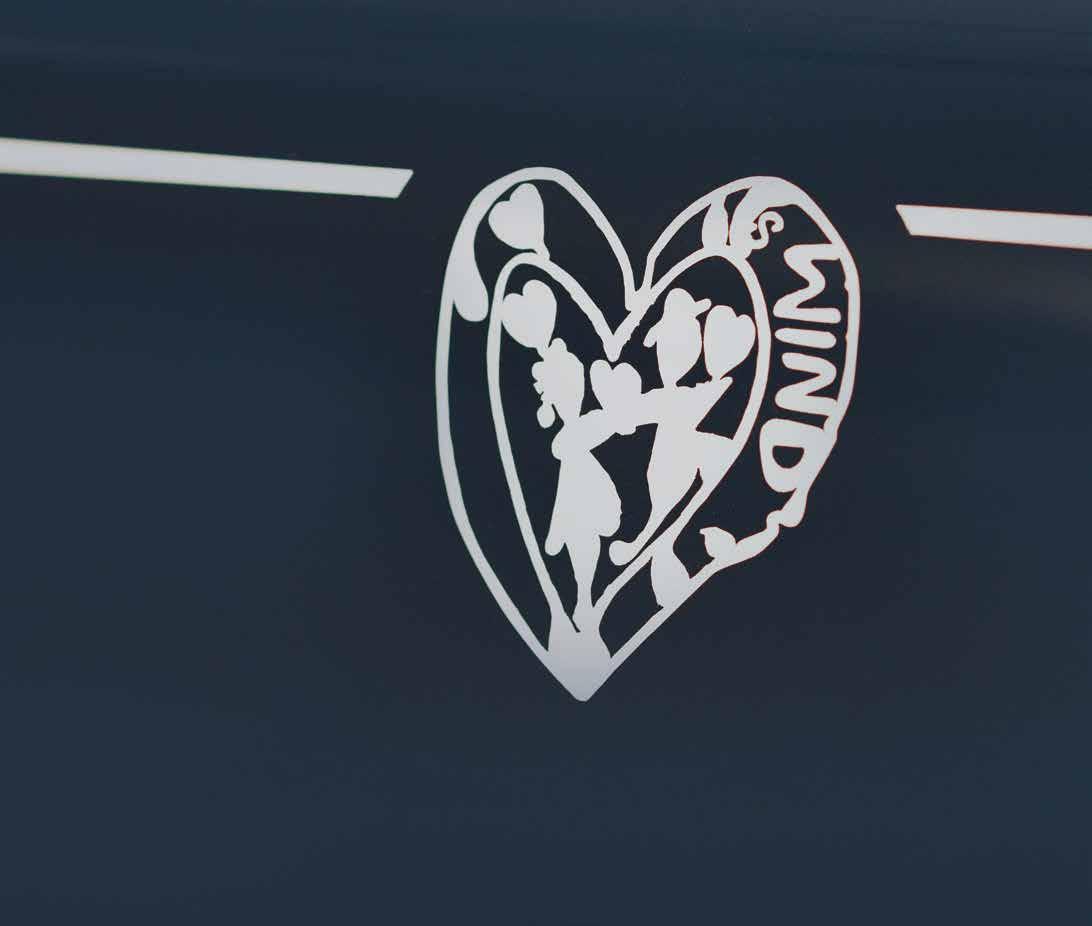
55
Mindful Eating
Sublimotion is a pop-up restaurant unlike any other you will ever eat at. AIR meets its two Michelin-starred inventor, Paco Roncero
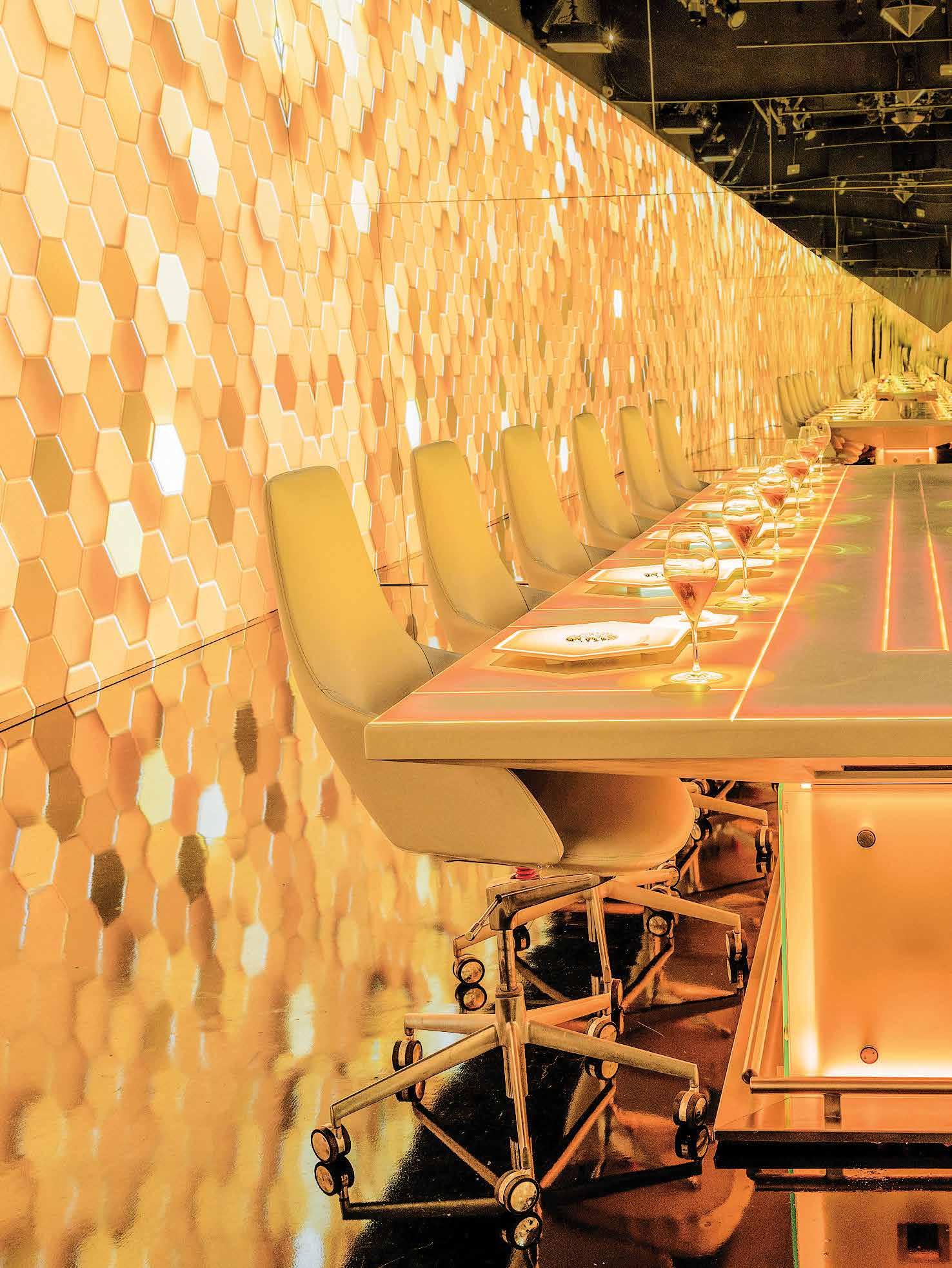 WORDS: JOHN THATCHER
WORDS: JOHN THATCHER
56
Gastronomy JANUARY 2023: ISSUE 136
AIR

AIR
The homepage of Paco Roncero’s website eschews the typical potted profile of its subject in favour of describing the chef’s personality in 37 words. Try to describe your own personality and 37 words will likely prove too generous a quota to fill, particularly via the use of only single adjectives. And yet, a valid description of Roncero’s work alone, which has thus far wriggled free from the constraints of standard definition, would likely exceed that figure. Throw in a dash of free will and a pinch of unpredictability and you have a recipe for one of the most exciting chefs of our times, however many words it takes to describe him.
Conversely, Roncero requires only a single word to describe how he hopes guests of his restaurants react to their experience. “Happiness. Our main goal, that we work hard for every day, is to make our guests happy.”
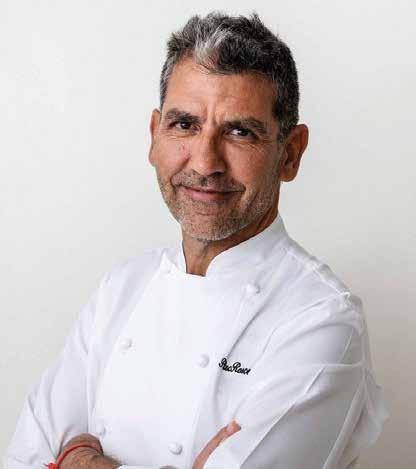
The guests of Sublimotion are certainly that, Roncero’s performance haute-cuisine show that the two Michelin-starred chef devised alongside creative director Eduardo Gonzales. It began in Ibiza in 2014 and enjoyed an extended residency at Dubai’s Mandarin Oriental Jumeira last year, to where it has returned for another six month slot.
When news of its arrival in the city hit the headlines last year, it was immediately questioned in some quarters for its Dhs5,000 per seat price tag (Dhs3,500 without alcohol). Those few dissenting voices were swiftly silenced when reviews of its 12-seat, 10-course experience (for that’s what it really is, an experience) filtered through, and this year news of its return garnered only excitement – and rightly so.

A team of chefs, designers, directors, technicians, and musicians all contribute to realise the vision of Roncero and Gonzáles, which unfolds thrillingly across three hours of everchanging imagery, ever-inventive gastronomic fare, and ever-enjoyable performances, all of it underpinned by technological wizardry and a dash of old fashioned magic.
It’s a dining experience quite unlike any other.
There was, though, the need for Roncero to refresh the experience
Opening pages:
Champagne infinity room at Sublimotion
This page, clockwise from top: Paco Roncero; performance during season two of Sublimotion
for its second season in Dubai, aware that those who dined at Sublimotion first time around would likely return for a second helping. So what did he set out to do differently? “It was clear to both my partner [Gonzáles] and I, that we wanted to create a new and unique experience this season for our guests with both new scenes and new gastronomy. We always want to surprise, even those who are returning to us. In addition, the room has also been renovated and now conveys a spectacular infinite effect.”
One thing that remains the same is the dining room’s transformation into a mock airline, Sublimotion Air, for which you’re served a far-from-normal ‘inflight’ tray of food that’s liberal with the use of gold, lobster and caviar. Each guest is handed a card imprinted with a particular city, and the table is asked to decide on which one Sublimotion Air will land at, with choices including Rio, Rome and (the highly unlikely) Frankfurt. Choice made, the room suddenly transforms to place you there; a food market set-up where chefs at a half dozen individual stalls whip up
that country’s traditional street foodstyle snacks and drinks and, in the case of Rio, a flamboyant passista performs.
They must have at least three of these country-specific set ups ready to roll out the moment the diners decide on the destination (aware that no one would want to visit Frankfurt, even virtually), which just shows the level of detail required to maintain this feeling of wonderment.
And yet, it’s almost by chance that Roncero finds himself working with food at all. “I was planning on studying biology at university, but the sensations
58
‘ We always want to surprise, even those who are returning to us’
that a visit to a family member at gastronomy school awoke in me were so different; the action in the kitchens, the uniformity of the team all working together, the noise, the smells...it was amazing, and I wanted to be a part of it. And from that day, cooking has been my passion.”
He’s indulged that passion in a number of ways, via his own restaurants, recipe books, and TV appearances, having judged both Master Chef Colombia and Top Chef Spain. He also spent a significant amount of time under the tutelage of
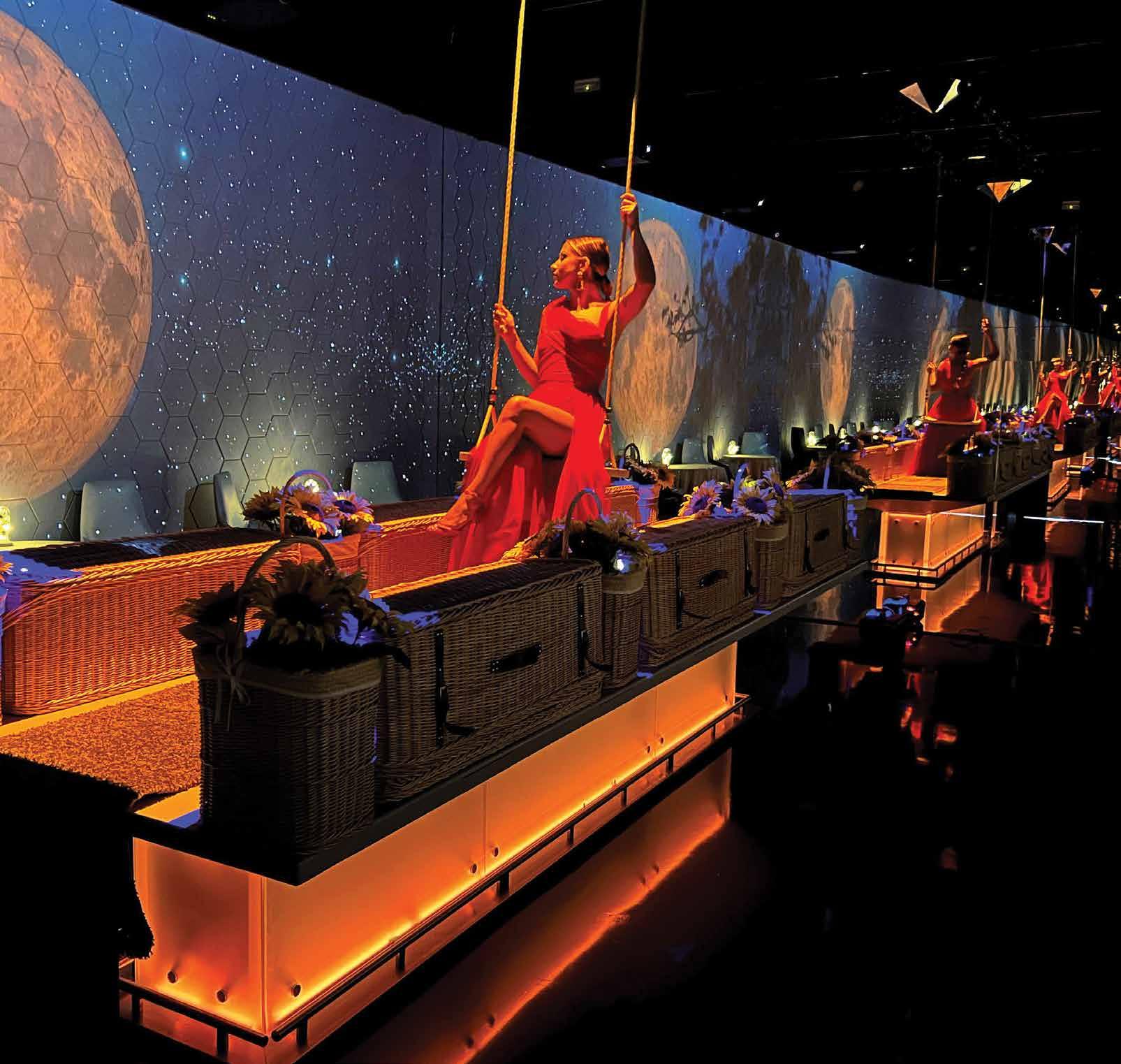
the feted Ferran Adria at the legendary El Bulli, that cradle of gastronomic innovation. “Without a doubt, Ferran changed my understanding of cuisine. Spanish gastronomy is now recognised worldwide thanks to his work.”
Now Roncero has his own hub for ideas, the Paco Roncero Workshop in Madrid. “Our goal here is to develop all gastronomic creativity, from new project ideas to new dishes and flavours,” he says. “It is equipped with the latest technology and the most special thing there is our oleoteca, which provides 60 types of
monovarietal olive oil from some very rare olives.”
For inspiration, however, Roncero looks beyond the walls of his workshop. “I get inspiration in all areas of my life; travelling the world, discovering other countries, other cultures, other traditions, other ways of doing things.”
Already mapping the future of fine dining via Sublimotion, what comes next? “With the development of new technologies the possibilities are endless.”
In the hands of Roncero, they will also prove nothing less than exhilarating.
59

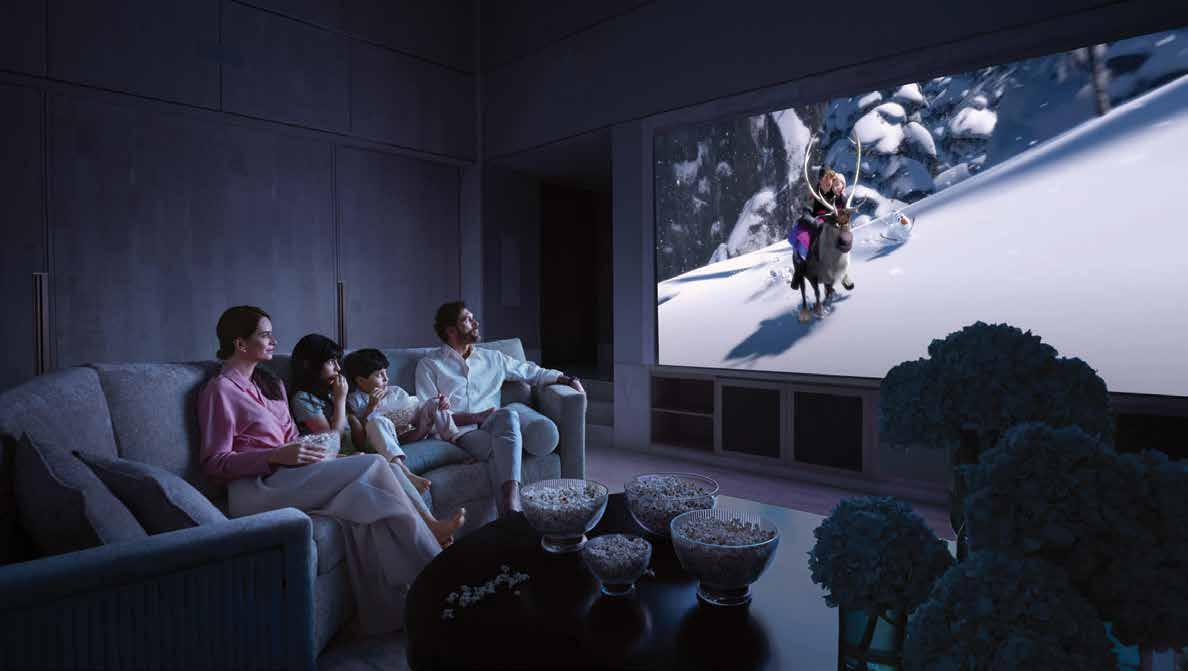
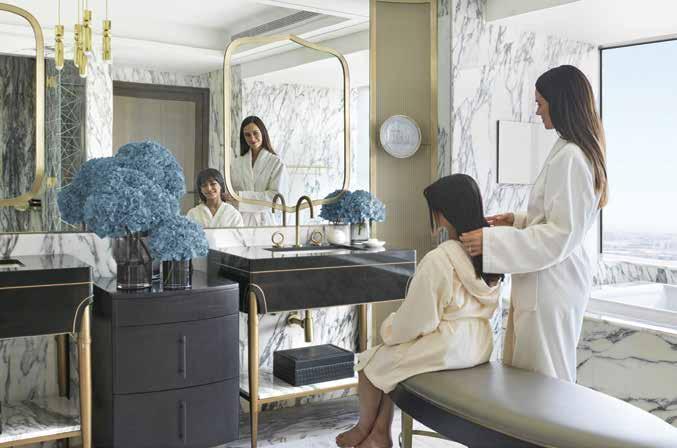
60 ULTIMATE STAYS
AIR
Four Seasons Hotel Riyadh at Kingdom Centre Saudi Arabia
The ongoing transformation of Riyadh – and, indeed, wider Saudi Arabia – continues to fascinate, with plans for mega projects defined by reason-defying architecture routinely hitting the headlines.
Slightly smaller scale but still headline stealing was the recently completed multi-million-dollar transformation of Four Seasons Hotel Riyadh. Befitting of its location within the visually striking, sky-reaching Kingdom Centre, the hotel has raised the bar for absolute luxury in a city that demands it.
This new level of opulence is singularly characterised by the two-storey Kingdom Suite, the hotel’s signature, spectacular dwelling that spans the 48th and 50th floors to create a space of some 330 square metres.
A penthouse of such scope commands equally mind-boggling features, like a Master Innovation turntable, for example. Handmade in Germany by architects of the world’s finest audio equipment at a cost of $45,000, it’s yours to use with a curated selection of equally impressive vinyl cuts, comprising the rarities Last American Hero From Asbury Park, N.J. by Bruce Springsteen, a 10-track promotional album from 1978 that was only ever released in Japan, and the original edition of Paul McCartney’s McCartney III, which is limited to just 333 copies. For movie buffs, a magnificent media room allows for screenings on a 146” modular TV, made up of 16 Samsung LEDs.
Elsewhere on your long walk through this incredible penthouse you’ll discover an array of meticulously-sourced artworks and unique Saudi artefacts, a private office, walk-in dressing areas, and a dining room that can seat ten for a dinner created by the hotel’s brigade of gifted chefs. The Kingdom Suite is, after all, the height of good taste.
As with every Four Seasons, superior levels of service come as standard, though a stay in this suite will see a personal butler attend to your every request.
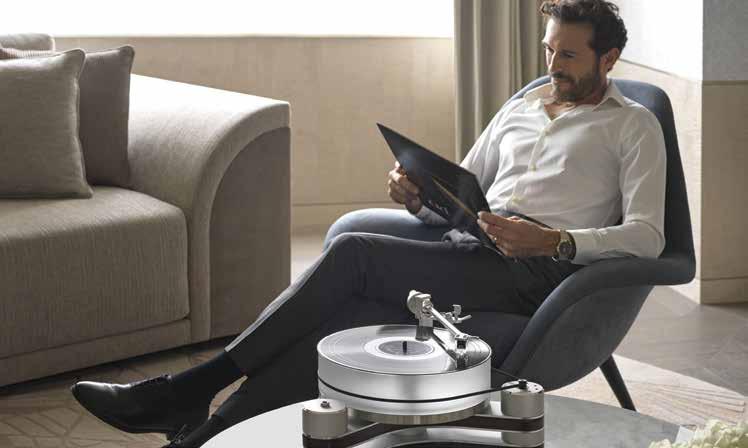
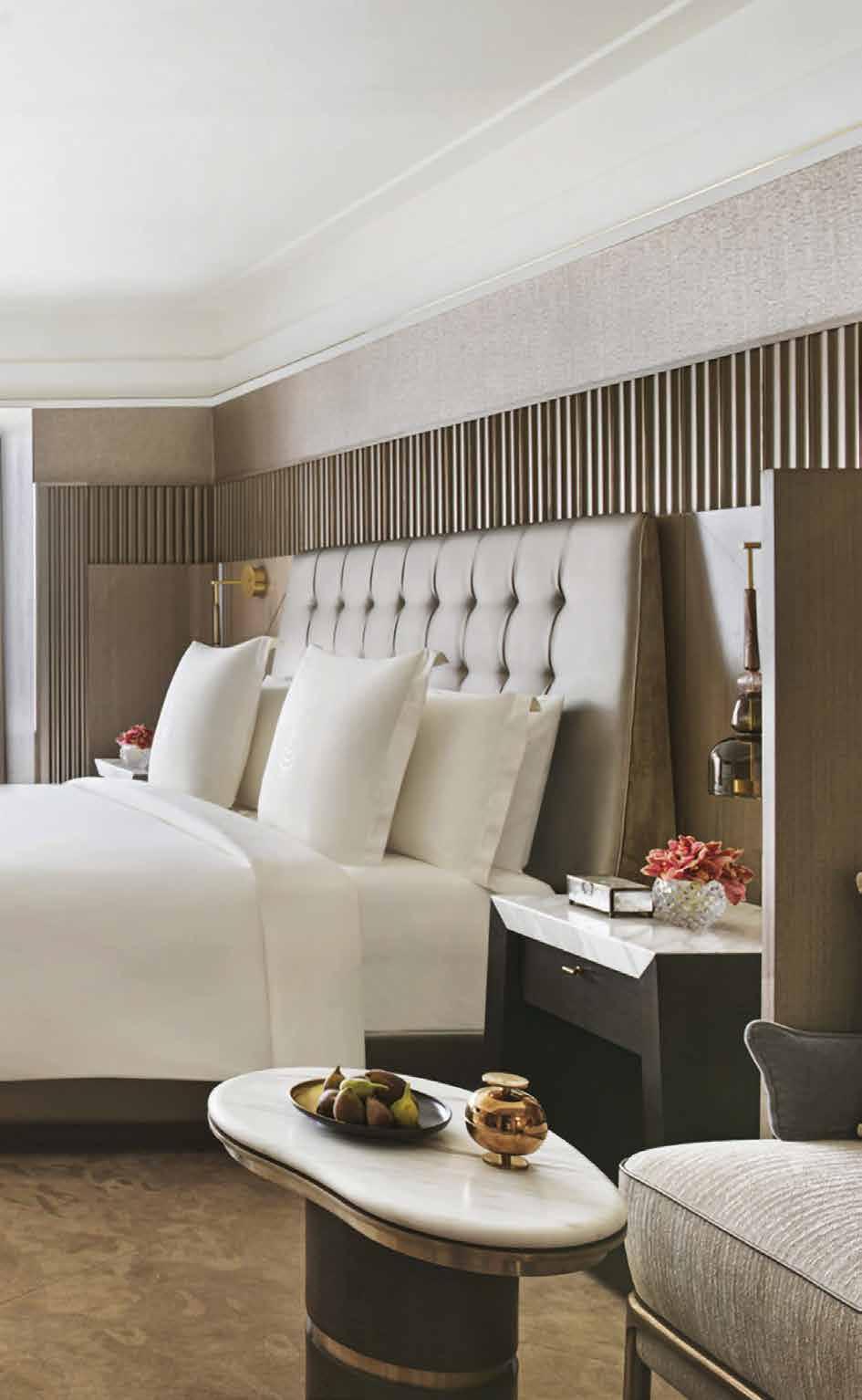
Head downstairs to the hotel’s calming spa and you’ll enter a world of wellness and refined relaxation. Spend time pre-treatment in the steam room, sauna, Jacuzzi and cold plunge pool, readying your body for the likes of a traditional Moroccan hammam or hot lava shells massage, each shell filled with natural self-heating gel. There is also an arm-length list of treatments tailored specifically to men.
An inviting outdoor pool awaits afterwards, where you’ll be served poolside from a menu of enticing light bites (tuna tataki toast; turmeric spiced chicken) and vitamin-packed drinks.
The Kingdom Centre was built to dominate Riyadh’s skyline. High up inside it at the Four Seasons Hotel Riyadh, the Kingdom Suite rules the roost of luxury abodes, both in Riyadh and far beyond.
61 Travel JANUARY 2023: ISSUE 136

62
AIR
The High Life
Everything new in the Big Apple tends to be a Big Deal. Yet since its opening last August the Aman New York has also swiftly proved itself the Real Deal.

It had big shoes to fill. Occupying the former Crown Building on the corner of 57th Street and Fifth Avenue – which was designed by the same architects whose vision created Manhattan’s iconic Grand Central Station and was the city’s tallest when it was erected back in 1921 – it took time and a budget north of $1 billion to transform into its urban sanctuary self of today, although the man responsible, Jean Michel Gathy of Denniston, was intent on marrying Aman’s renowned aesthetic to the building’s original architectural grandeur.
In striking that balance, Aman New York is a hotel that feels both historic and modern, very much the calming sanctuary in a city that’s quite the opposite.
You get a great sense of this inside your suite (it’s all suites here), when you peer down at the bustling streets below to where people scurry, car horns blare and police car sirens wail with the regularity of a ticking clock. Cocooned in your spacious (a word you would not readily associate with New York hotel rooms) suite, you could hear a pin drop. And if you did drop a pin, it’s likely someone would swoop in to scoop it up for you. I left my sunglasses in the room, returning a short time later to find that they had been cleaned. Service is exceptional.
The suites – 83 in total, in various categories and sizes – are open plan-style minimalism at its finest, with a further nod to Japan in the form of a large-scale mural inspired by the 15th-century work (and designated Japanese National Treasure) Pine Trees by Hasegawa Tōhaku. Each suite also features an abundance of automated technology (convenience very much at your fingertips) and a working fireplace, a first for New York City. Cosy.
You’d expect Aman to save some splendour for its spa, and it does so here – a whole three floors of it to be precise. Tranquillity abounds where the offering of ancient and cutting-edge practices and fully customised wellness solutions are overseen by a team headed by a Harvard-trained physician. For simple relaxation, you’ll find nowhere in New York (or beyond, for that matter) to rival the two Spa Houses. Available to book for a half or full day, this outsized sanctuary is akin to having your own spa: steam room, sauna, double treatment room, a living area with a fireplace, and a private outdoor terrace replete with a hot bath and cold-plunge pool.
A stint in it sets you up perfectly to enjoy the hotel’s other charms, which include a prohibition era-inspired Jazz Club, of which the creative director is a six-time Grammy Award nominee, and the outstanding omakase (created daily around the finest available ingredients) served to just seven guests at signature restaurant Nama.
In keeping with the history of the building, this is New York luxury elevated to a whole new level.
63 Travel JANUARY 2023: ISSUE 136
It’s still in its infancy, but there’s little doubting Aman New York is a cut above its Manhattan rivals
Marina Raphael
FASHION DESIGNER
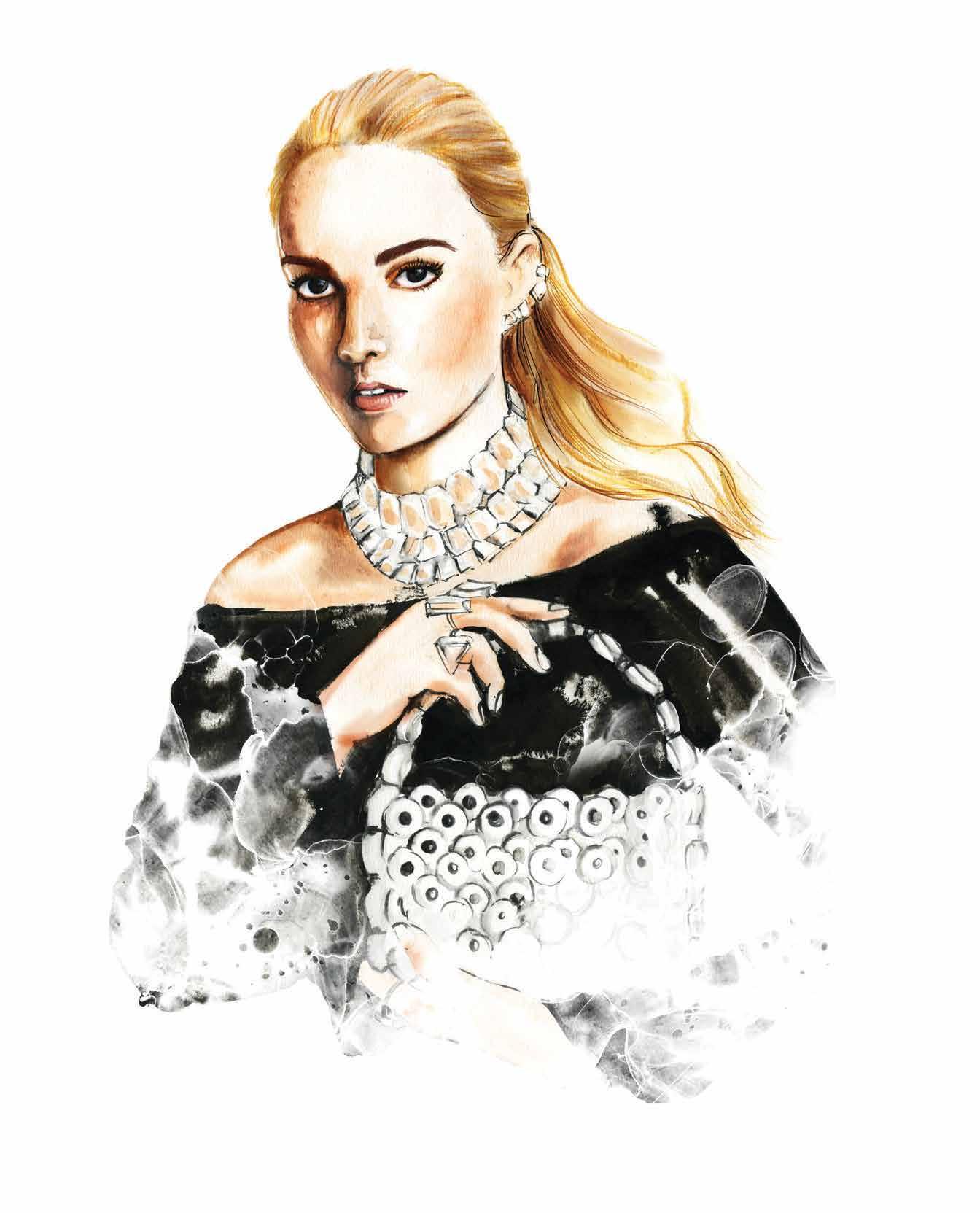
A piece of advice that I found very helpful when I launched my own brand was to stay driven, passionate and true to your brand’s core values. I truly believe that being persistent and hardworking is the key to accomplishing all your goals and future aspirations. But it is also important to have a very clear idea of what your brand stands for. You cannot lose this, even for a second, if you want to build an impactful brand that is here to stay.
You can’t please everyone. Creating something that speaks to everyone is something that was important to me from the start. So, in the beginning when I first launched my brand, I thought that the best way to achieve this was to get feedback from as many people as possible. However, I quickly understood that while feedback is extremely important, it should not be the main steering force of my
creative vision, and that I should look at every opinion under my own creative lens.
I’ve always had an innate passion for exploration, and my travels are the main source of inspiration when it comes to my designs. I am always in awe of the wonders the natural world and different cultures bestow. I find myself often mesmerised by everything around me, from breathtaking architecture to natural and unique landscapes. You can see my love of architecture come through in the strong and clean lines of my designs, especially the Riviera.
Personal success to me is waking up each morning and being excited to go to work. The reason why I love what I do is because my job allows me to channel my drive, ambition and creativity into physical objects, bringing my own
point of view to the fashion industry.
I would advise my younger self to not worry so much and to enjoy all aspects of being an entrepreneur – even the bad ones – and be really proud of what you are achieving everyday. There will always be solutions to obstacles, so staying positive, clear headed, and relaxed is the best way to stay sane and succeed.
My goal is that we build an accessories empire; expanding the Marina Raphael universe and taking the next steps to grow the business. I really look forward to opening my own flagship store and expanding our existing product line, without of course compromising our work culture and the quality of our bags. Soon we will be launching our very own line of leather accessories and cosmetic pouches.
What I Know Now 64 JANUARY 2023 : ISSUE 136 AIR
Illustration: Leona Beth

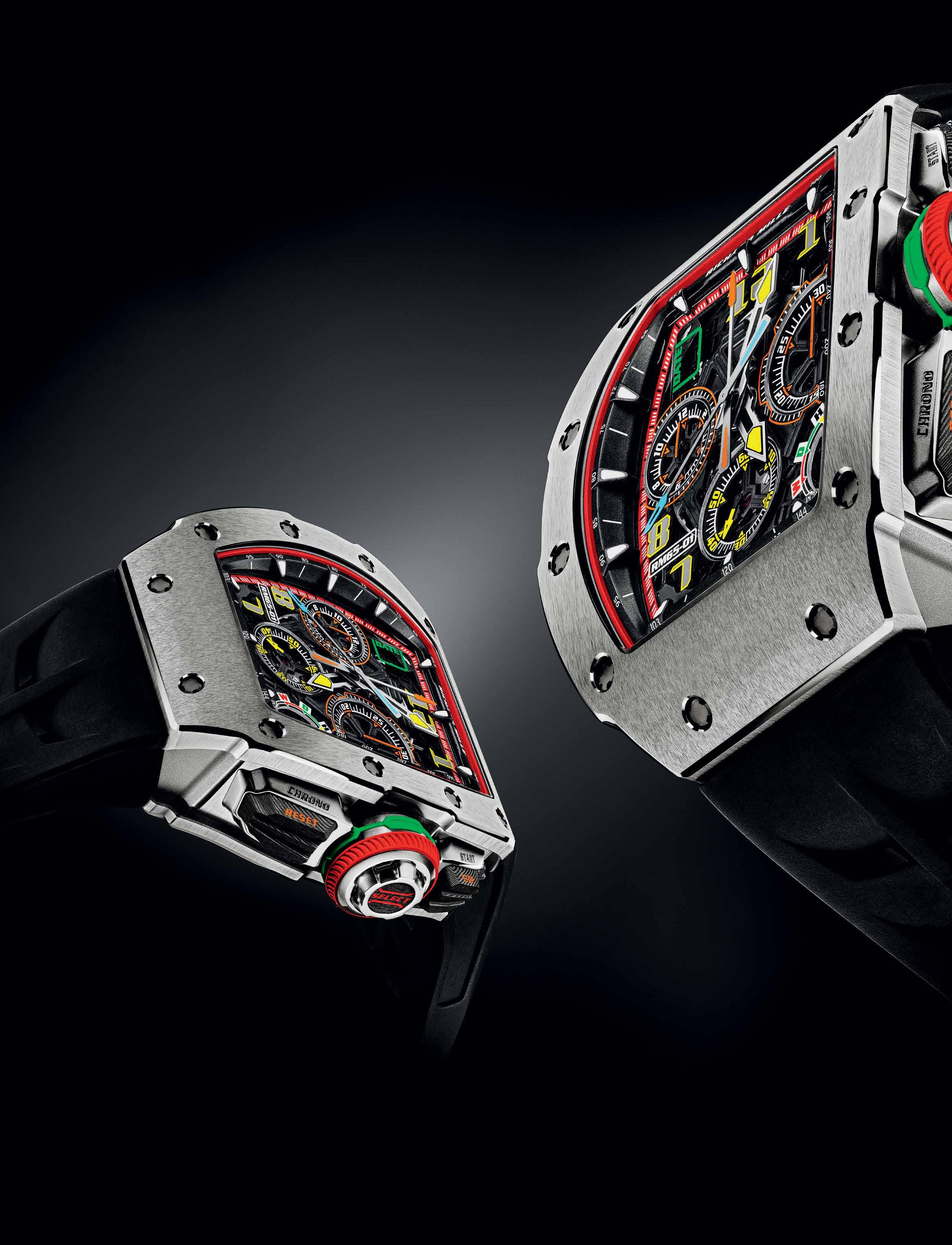
RM 65-01 Skeletonised automatic winding calibre 60-hour power reserve (± 10%) Baseplate and bridges in grade 5 titanium Split-seconds chronograph Function selector and rapid winding mechanism Variable-geometry rotor Case in grade 5 titanium A Racing Machine On The Wrist





























































 WORDS: STEPHEN DOIG
WORDS: STEPHEN DOIG































































 WORDS: JOHN THATCHER
WORDS: JOHN THATCHER









 WORDS: JOHN THATCHER
WORDS: JOHN THATCHER













